

Updated: 5 January 2024
Planets and Comets
Transit of Mercury, 9 November 2006
Sunrise on November 9 occurred at 4.54 am. Soon after, starting at 5.19 am, Mercury was visible through the telescope as a black dot moving across the Sun’s disc. This 'transit of Mercury' lasted until 10.12 am. These transits are quite rare, and the next one will occur on 9 May, 2016. Unfortunately, the next five transits of Mercury will not be visible from Australia, and we will have to wait for 46 years to see the next one from Nambour. The November 9 event occurred on a cloudy morning with some rain, but despite the weather, the following images were captured at Starfield Observatory:
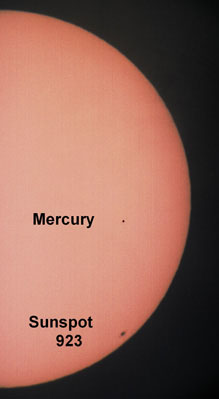

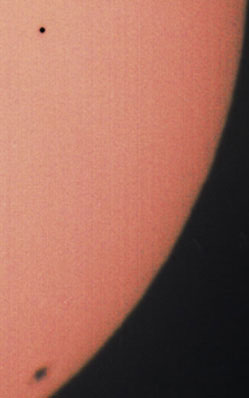
Phases of Venus
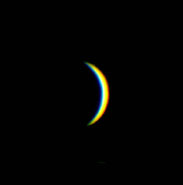
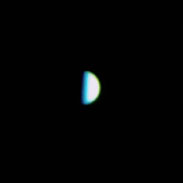
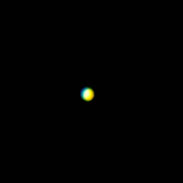
April 2017 June 2017 December 2017
Mars near the 2016 opposition
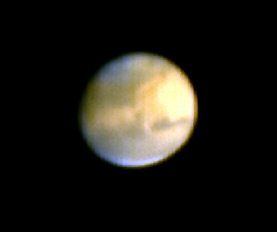

Mars
photographed from Starfield Observatory, Nambour on June 29 and July 9, 2016, showing two
different
sides of the planet. The north polar cap is prominent.
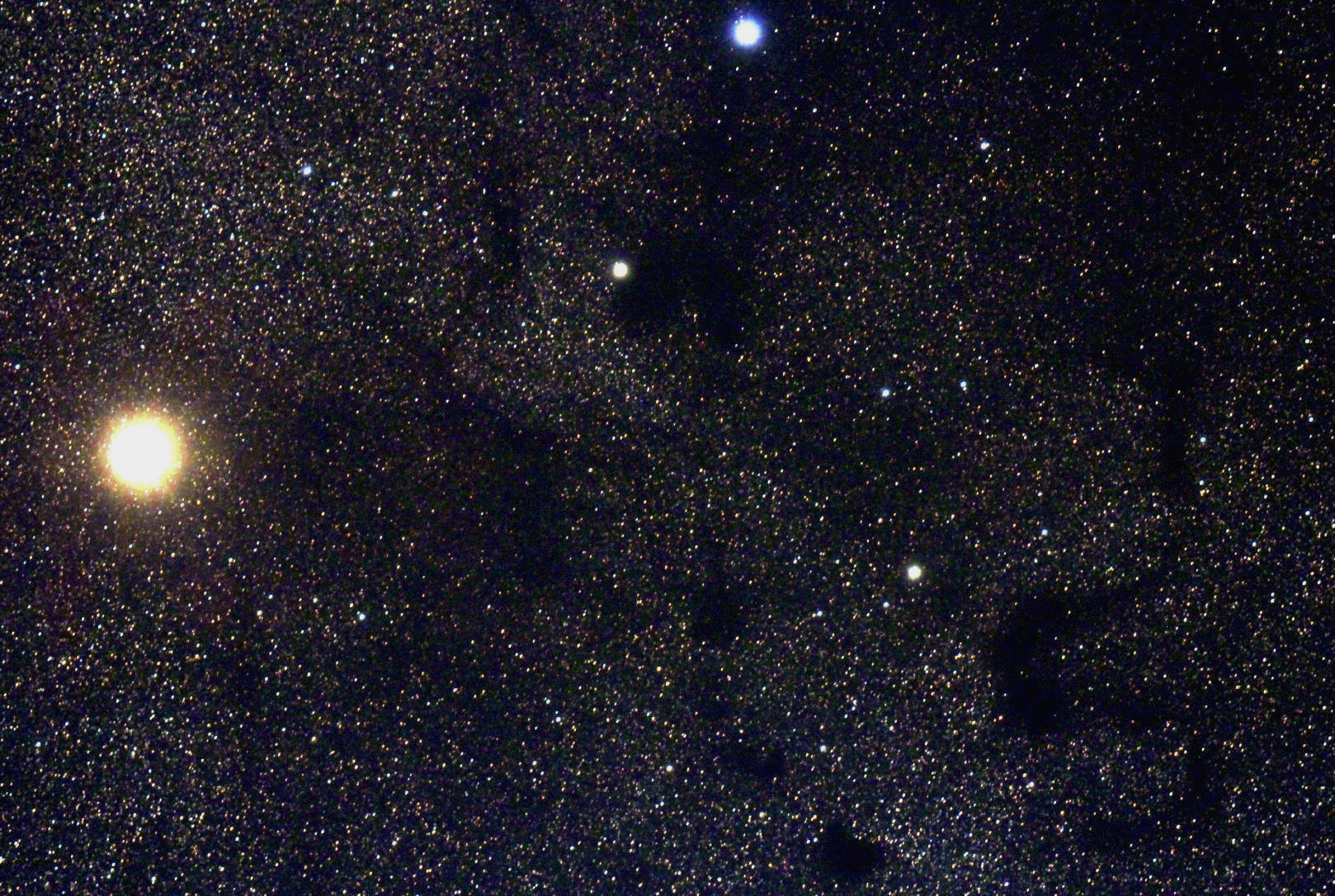
Brilliant
Mars at left, shining at magnitude 0.9, passes in front of the dark molecular clouds in
Sagittarius
on October 15, 2014. At the top margin is the white fourth magnitude
star 44 Ophiuchi. Its type is A3 IV:m.
Below it and to the left is another star,
less bright and orange in colour. This is the sixth magnitude star
SAO 185374,
and its type is K0 III. To the right (north) of this star is a dark molecular
cloud named B74.
A line of more dark clouds wends its way down through the image
to a small, extremely dense cloud, B68,
just right of centre at the bottom
margin. In the lower right-hand corner is a long dark cloud shaped like a figure
5.
This is the Snake Nebula, B72. Above the Snake is a larger cloud, B77.
These
dark clouds were discovered by Edward Emerson Barnard at Mount Wilson in 1905.
He catalogued
370 of them, hence the initial 'B'. The bright centre of our
Galaxy is behind these dark clouds, and is hidden
from view. If the clouds were
not there, the galactic centre would be so bright that it would turn night into
day.
Jupiter near opposition in 2017
Jupiter as
photographed from Nambour on the evening of April 25, 2017. The images were
taken, from left

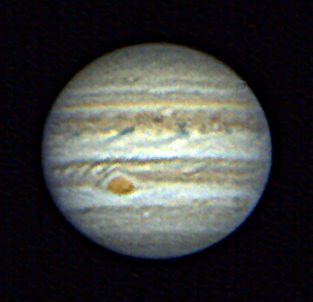

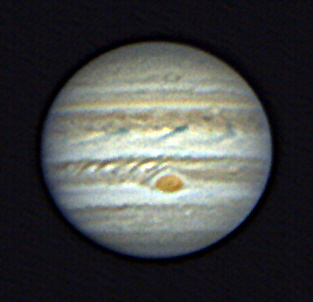

to right, at 9:10, 9:23, 9:49, 10:06 and 10:37 pm. The rapid
rotation of this giant planet in a little under 10
hours is clearly seen. In the
southern hemisphere, the Great Red Spot (bigger than the Earth) is prominent,
sitting within a 'bay' in the South Tropical Belt. South of it is one of the
numerous White Spots. All of these
are features in the cloud tops of Jupiter's
atmosphere.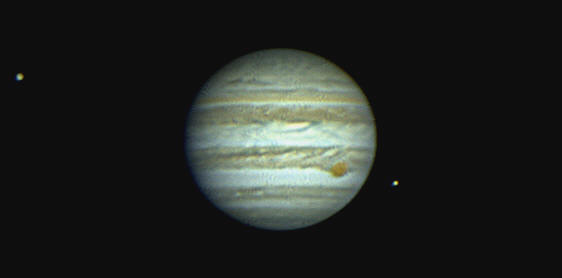
Jupiter as it appeared at 7:29 pm on July 2, 2017. The Great Red Spot is in a
similar position near Jupiter's
eastern limb (edge) as in the fifth picture in
the series above. It will be seen that in the past two months
the position of
the Spot has drifted when compared with the festoons in the Equatorial Belt, so
must rotate
around the planet at a slower rate. In fact, the Belt enclosing the
Great Red Spot rotates around the planet
in 9 hours 55 minutes, and the
Equatorial Belt takes five minutes less. This high rate of rotation has made
the
planet quite oblate. The prominent 'bay' around the Red Spot in the five earlier
images appears to be
disappearing, and a darker streak along the northern edge
of the South Tropical Belt is moving south.
Two new white spots have developed
in the South Temperate Belt, west of the Red Spot. The five upper
images were taken near opposition, when the Sun was directly behind the Earth and
illuminating all of
Jupiter's disc evenly. The July 2 image was taken just four
days before Eastern Quadrature, when the
angle from the Sun to Jupiter and back
to the Earth was at its maximum size. This angle means that
we see a tiny amount
of Jupiter's dark side, the shadow being visible around the limb of the planet
on
the left-hand side, whereas the right-hand limb is clear and sharp. Three of
Jupiter's Galilean satellites
are visible, Ganymede to the left and Europa to
the right. The satellite Io can be detected in a transit of
Jupiter, sitting in
front of the North Tropical Belt, just to the left of its centre.
Jupiter at opposition
on May 9, 2018
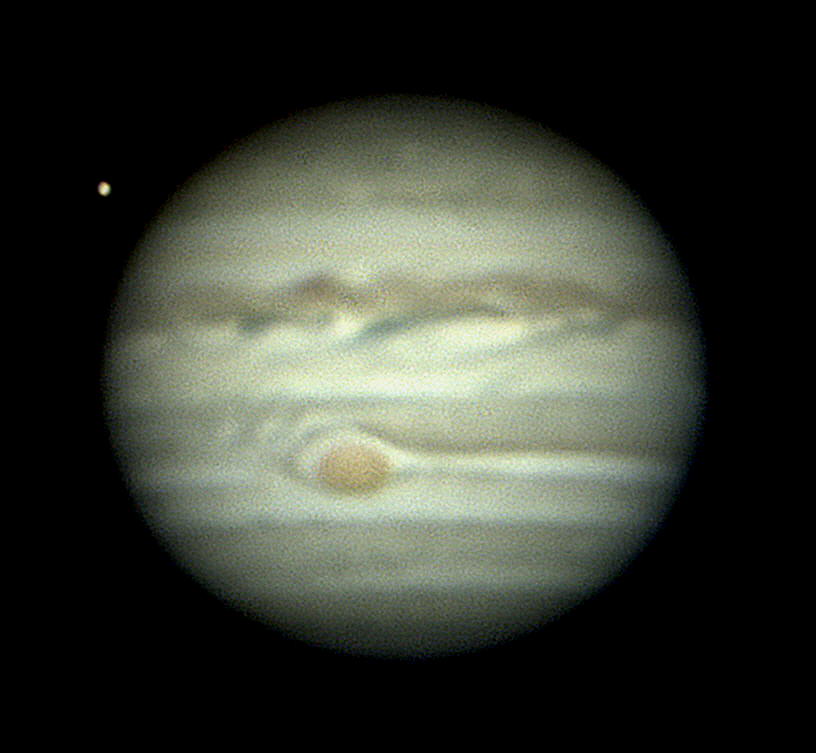
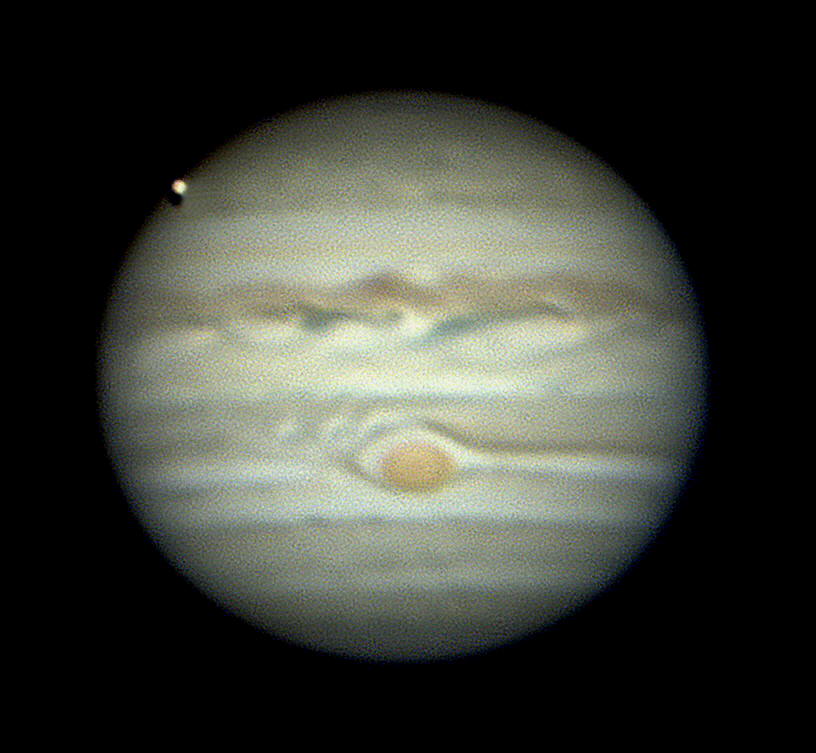
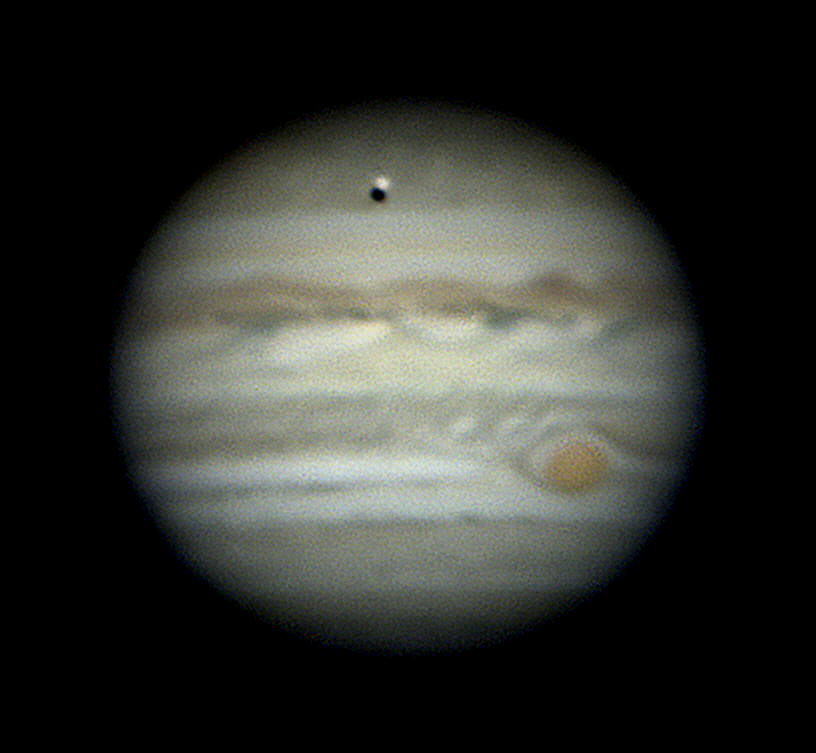
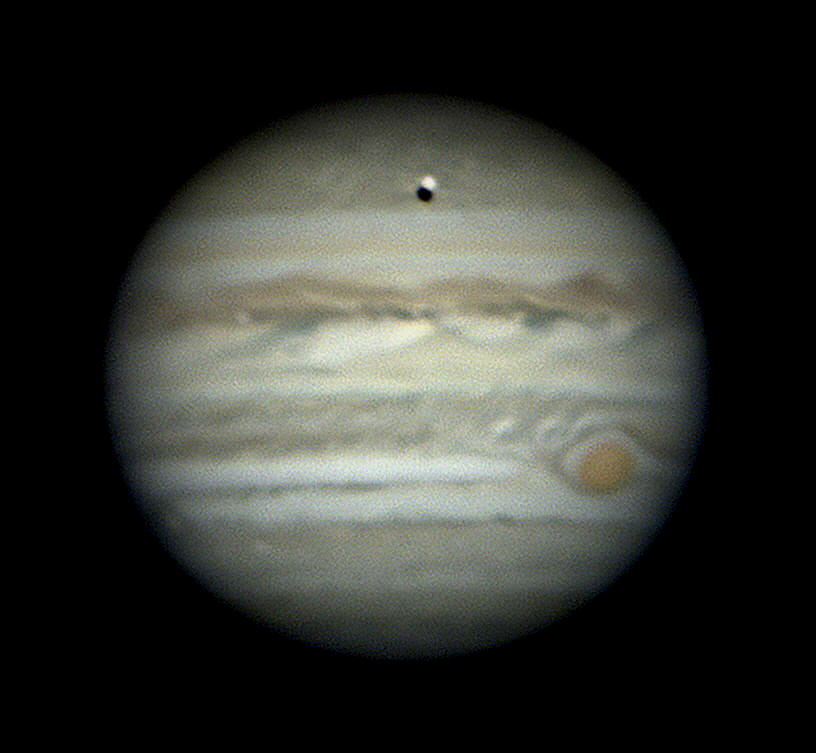
Jupiter reached opposition on May 9, 2018 at 10:21 hrs, and the above photographs were
taken that evening,
some ten to twelve hours later. The first image above was
taken at 9:03 pm, when the Great Red Spot was
approaching Jupiter's central
meridian and the satellite Europa was preparing to transit Jupiter's disc.
Europa's transit began at 9:22 pm, one minute after its shadow had touched
Jupiter's cloud tops. The second
photograph was taken three minutes later at 9:25
pm, with the Great Red Spot very close to Jupiter's central meridian.
The third photograph was taken at 10:20 pm, when Europa was approaching
Jupiter's central meridian.
Its dark shadow is behind it, slightly below, on the
clouds of the North Temperate Belt. The shadow is partially
eclipsed by Europa itself. The fourth
photograph at 10:34 pm shows Europa and its shadow well past the
central meridian. Europa is
the smallest of the Galilean satellites, and has a diameter of 3120 kilometres.
It is ice-covered, which accounts for its brightness and whitish colour.
Jupiter's elevation above the horizon
for the four photographs in order was 50º,
55º, 66º and 71º. As the evening progressed, the air temperature
dropped a
little and the planet gained altitude. The 'seeing' improved slightly, from Antoniadi IV to Antoniadi III.
At the time of the photographs, Europa's angular diameter
was 1.57 arcseconds. Part of the final
photograph is enlarged below.

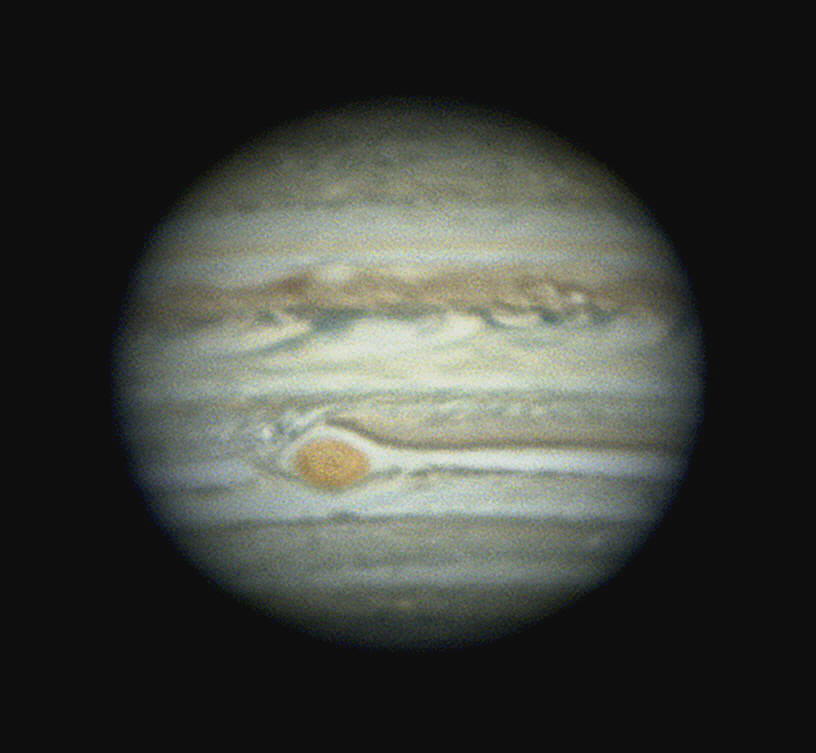
Jupiter at 11:34 pm on May 18, ten days later. Changes in the rotating cloud
patterns are apparent,
Jupiter at opposition on June 11, 2019
as some cloud bands rotate faster than others and
interact. Compare with the first photograph in
the line of four taken on May 9.
The Great Red Spot is ploughing a furrow through the clouds of the
South
Tropical Belt, and is pushing up a turbulent bow wave.
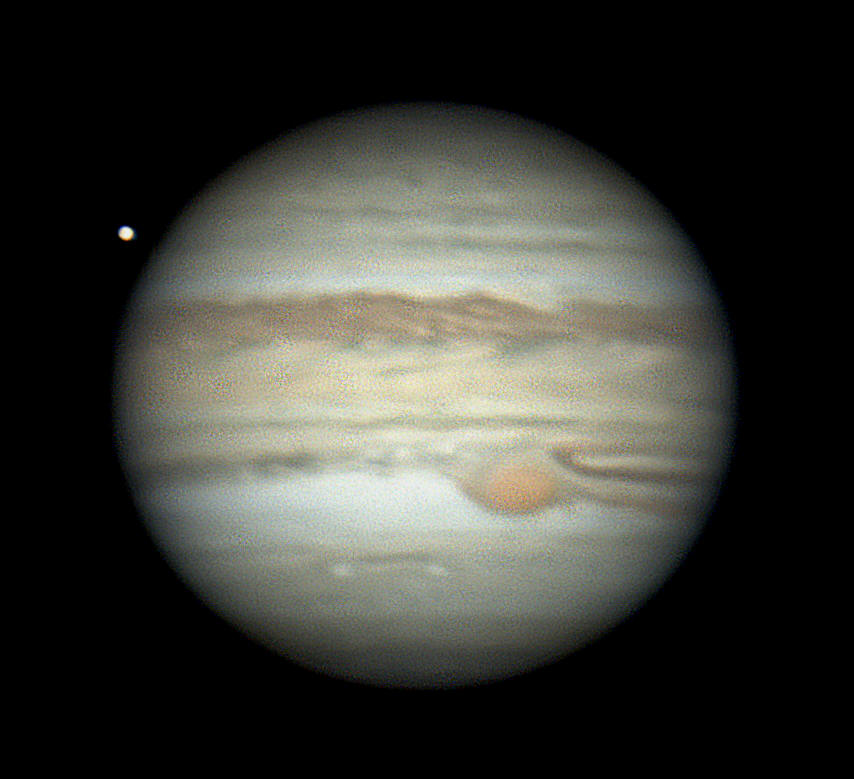
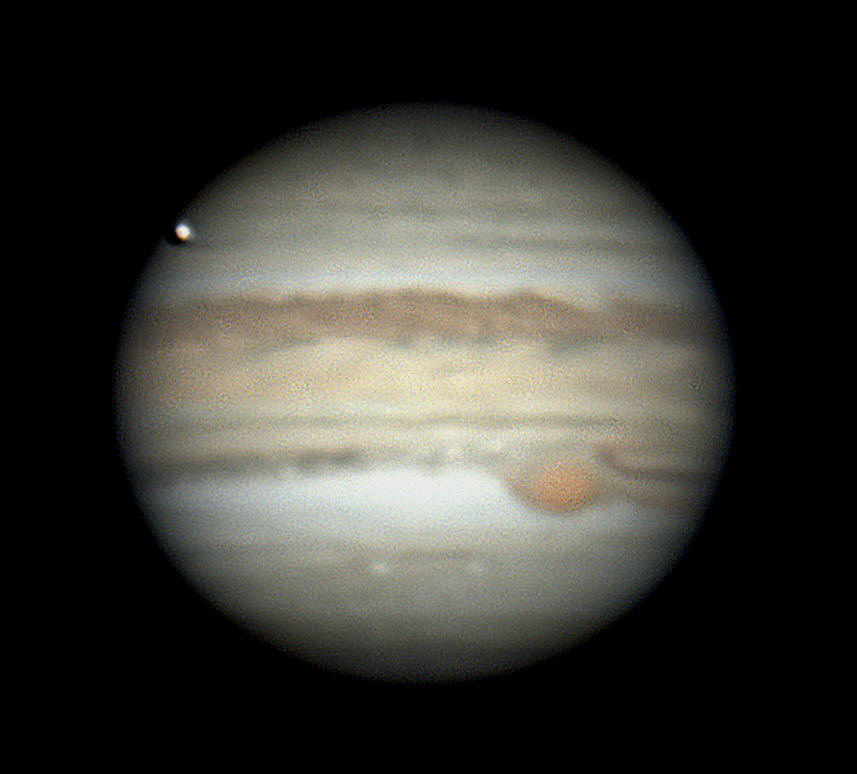
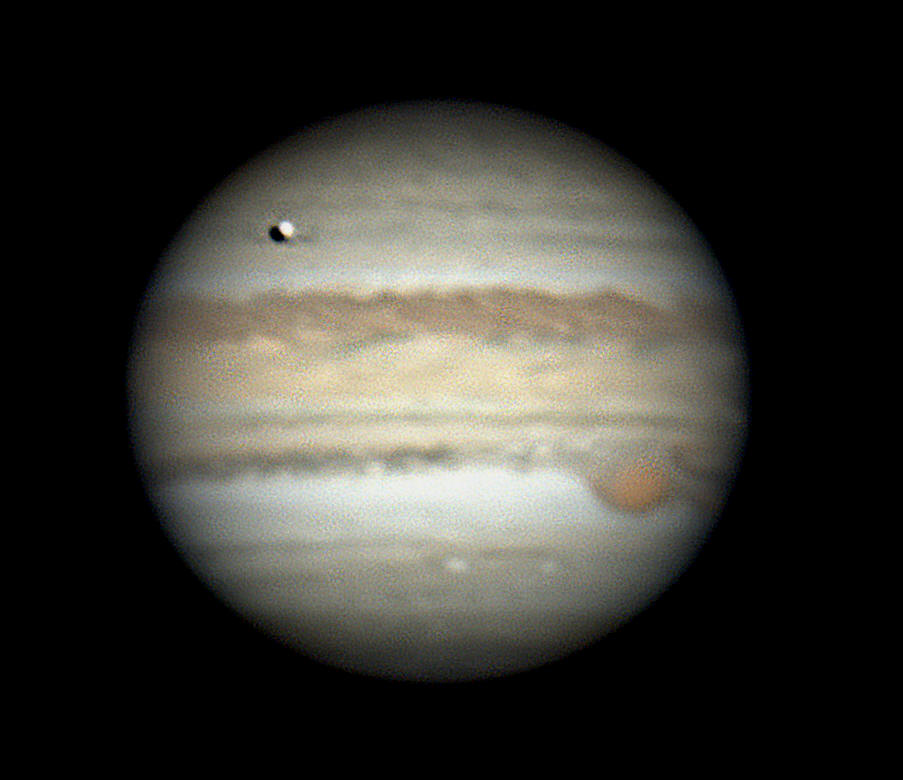

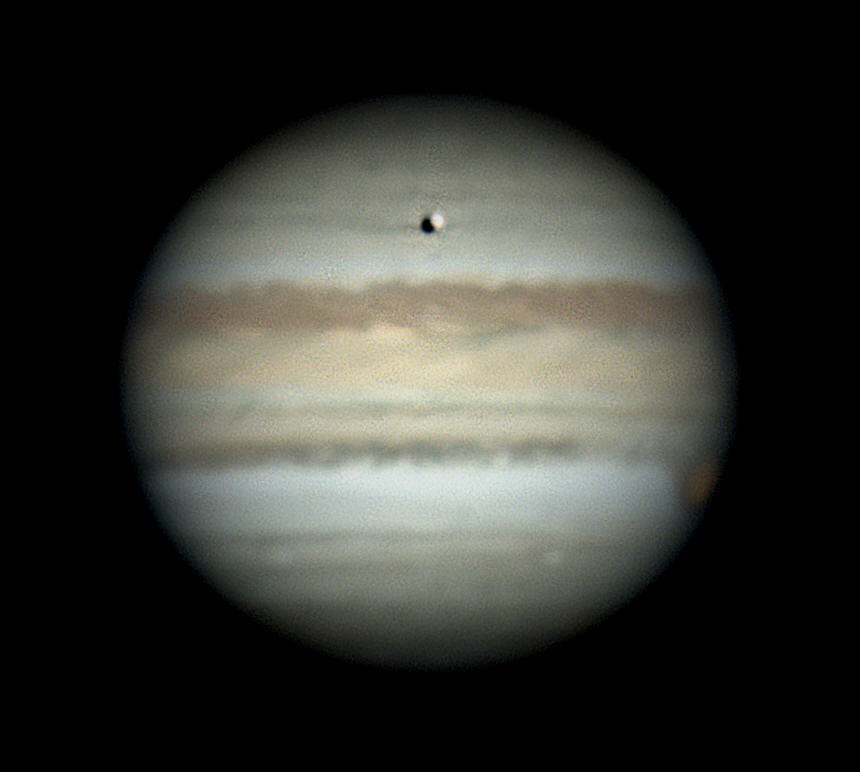
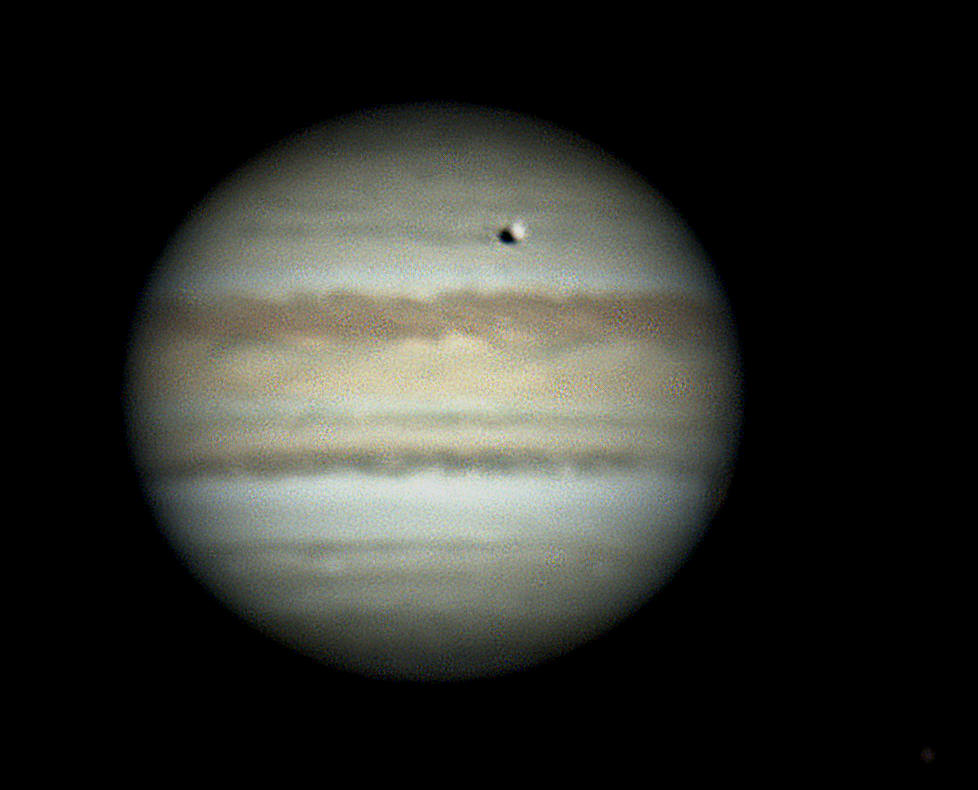
The third photograph was taken at 10:41 pm, when Europa was
about a third of its way across Jupiter.
There have been numerous alterations to Jupiter's belts and spots over the thirteen months since the 2018
some
twenty to twenty-two hours later. The first image above was
taken at 10:01 pm, when the Great Red Spot
was leaving Jupiter's central meridian and the satellite Europa was preparing to transit Jupiter's disc.
Europa's transit began at 10:11 pm, and its shadow touched Jupiter's cloud tops
almost simultaneously.
Europa was fully in transit by 10:15 pm. The second photograph was taken two minutes later at
10:17
pm,
with the Great Red Spot heading towards Jupiter's western limb.
Its dark shadow is trailing it, slightly below, on the clouds of the North Temperate Belt. The shadow is
partially eclipsed by Europa itself. The fourth
photograph at 10:54 pm shows Europa and its shadow about
a quarter of the way across. This image is enlarged below. The fifth photograph shows Europa on Jupiter's
central meridian at 11:24
pm, with the Great Red Spot on Jupiter's limb.
The sixth photograph taken at 11:45 pm shows Europa about two-thirds of the way through its transit,
and the
Great Red Spot almost out of sight. In this image, the satellite Callisto may be
seen to the lower
right of its parent planet. Jupiter's elevation above the horizon for the six photographs in order was 66º,
70º,
75º, 78º, 84º and 86º. As the evening progressed, the 'seeing' proved quite variable.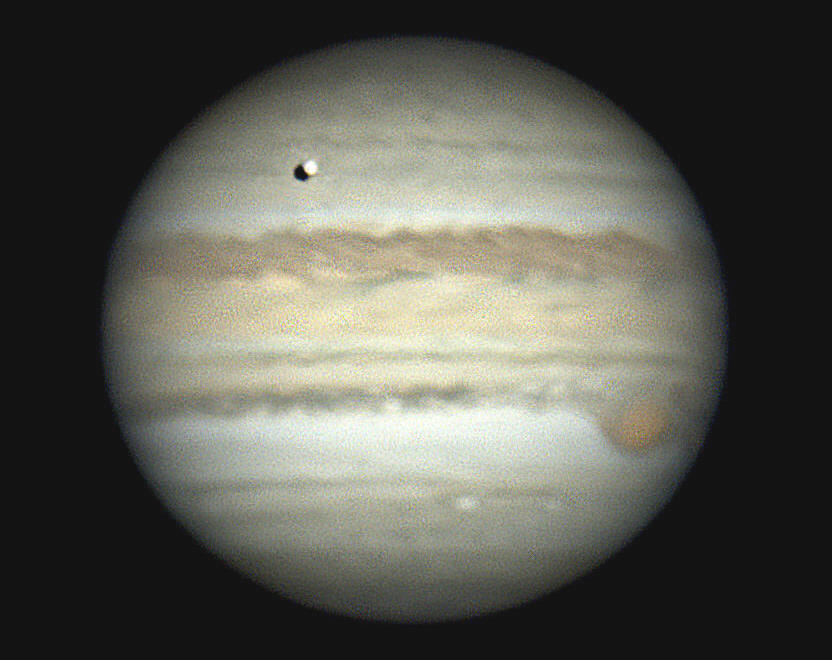
opposition. In particular, there have
been major disturbances affecting the Great Red Spot, which appears
to be slowly
changing in size or "unravelling".
Saturn


Right: Over-exposed
Saturn surrounded by its satellites Rhea, Enceladus, Dione, Tethys and Titan -
February 23/24, 2009.
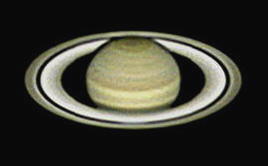
Saturn with its Rings wide open on July 2, 2017. The shadow of its globe can be
seen on the far side of
the Ring system. There are three main concentric rings:
Ring A is the outermost, and is separated from
the brighter Ring B by a dark gap
known as the Cassini Division, which is 4800 kilometres wide, enough
to drop
Australia through. The innermost parts of Ring B are not as bright as its
outermost parts. Inside
Ring B is the faint Ring C, almost invisible but
noticeable where it passes in front of the bright planet as a
dusky band.
Spacecraft visiting Saturn have shown that there are at least four more Rings,
too faint and
tenuous to be observable from Earth, and some Ringlets. Some of
these extend from the inner edge of
Ring C to Saturn's cloudtops. The Rings are
not solid, but are made up of countless small particles,
mainly water ice with
some rocky material, all orbiting Saturn at different distances and speeds.
The
bulk of the particles range in size from dust grains to car-sized chunks.
T
he photograph above was taken when Saturn was close to opposition, with the Earth between Saturn
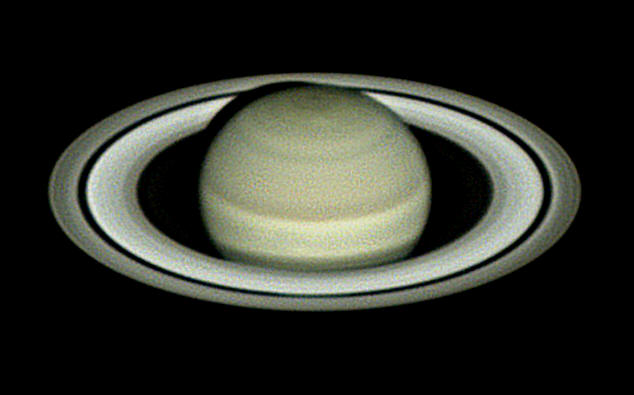
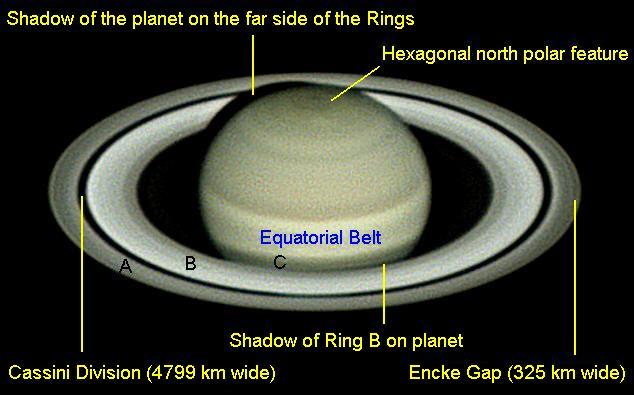
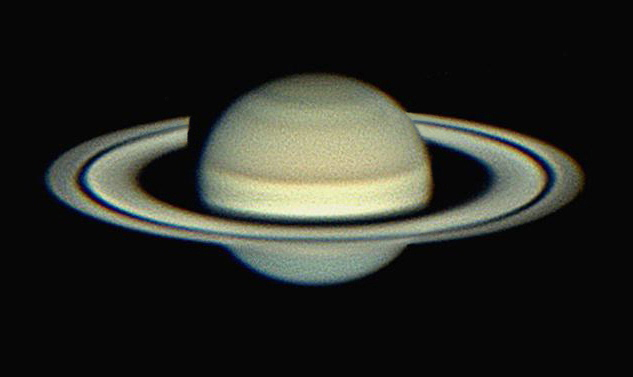
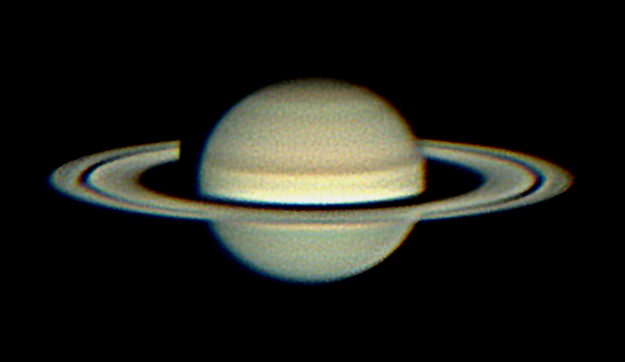
The change in aspect of Saturn's rings is caused by the plane of the ring system being aligned with Saturn's equator, which is itself tilted at an angle of 26.7 degrees to Saturn's orbit.
As the Earth's orbit around the Sun is in much the same plane as Saturn's, and
the rings are always tilted in the same direction in space, as we both orbit the Sun, observers on Earth see the configuration of the rings change from wide open (top large picture) to half-open
(bottom large picture) and finally to edge on (small picture above). This cycle is due to Saturn taking 29.457 years to complete an orbit of the Sun, so the
complete cycle from
"edge-on (2009) →
view of Northern hemisphere, rings half-open (2013) → wide-open (2017) → half-open (2022) →
Neptune
Neptune, photographed from Nambour on October 31, 2008

Pluto
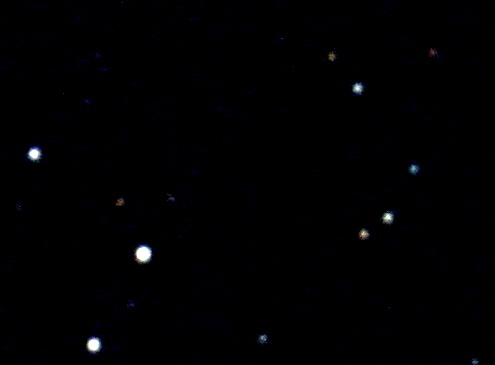
The movement of the dwarf planet Pluto in two days, between 13 and 15 September, 2008. Pluto is the
one object that has moved. Width of field: 200 arcseconds

This is a stack of four images, showing the movement of Pluto
over the period October 22 to 25, 2014.
Pluto's image for
each date appears as a star-like point at the upper right corner of the numerals.
The four are equidistant points on an almost- straight line. Four eleventh magnitude field stars are
identified.
A
is GSC 6292:20, mv
= 11.6.
B
is GSC 6288:1587, mv
= 11.9.
C
is GSC 6292:171,
mv
= 11.2.
Comet 17P / Holmes, October - December 2007
Comet 17P/Holmes is an extremely faint periodic comet that returns every 6.88 years without anyone taking much notice. Its arrival last year gained it world-wide attention, for it exploded on 24 October 2007. A vast sphere of dust and debris was ejected in an ever-growing cloud. Though the comet’s head is only some tens of kilometres across, the cloud rapidly reached the size of Jupiter by November 9 grew larger than the Sun. It has continued to enlarge until it exceeded two million kilometres in diameter.
Before the eruption, the comet could only be seen through large telescopes, but the explosion caused it to brighten a millionfold within 36 hours, making it an obvious naked-eye object. It is possible that there could be a second explosion, as occurred in 1892 and led to its discovery by Edwin Holmes.
Since the explosion was first detected, the comet expanded dramatically, to become the largest object in the solar system. It reached a size in the night sky a little larger than the diameter of the Moon. How a small comet could produce such an enormous cloud has not yet been explained.
In mid-November 2007, Comet Holmes experienced a ‘disconnection event’ - its faint, beautiful blue ion tail became detached from its head. Comet tails can be disconnected by gusts of solar wind which trigger magnetic storms around the comet similar to the geomagnetic storms which cause aurorae on Earth. Such a storm and disconnection was observed earlier this year in the tail of Comet Encke.
Was it really the largest object in the Solar System? In diameter, yes, but of course the Sun is the most massive object by several orders of magnitude. Some comets produce tails many millions of kilometres long, so they would be longer, but not 'bigger'. Photographs taken from Starfield Observatory, Nambour appear below.
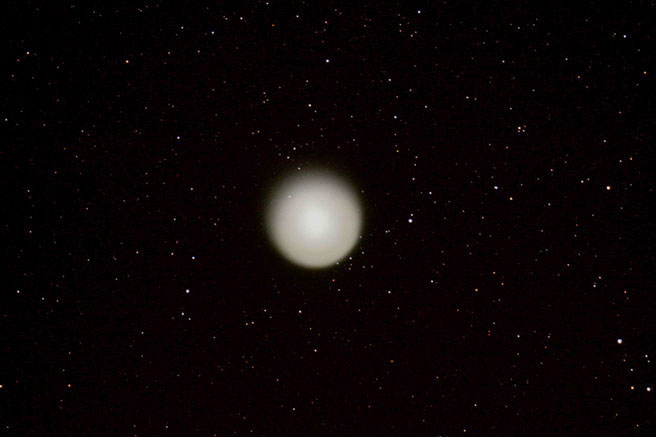
This image and those following are all taken with the same equipment and have
the same plate scale,
except when indicated otherwise. They therefore show how the ejecta cloud surrounding the
nucleus has
expanded from night to night. The sphere of ejecta surrounding the comet's nucleus is most clearly defined
in
the direction of the Sun, In the picture above this direction is towards the
lower right. The magnitude 11.4
star GSC
3321:602 can be seen shining through the cloud at upper left. The diameter of
the expanding
cloud had reached 15 arcminutes and was still growing.
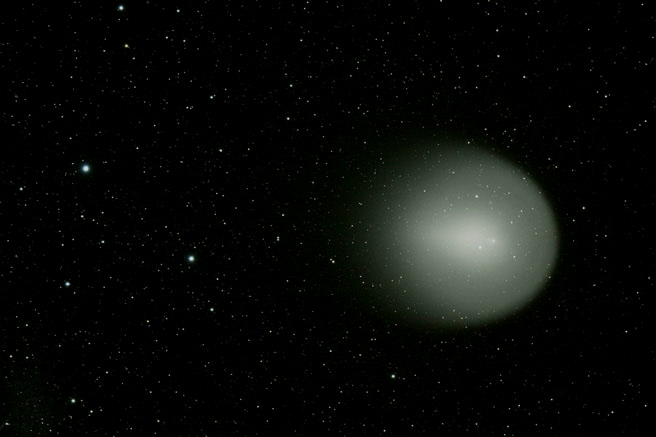
In the remaining images, the direction of the Sun is to the right.
This
image was taken ten nights later,
on 13
November. The cloud of dust surrounding the nucleus is much larger - in fact the
cloud itself was
larger than the Sun and appeared in the sky about the same size
as the Full Moon.
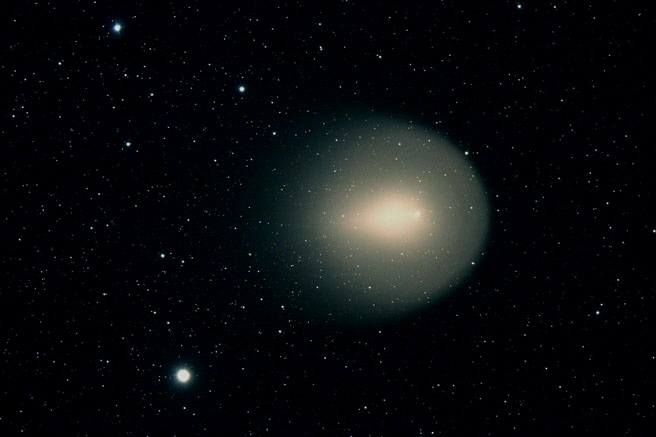
This
image was taken three nights later, just
after midnight on 17
November. The cloud of dust surrounding
the nucleus continues to grow, and the
comet is now the largest object in the Solar System. It appeared to
the
unaided eye like a faint ghost of the Full Moon. The bright star at lower left
is Mirfak, a yellow-white F5
star of magnitude 1.79.
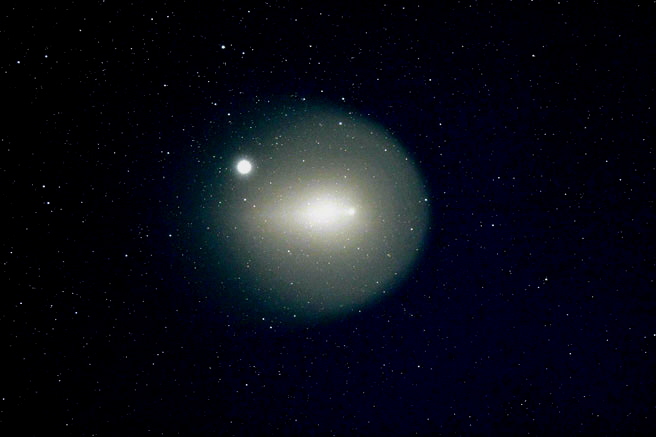
This
image was taken two nights later, on November 19. The coma of Comet Holmes
appears to swallow
the much more distant star Mirfak. At this stage the comet is
fading, and becoming swamped by
moonlight from the waxing gibbous Moon.
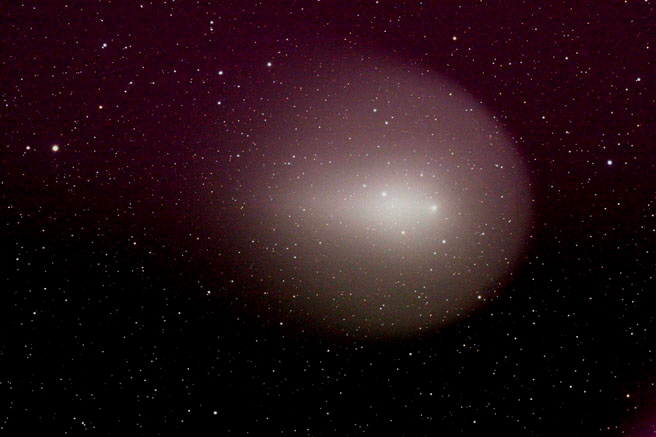
This
image was taken ten nights later, on November 29. The cloud is still
expanding, and has reached
a diameter of 46 arcminutes (cf approximately 30
arcminutes for the Full Moon. A newly developing tail
can be seen extending from
the spherical cloud to the left-hand margin.
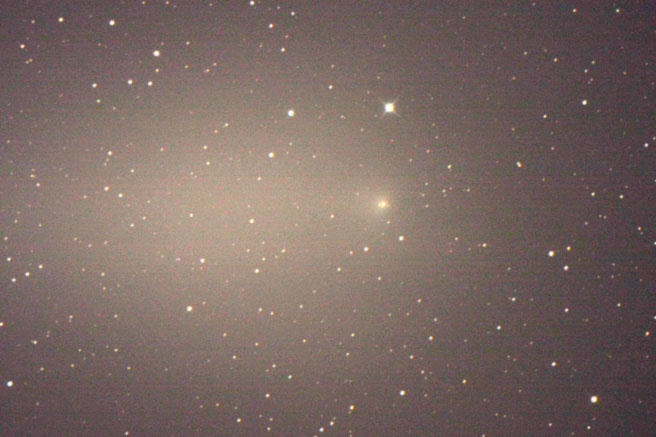
This
image was taken at the prime focus of the RCOS reflector, and has a much larger
plate scale than
the other images above. It shows the interior of the ejecta
cloud, which fills the frame and has now
become the comet's coma. The nucleus or
head is just right of centre, and the beginnings of the tail
stream off to the
left. Image acquired on December 3.
Comet 2006 P1 (McNaught), January - February 2007
Comet McNaught provided a magnificent display in early 2007, the best since the 1910 apparition of Halley's Comet. At its brightest, the head outshone nearby Venus, and the tail developed great fan-shaped streamers of dust and gas that spread over a large span of the night sky. The following images were taken on January 20 and 21, when there was a break in persistent overcast weather. Thanks to Nambour Plaza's Digital Dog for careful processing.
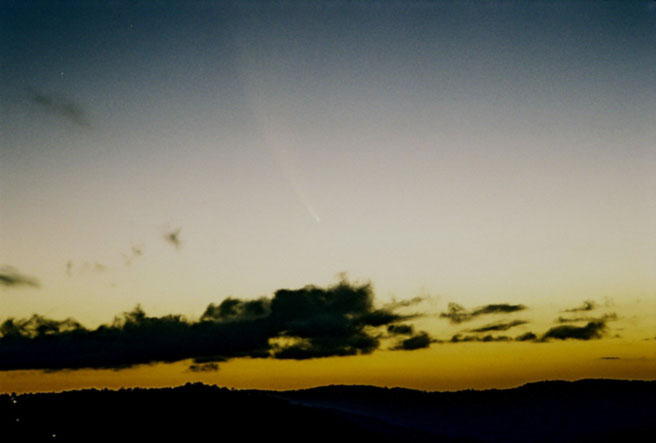
Comet McNaught faintly appears out of the
twilight shortly after sunset. Photographed from the Maleny-
Conondale Road on
January 20.
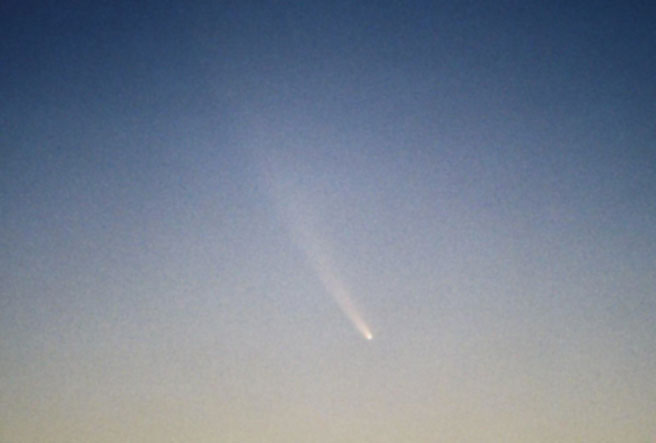
As twilight fades, Comet McNaught becomes easily seen.
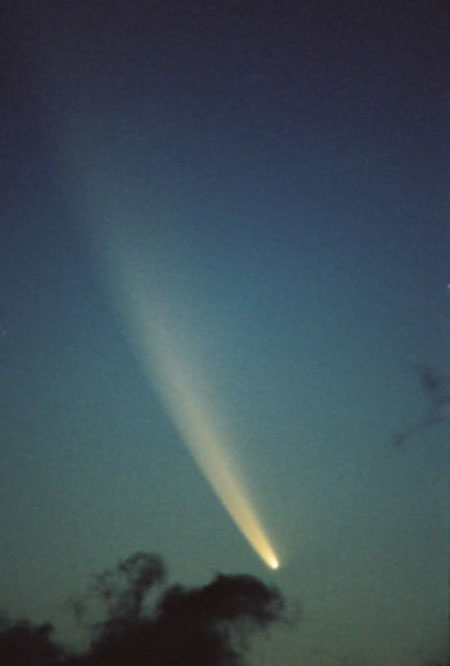
The comet becomes clearly visible
as darkness falls.
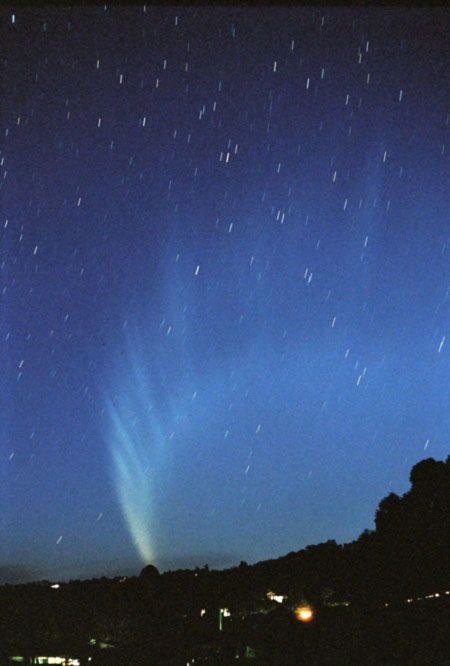
The great tail does
not become visible until twilight fades. Unfortunately this happens after the
comet's
head has passed below the horizon. Photographed from Starfield
Observatory in Nambour on January 21.
The house lights in the foreground are at
Image Flat. The short curved lines in the sky are star trails
caused by the
Earth's rotation.
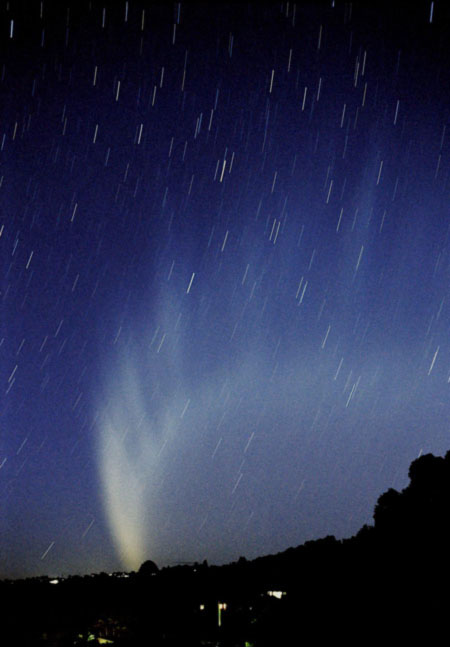
The full extent of the tail is
revealed after darkness falls. A faint line of dots crossing the frame is the
trail left by the strobe lights of the local rescue helicopter on its flight
path to the Nambour Hospital.
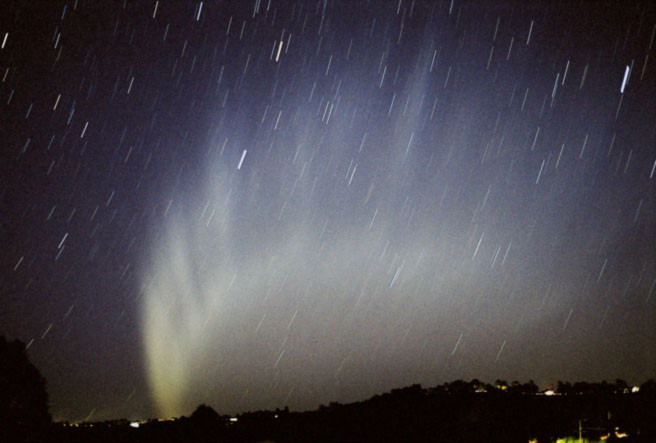
There are over a dozen synchronic
bands or streamers visible in the comet's tail
in this photograph.
The lights on the skyline are private homes built on Kureelpa Falls Road, on the edge of the Highworth
Range escarpment. The Dulong
Lookout is at the left margin. The brightest star trail at upper right was
made by the first magnitude star Fomalhaut. The bright star behind the comet's
tail (above left centre
of photograph) is the star Al Nair in the constellation Grus. Taken from Starfield Observatory
with a
standard lens which has a field width of 43 degrees.

By February 6 the synchronic
bands have merged into a wide, triangular fan tail covering an angle of
about 55
degrees.
The star just below the comet's coma (the glowing gas and dust surrounding the
nucleus)
is SAO 247006, magnitude 7.47. The faintest stars on this image are of
magnitude 13. None of these
stars is visible to the unaided eye. Taken from Starfield Observatory - the field width is 4.5 degrees.
Comet 2007 N3 (Lulin), February - March 2009
Comet Lulin was
discovered in 2007 at Lulin Observatory by a collaborative team of Taiwanese and Chinese astronomers. It moved rapidly from Scorpius to Gemini, the head reaching a magnitude of 5. It had bright ion and dust tails, and an anti-tail.
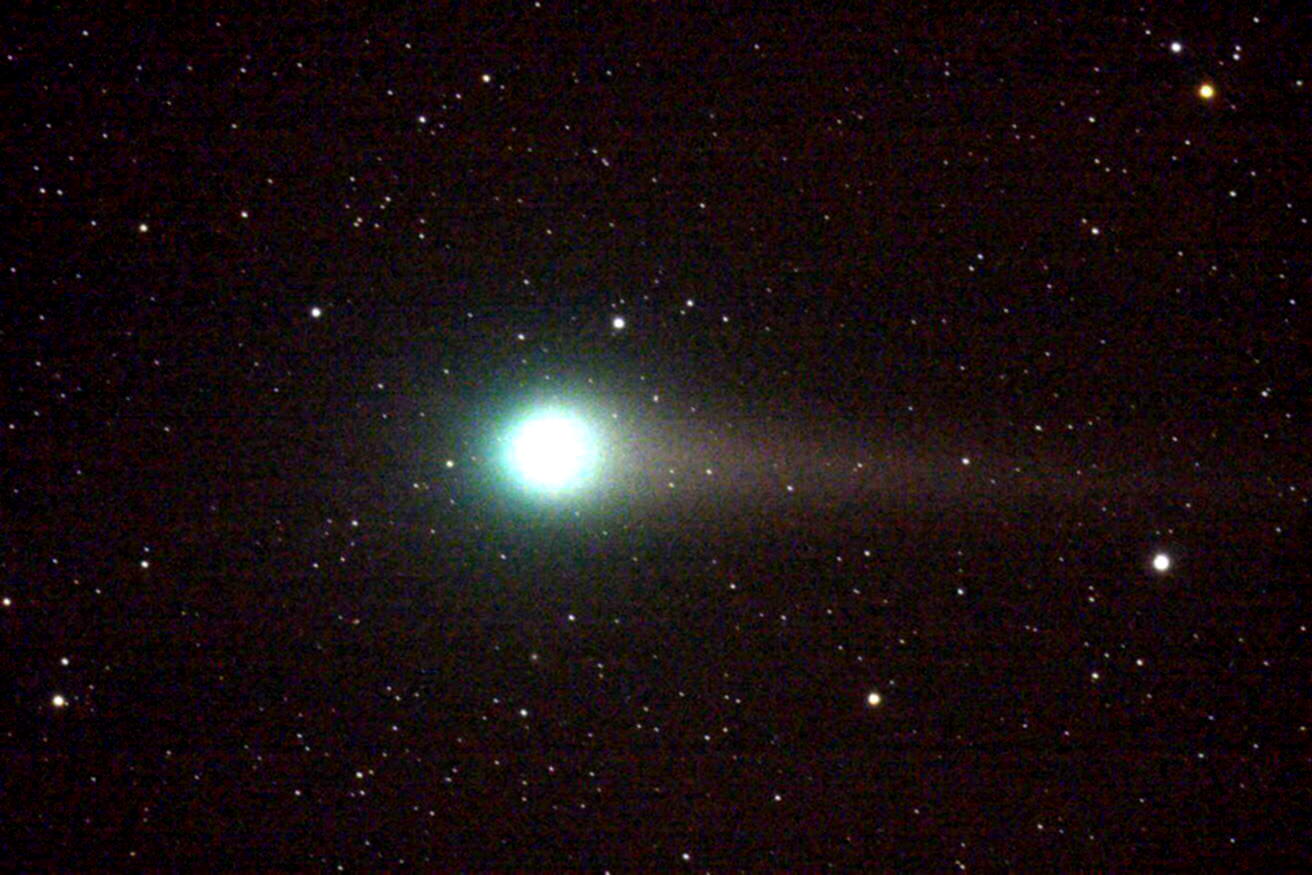
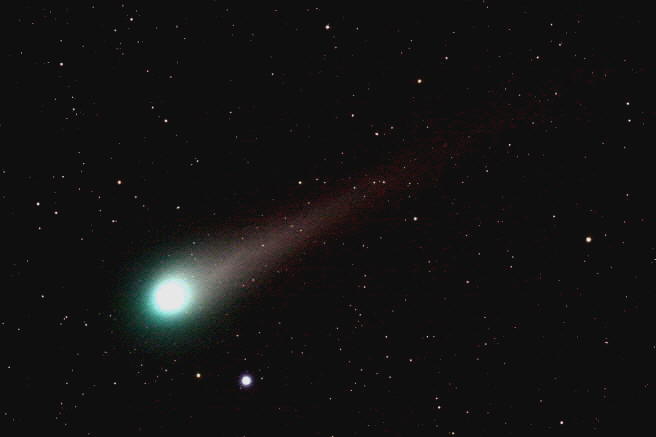
Comet 46P / Wirtanen, November - December 2018
In December 2018, Comet 46P/Wirtanen swept past Earth, making one of
the ten closest approaches of a comet to our planet since 1960. It became
faintly visible to the naked eye for weeks.
Although Wirtanen's nucleus is only 560 metres across, its emerald green atmosphere
appeared larger than the full Moon, and it was an increasingly easy target for binoculars
and small telescopes. It reached its closest approach to the Sun (perihelion) on December 12, and then
headed towards Earth. It passed the Earth at a distance of 11.5 million kilometres (30 times as far away as the Moon) on December 16. Its
passage across the sky took it from the southern constellation of Fornax through
Eridanus, Cetus, Taurus and Auriga, making it an all-night object for observers
in the southern hemisphere. I
position was Right Ascension = 2 hrs 30 min 11 secs,
Declination = 21
the top of the picture. The nearest star to the comet's position, just to its left, is GSC 5862:549,
magnitude 14.1.
The spiral galaxy near the right margin is NGC 908.
The right-hand star in the yellow circle is SAO 167833,
magnitude 8.31.
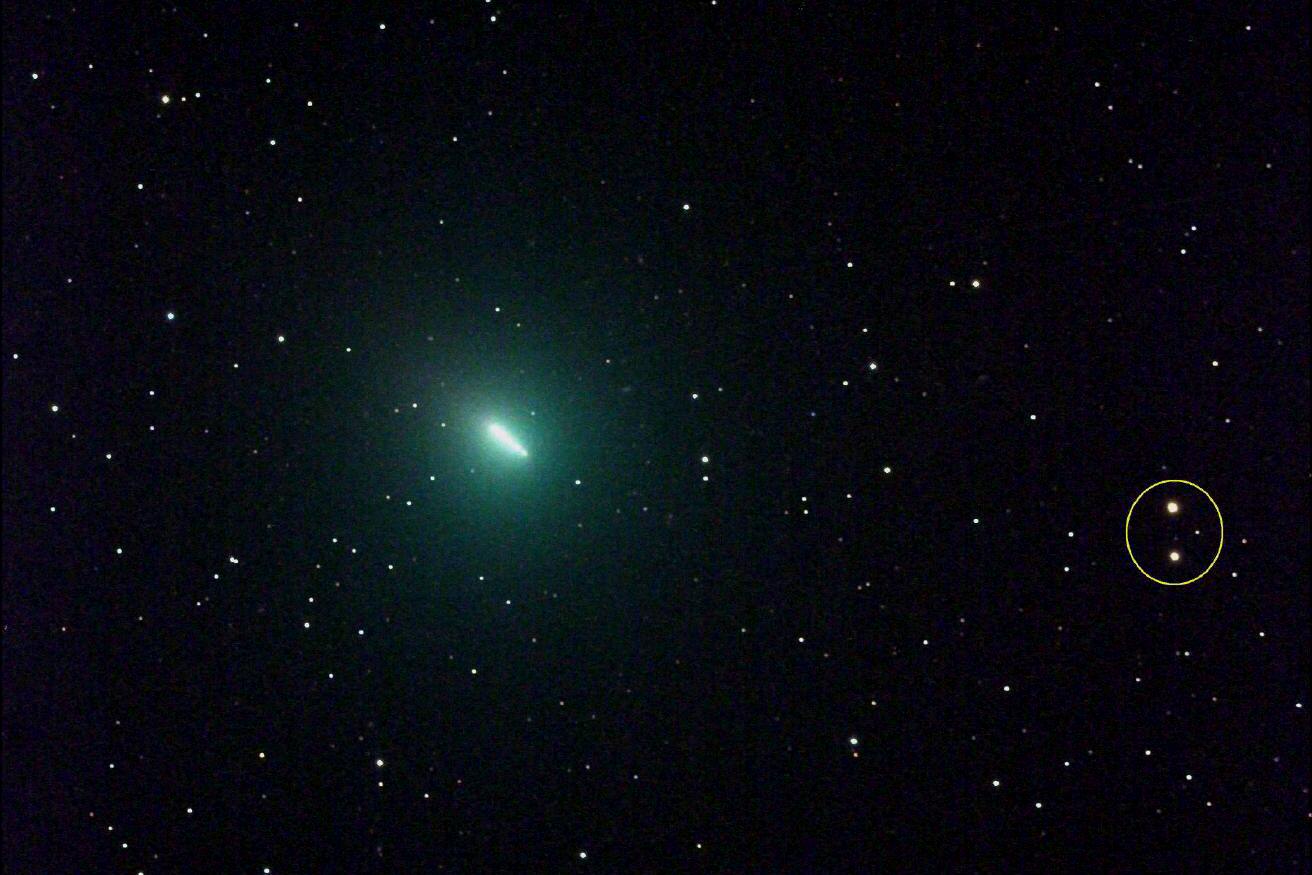
9:05
pm. The comet's movement over the 52 minute period can be seen, the five images of the
comet
merging into a short streak.
It is heading towards the upper left corner of the image, and is brightening as
it approaches the Sun, with perihelion occurring on December 12. The images of the stars
in the five
exposures overlap
each other precisely. The length of the streak indicates that the comet is
presently
moving against the starry background at 1.6º per day.
The comet at 9:05 pm was at Right Ascension = 2 hrs 32 min 56 secs, Declination = 20º 27'
20".
The upper star in the yellow circle is SAO 167833, magnitude 8.31, the same
one circled in the preceding
picture but with higher magnification.
eye, but easily visible through binoculars.
The Moon to: The Stars
Below is a picture of the Moon's Mare Imbrium taken forty years ago on Kodachrome II colour slide film by the writer at the East Warwick Observatory, using a Celestron 14. Following this is a set of pictures taken with a digital video camera at Nambour from 2017 to the present.
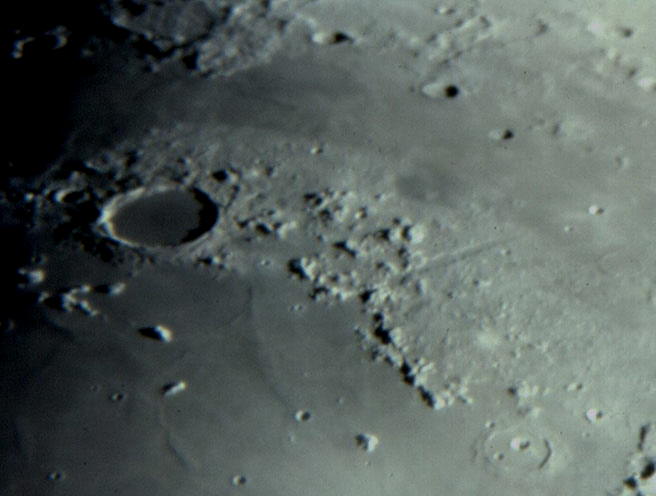
Mare Imbrium, with the large
walled plain Plato (centre left, 100 km diameter) and the 130 km
long Alpine
Valley (centre right).
The following are digital images taken with the Alluna RC-20 at Starfield Observatory. The video cameras used are a ZWO ASI 120MM-S, ZWO ASI 290MM and ZWO ASI 290 MC. The video streams of 2000 - 2500 frames are processed using AutoStakkert 3 and RegiStax 6.1 to produce still images.
The most delicate details visible in these images include the tiny craterlets on the floors of Plato and Archimedes, the Schröter's Valley rille and the Alpine Valley rille which averages only 600 metres across and 75 metres deep.
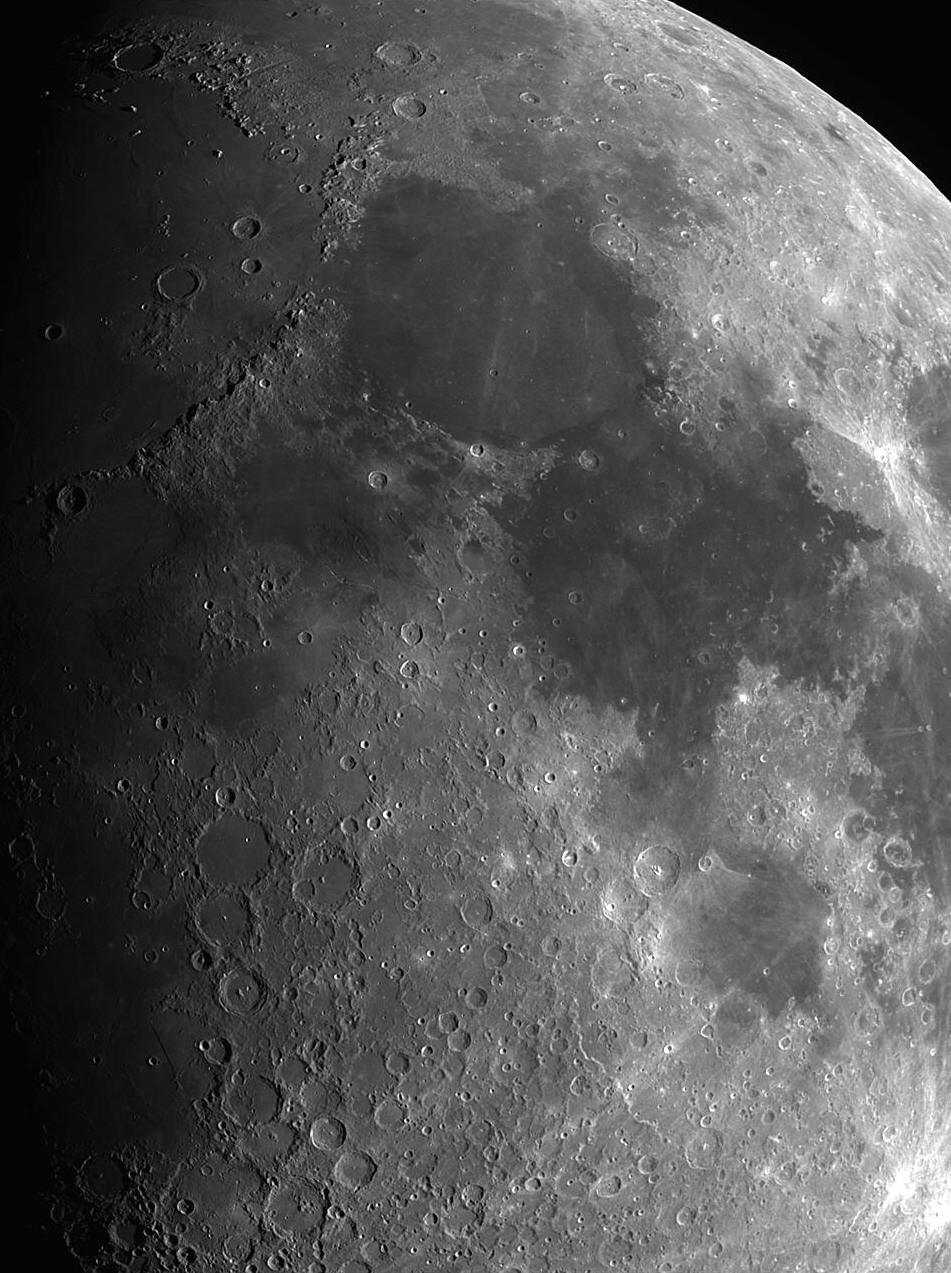
Moon at 8 days after
New. You may be able to find on this image some of the lunar features seen in
close-up in the following images.
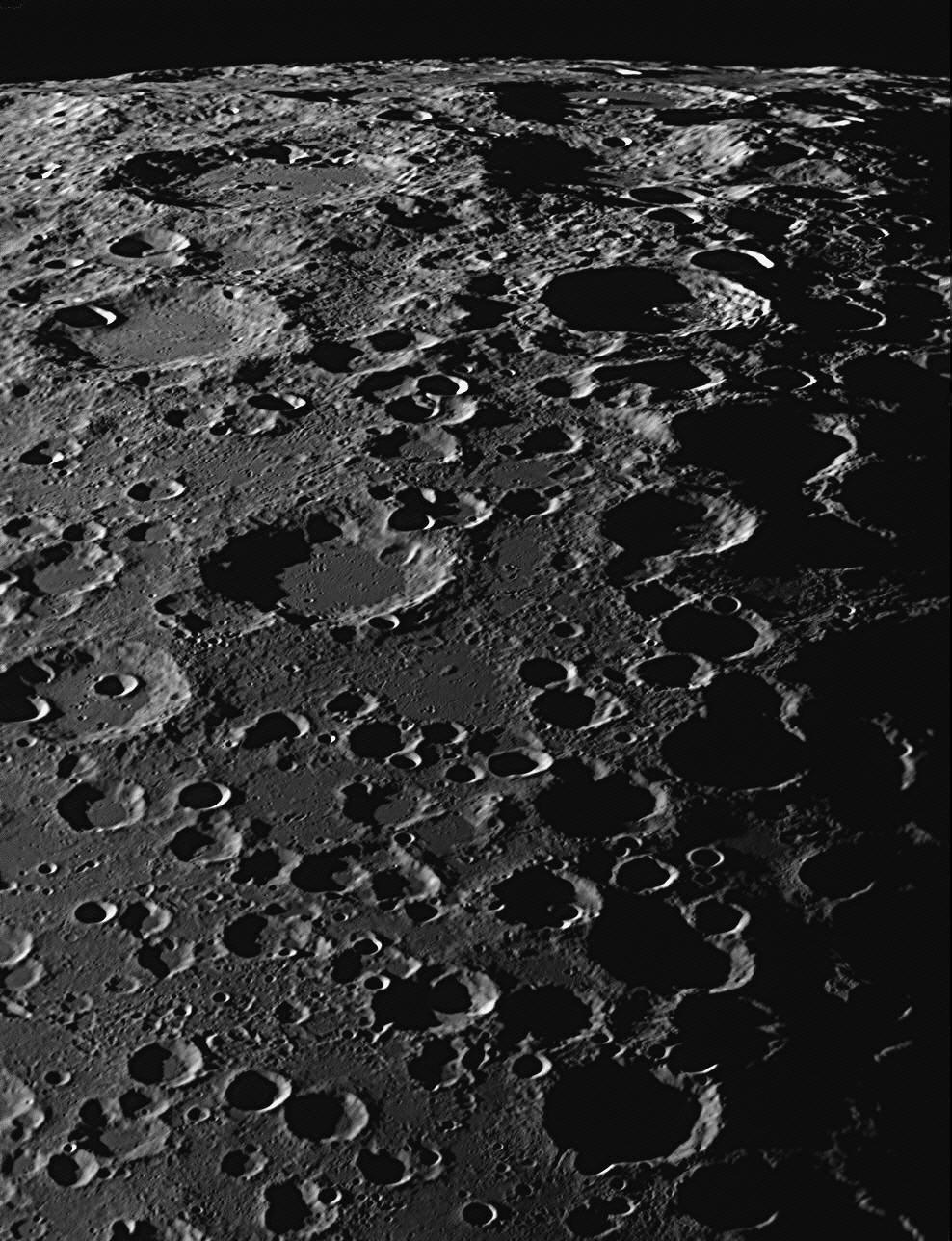
Sunrise at the Moon's south pole.
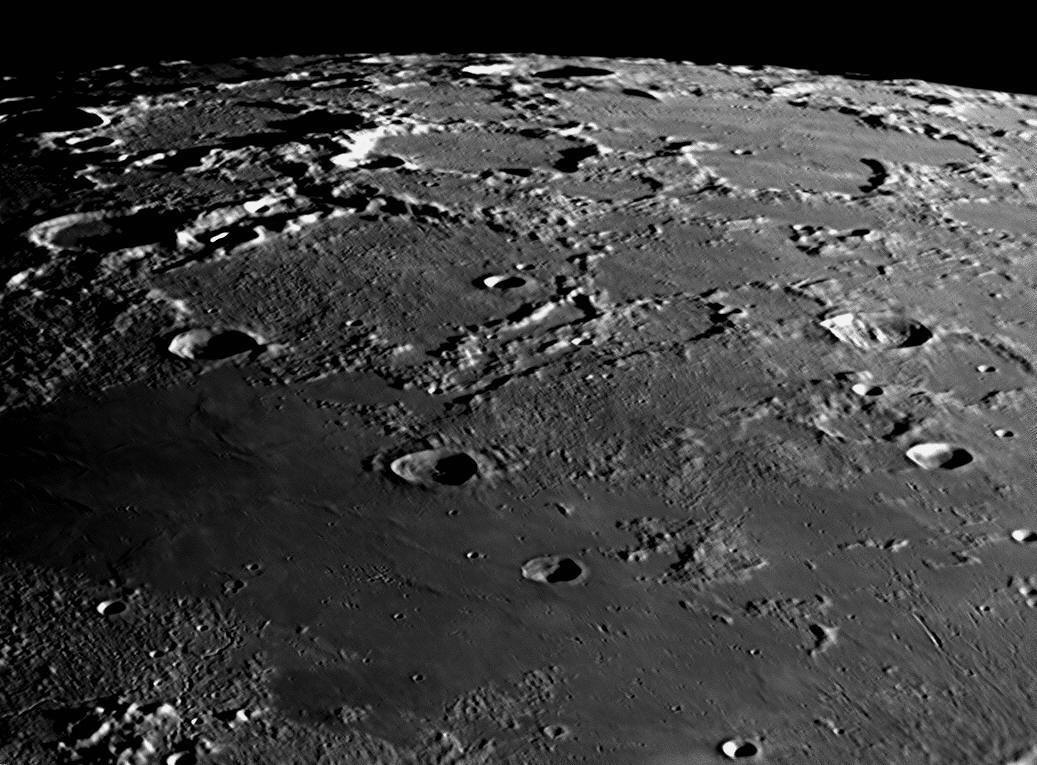
Sunrise at the Moon's north pole.

This area was photographed from Starfield Observatory, Nambour on October 10,
2016. East (where the
Sun is rising) is to the right, north is to the top. The area is dominated by the
large walled plain Plato at upper left,
and the impact crater Cassini at lower
right. Between the two is a rugged mountainous area called the Alps,
to the west
of which is a large basin filled with solidified lava, called Mare Imbrium (the
Sea of Rains).
Most of the craters on the Moon larger than about 8 kilometres are named,
usually after famous philosophers
or scientists. In addition, the lava plains,
mountain ranges, peaks, shallow valleys (called 'rilles'), and other
notable
features have also received names, sometimes after places on the Earth. As there
are no rivers,
cities or countries on the Moon, these names help observers to
find their way around. The second picture
above shows some examples.
Plato in close-up. Five craterlets with diameters of 2 to
3 kilometres are visible inside it, as well as several smaller ones.
Sunrise over the 166
km long Vallis Alpes (Alpine Valley). It has a maximum width of 10 km. A
delicate rille runs
One day later.
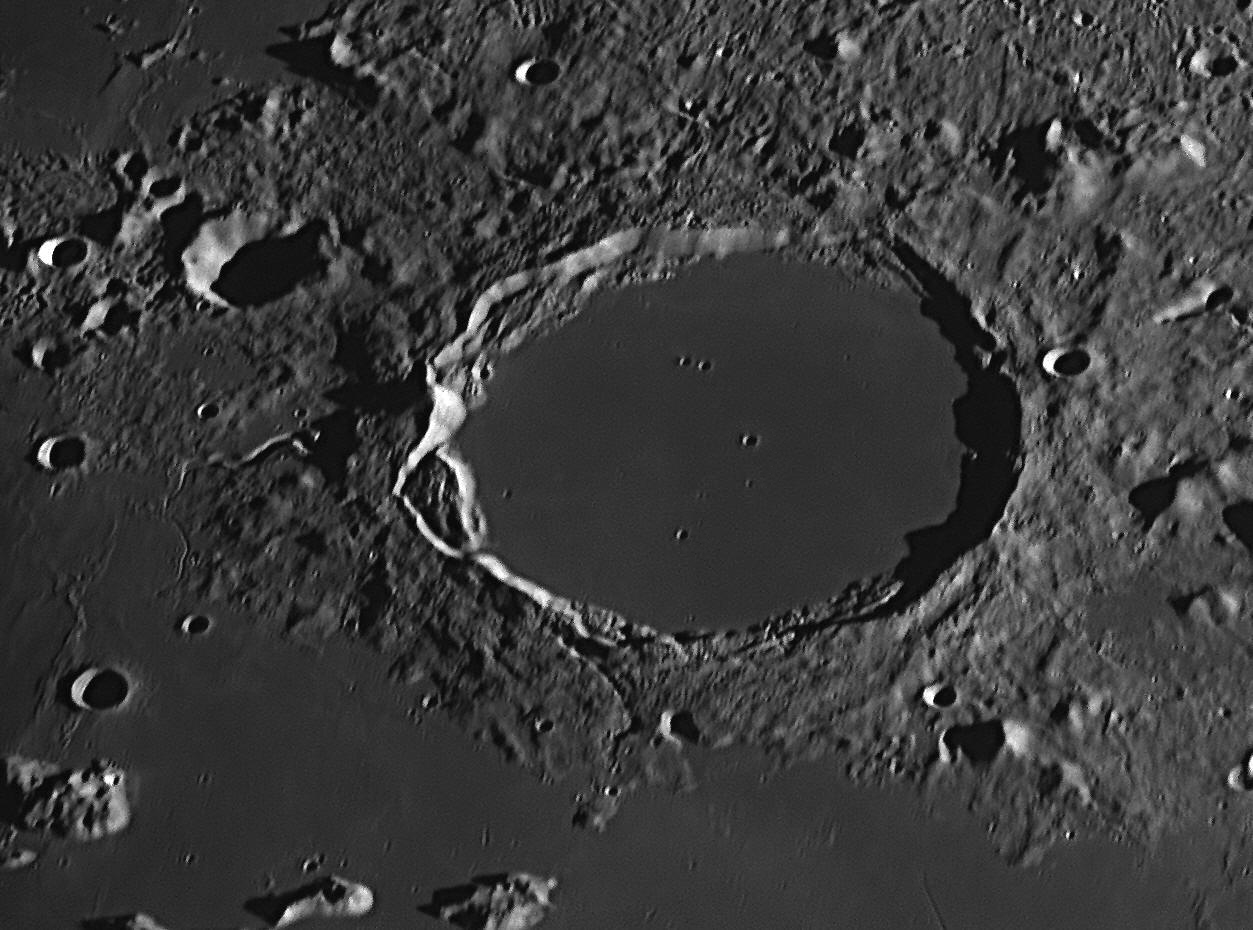
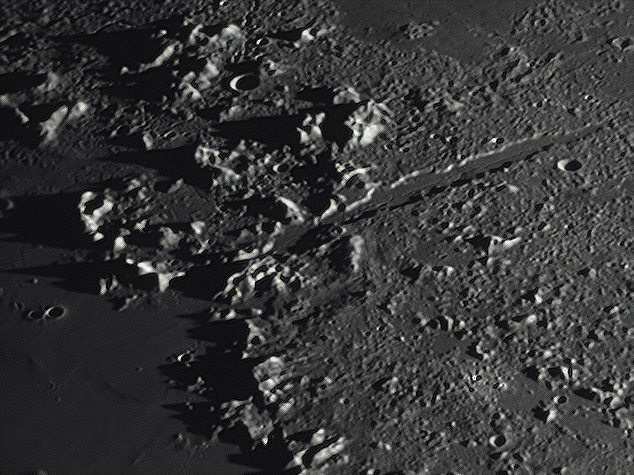
along the entire length. The rille has an average width of 600 metres and an
average depth of 78 metres.

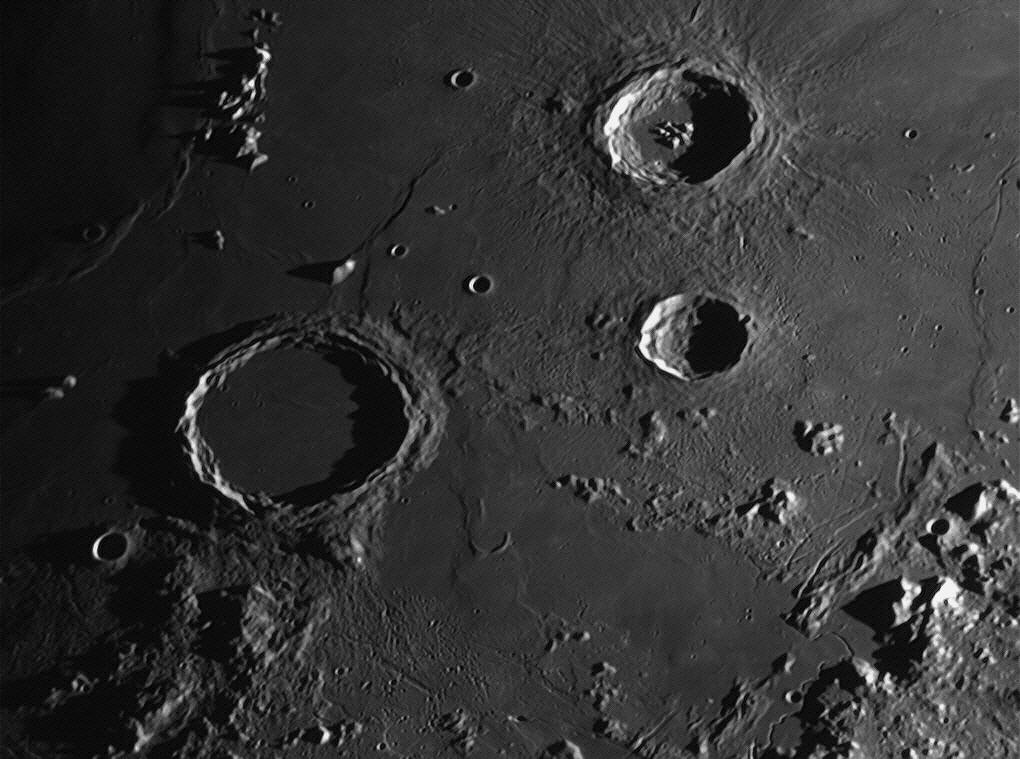
This well-known trio dominates the south-eastern quadrant of Mare Imbrium. The
craters are Archimedes (left),
Aristillus (top right) and Autolycus (lower right). The Fresnel Rilles and
Hadley Rille are in the lower right-hand corner.
Some small craterlets dot the flat floor of Archimedes. The complex of mountains
at upper left is called the Spitzbergen.
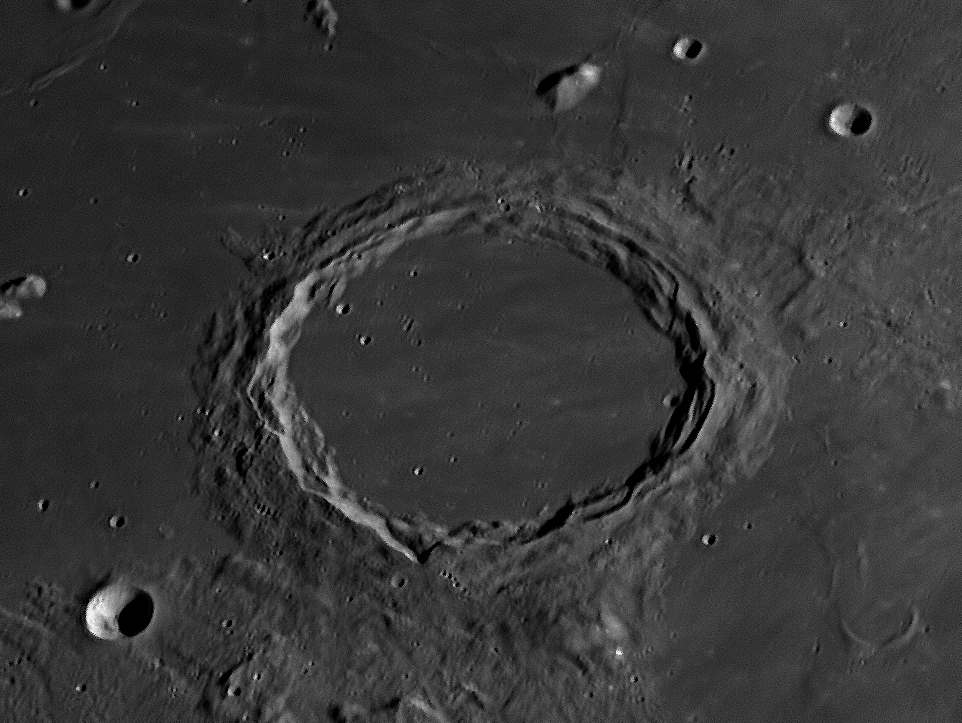
Close-up of Archimedes, 85 km in diameter. The smallest craterlets visible are less than 1 km in diameter.
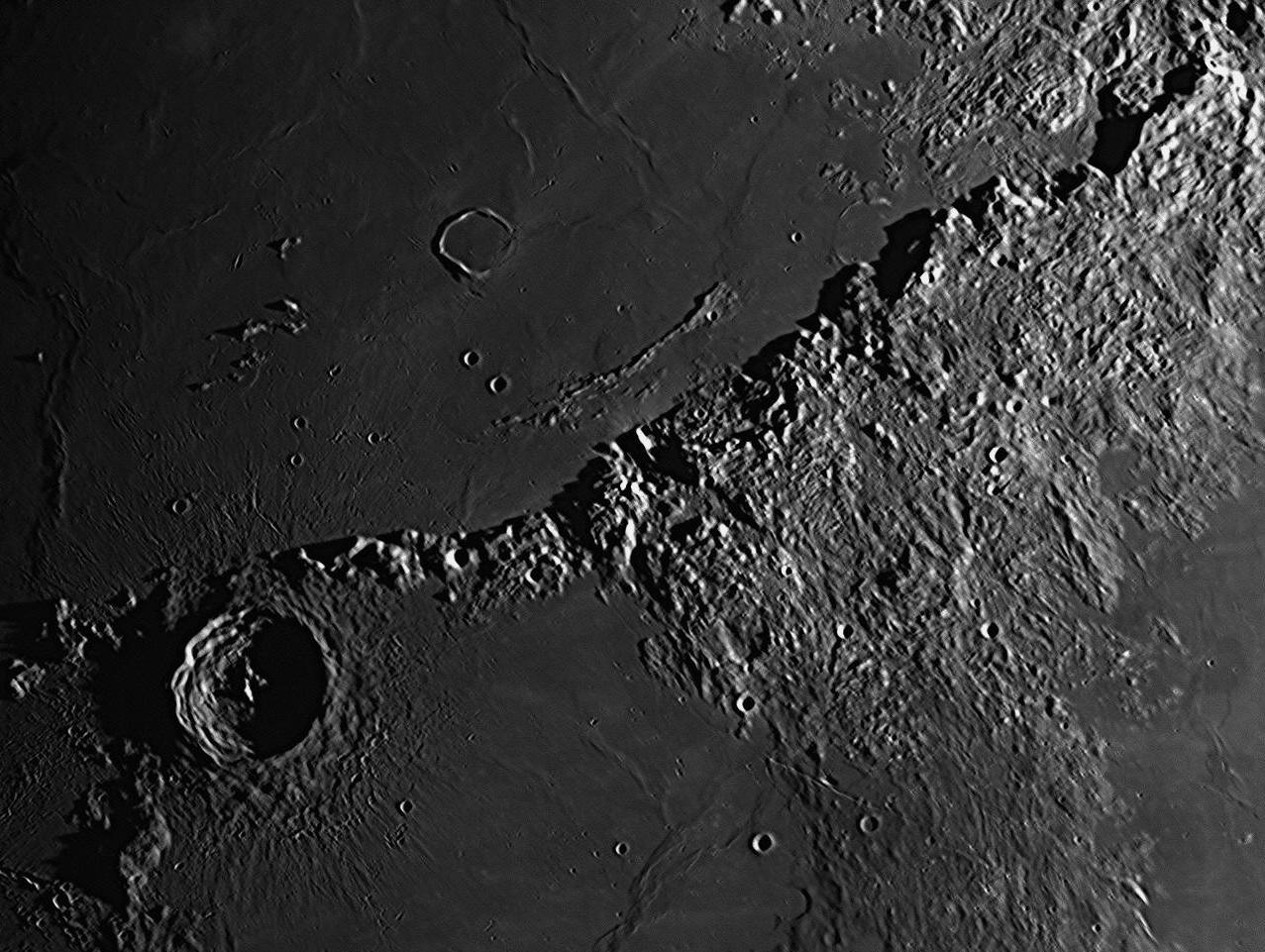
Sunrise on the Apennines: the crater Eratosthenes and the Montes Apenninus on the Moon,
photographed from Nambour on August
1, 2017.
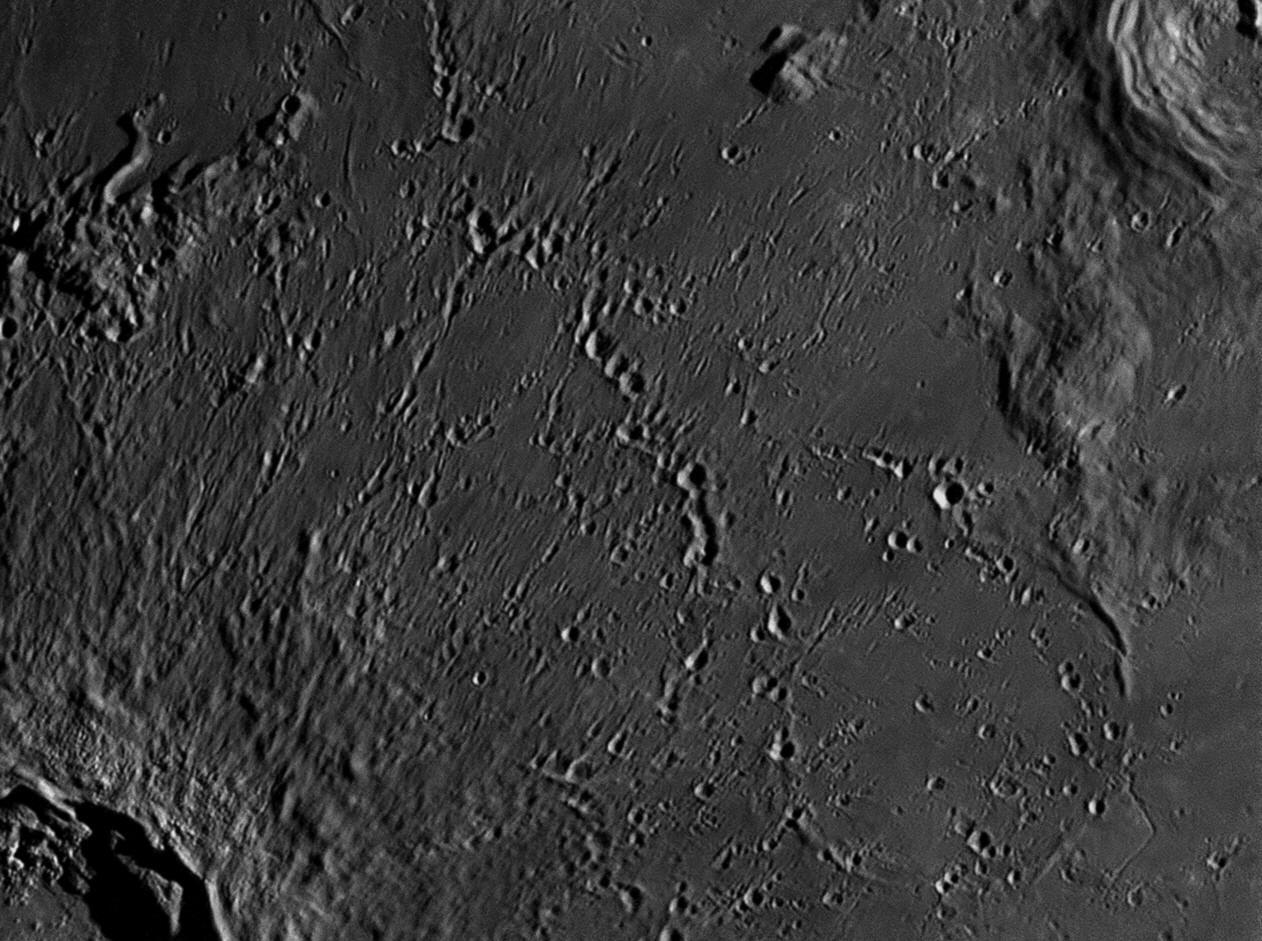
This area was photographed from Starfield Observatory, Nambour on August 2, 2017.
East (where
the Sun is rising) is to the right, north is to the top.
Eratosthenes is the crater at top right, Copernicus
is at lower left.
The damaged landscape and debris field caused by rubble from the Copernicus impact
is at centre,
and
the ghost crater Stadius can be faintly seen at lower right.
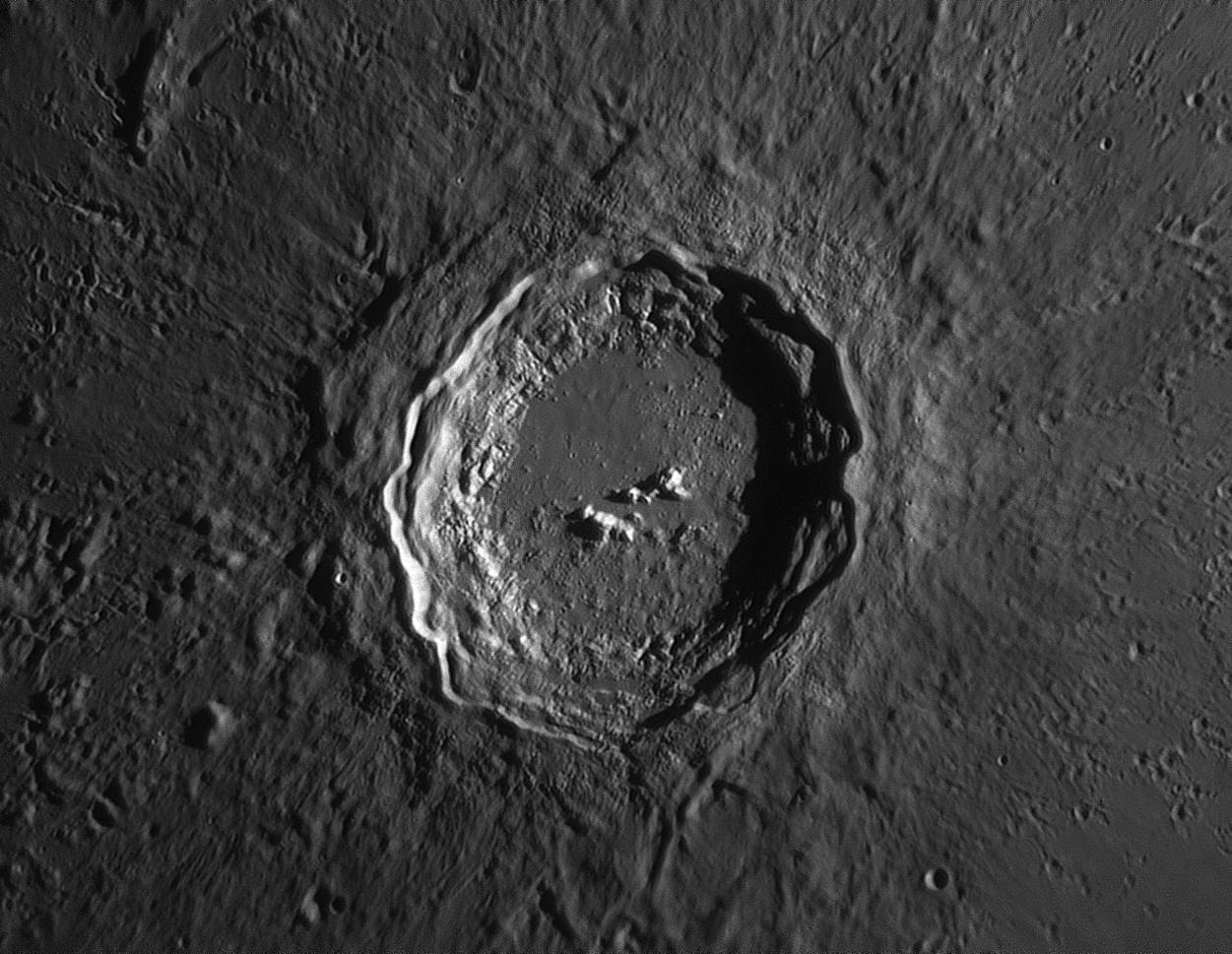
This image adjoins the one above.
The young crater Copernicus has a diameter of 95 km and is
3.75 km
deep.
Photographed on August 2, 2017.
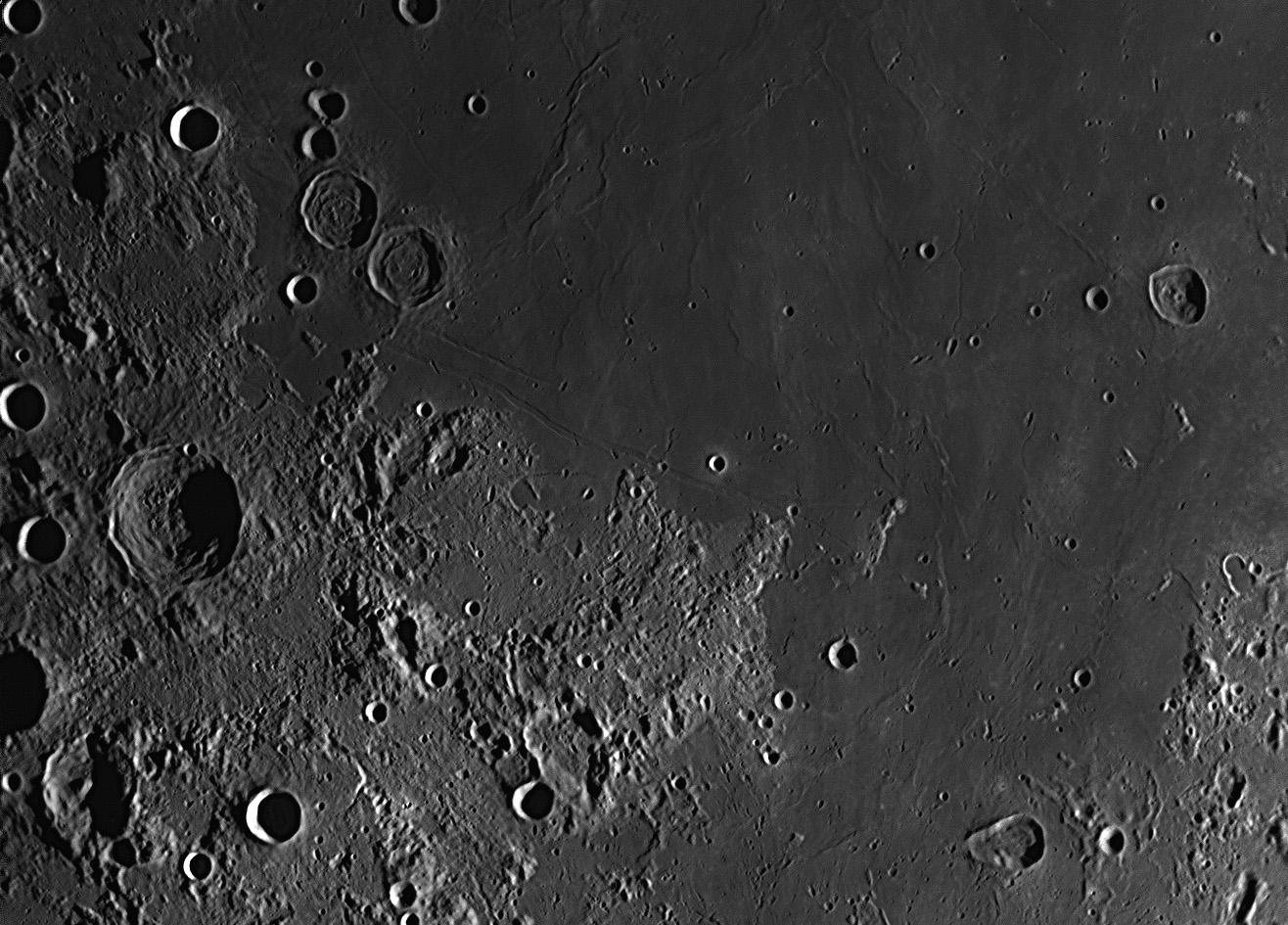
This area shows Tranquility Base, site of the landing by Apollo 11's lunar
module on July 21, 1969.
It was photographed from Starfield Observatory, Nambour on July 30,
2017. East (where the Sun is
rising) is to the right, north is to the top. The largest crater in the image
above is near the centre of the
left margin, and is
called Delambre. The deformed crater towards bottom right is named Torricelli.
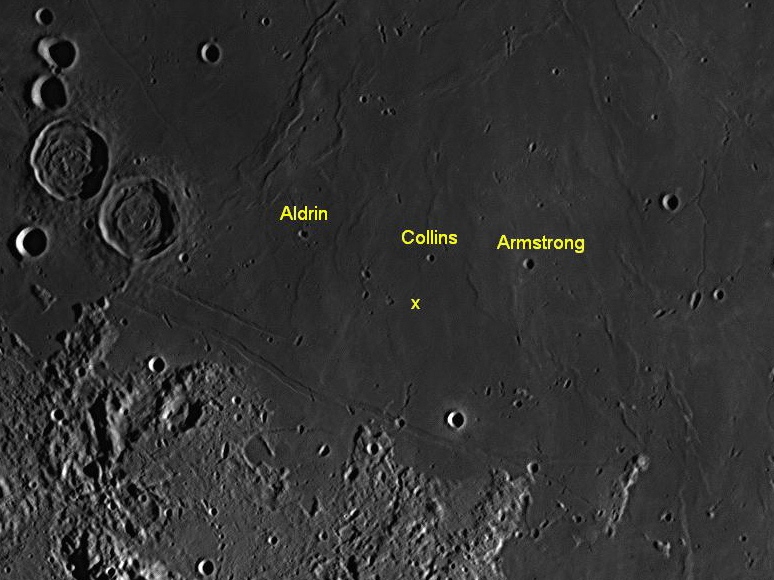
This is an enlargement of the previous image.
The landing site is shown by an '
x
'. Three craterlets have
been
officially named after the astronauts. Armstrong is 4.6 km in diameter,
Collins is 2.4 km,
and
Aldrin is 3.4 km.
The lunar module's landing approach was from the east (right).
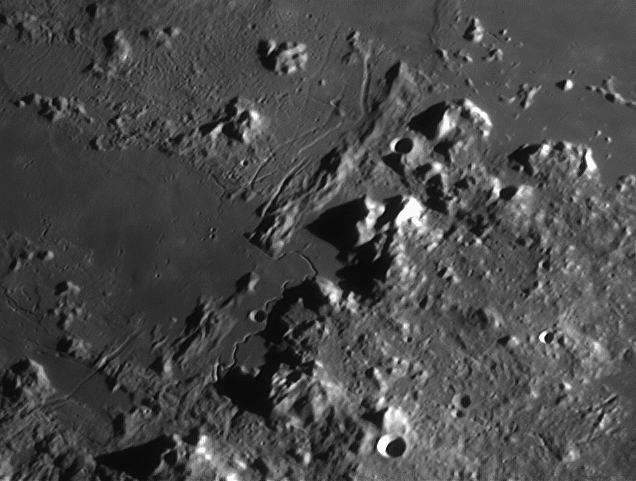
Hadley Rille and its environs, where Apollo 15 landed. The Rille varies between
1 and 1.5 km in width,
and is 80 km long. There are many more rilles to the north.
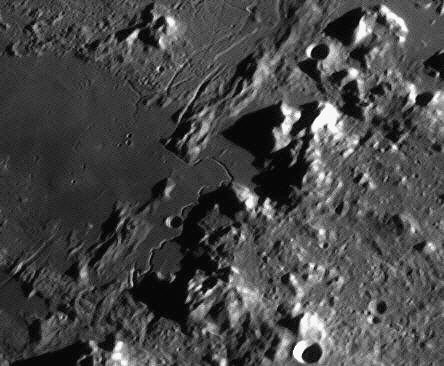
Comparing the image above with the NASA image below, from Nambour we see the
area slightly
foreshortened as we are at 27º South while Hadley Rille is at latitude 26º North.
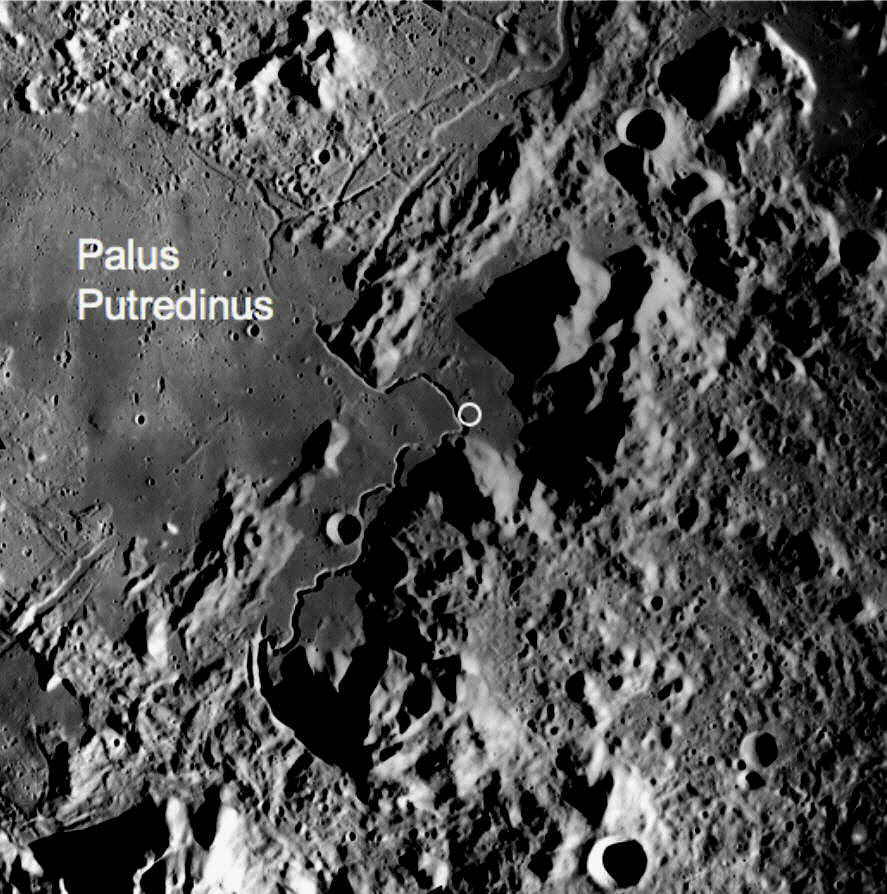
A photograph of Hadley Rille from an Apollo spacecraft, in orbit around the
Moon, cropped to cover the
same area as the previous photograph taken from Nambour, for comparison
purposes. The circle
shows the exact landing site. The camera is looking vertically down, so there is
no foreshortening.
This was the first mission to include an LRV
(lunar roving vehicle).
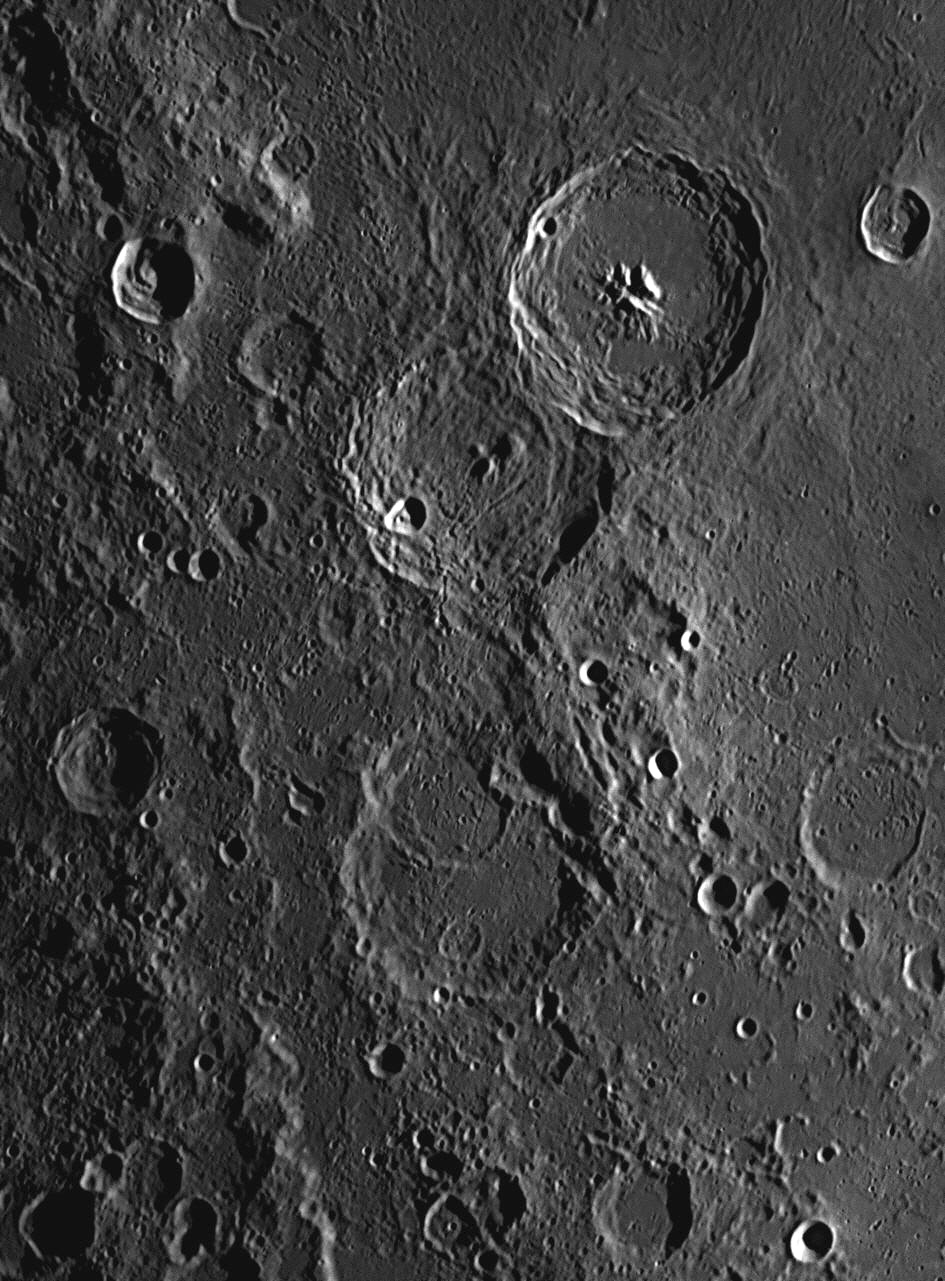
Theophilus (top),
Cyrillus and Catharina (bottom) were photographed from Starfield Observatory, Nambour
on July 30, 2017. East (where the Sun is rising) is to the right, north is at the top.
Of these three craters, Theophilus (top) is obviously the newest, for it is
more clearly defined and overlaps
Cyrillus. Catharina is the oldest of the
three, appearing much more degraded and damaged by continual impacts
by small
meteorites over billions of years, All three craters were named by Giovanni Riccioli
in the mid-17th century.
He was a Jesuit priest who knew his history of astronomy and astronomers very well,
and used this knowledge
when applying names to the lunar features. The names
were not chosen at random, and the three above were
named after people connected
with the lost Great Library of Alexandria.
Catharina has a diameter of 100 kilometres and a depth of 3130 metres. It has been damaged by a later impact
on its northern wall, which has produced a 46
kilometre wide crater, Catharina P. The walls of Catharina are
quite steep in places, but the rugged floor is reasonably flat with no large, central
mountains. The floor does
contain some small hills and fissures, and is disrupted in the south by a 16 kilometre crater called Catharina S.
Nearby, on
the southern wall of Catharina, there is a small, bright, bowl-shaped crater 7 kilometres across, Catharina F.

This photograph was taken 23 minutes after the preceding one on July 30, 2017,
which it adjoins. The
crater Catharina is at the top of the image. The Rupes Altai or
Altai Mountains is a 450 km long cliff or
fault escarpment which runs in a huge curve from west of Catharina to the 90 km
crater Piccolomini
at the lower-right corner. The cliff averages 700 to 1000 metres in height,
with some summits approaching
2 km high. One peak is 4 km high.
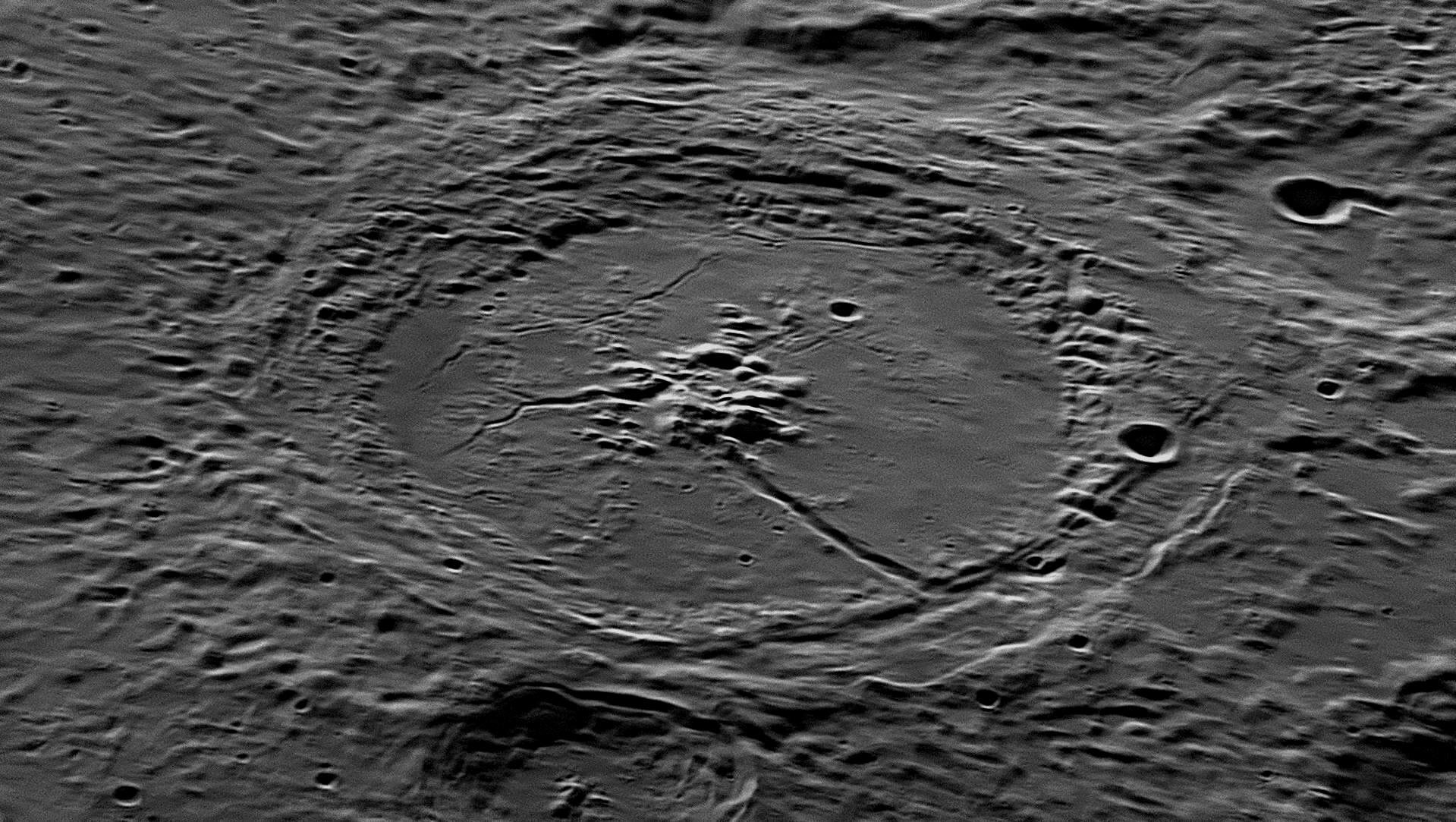
The crater Petavius has a diameter of 182 kilometres and this photograph was taken from Starfield Observatory,
Nambour on September 14, 2018. East (where the Sun is rising) is to the top, north is to the left. As Petavius is near
the south-east limb of the Moon, we see the crater at an angle, which foreshortens its circular shape into an ellipse.
On the southern wall of Petavius (on the right in the picture above, is an 11 kilometre wide crater, Petavius C.
The most spectacular cleft on the Moon runs in a straight line from the central mountain group to the south-west wall.
In this view, the Great Cleft is seen to be relatively shallow in places.
In the foreground is the 60 kilometre wide crater Wrottesley.
A peculiar double ridge 200 kilometres long
passes
through Petavius C and skirts the end of the Great Cleft, terminating near
Wrottesley. Behind Petavius
(to the east)
is the 42 kilometre wide
crater Palitzsch, with the 114 kilometre Vallis Palitzsch (Palitzsch Valley)
running to the
north (left), outside the far
wall of Petavius.
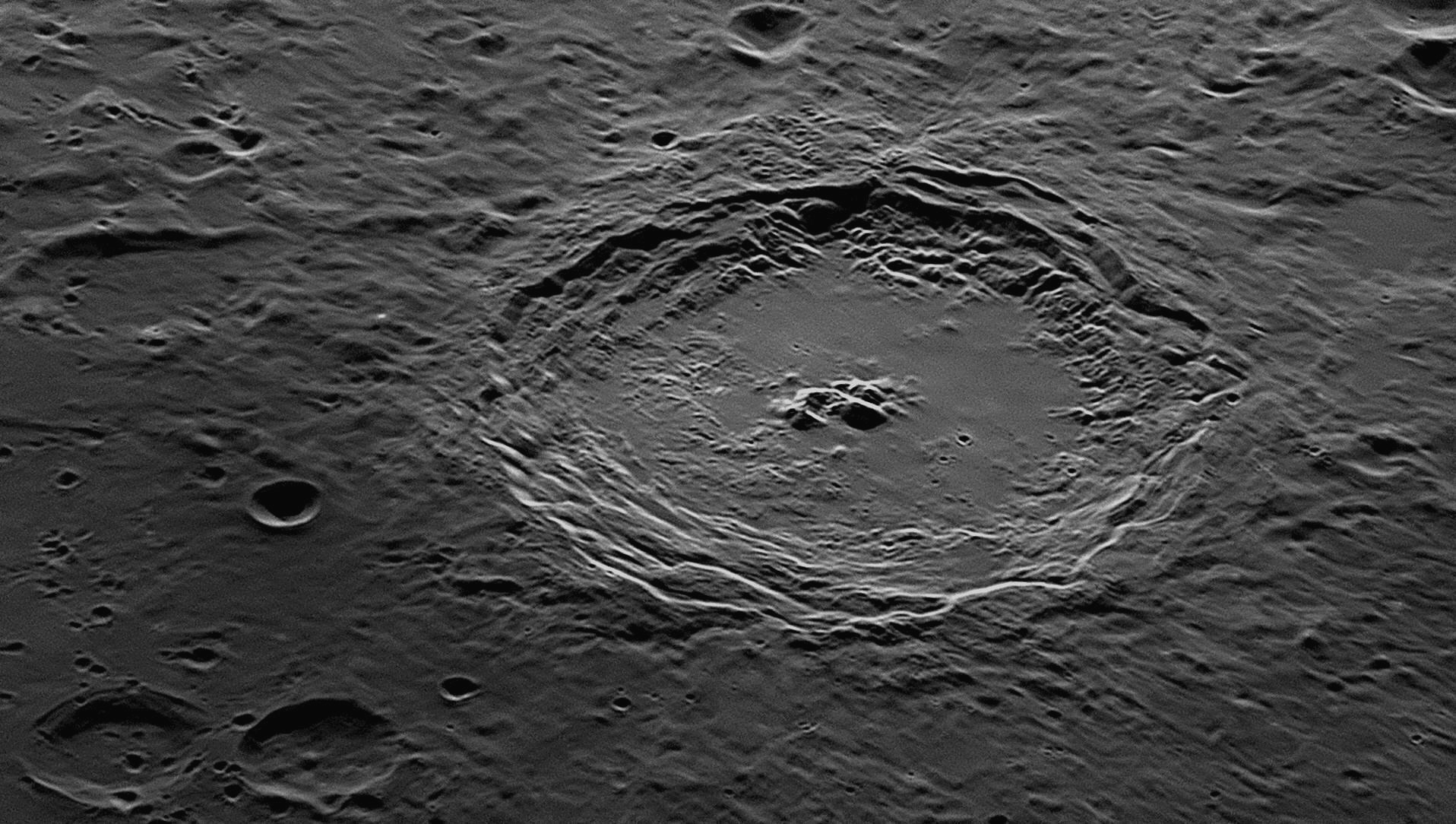
The crater
Langrenus has a diameter of 136 kilometres. Like Petavius above, this photograph was taken
from Starfield Observatory, Nambour on September 14, 2018. The orientation
and foreshortening of Langrenus
is similar to that of Petavius above, for they are near neighbours on the Moon.
The central cluster of
mountain peaks averages one kilometre in height. The north-western area of the
floor is rough, while the
southern half is much smoother. The walls have slumped down to make spectacular
terraces. Outside
the crater, the landscape has been covered with melted rock from the impact.
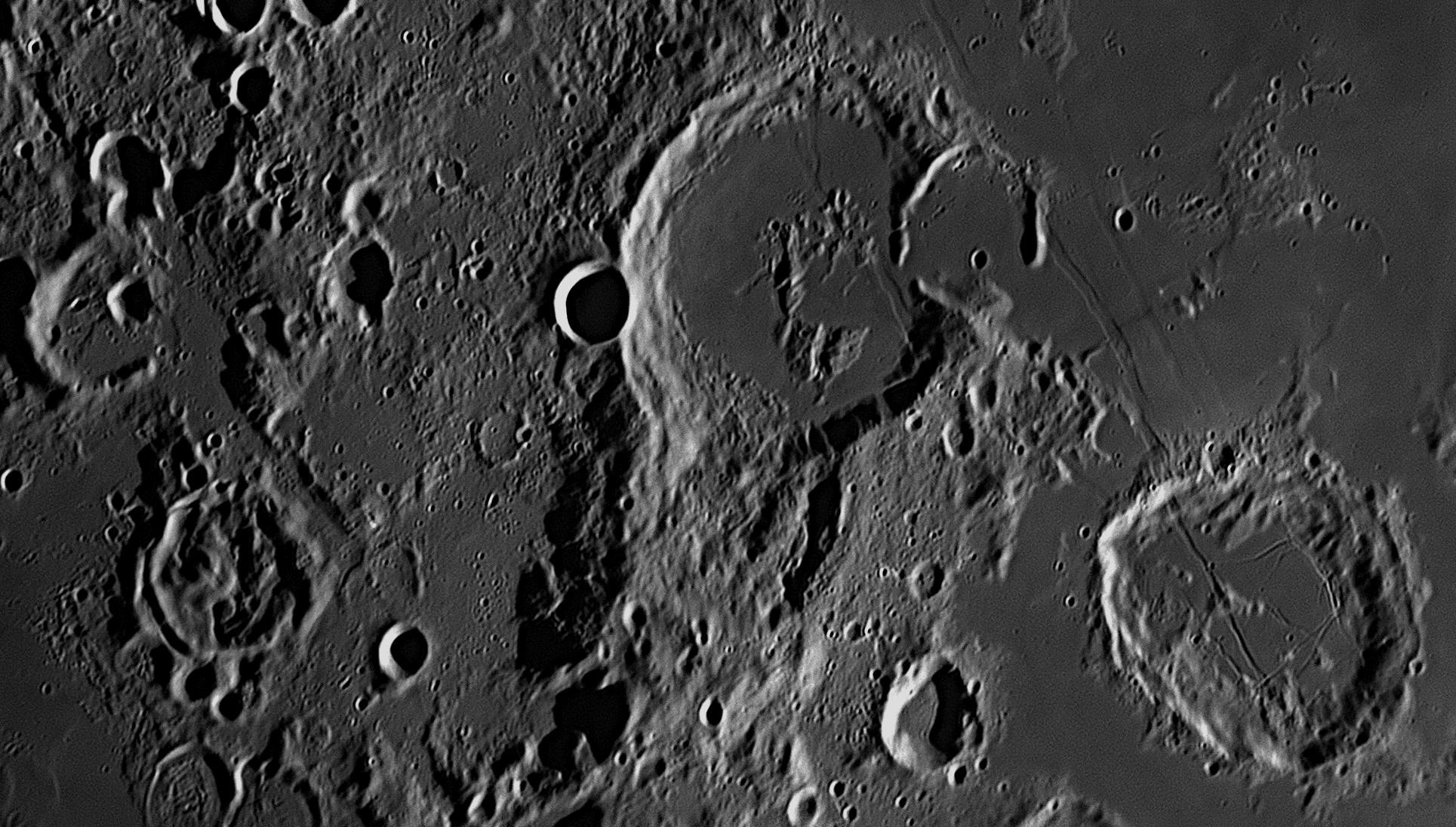
This image of the south-western margin of the Moon's Mare Fecunditatis (Sea of Fertility) was taken at
5:19 pm on 18 July 2018,
just five minutes after sunset. A deep red filter was used to counteract the light
of the sky. North is to the top, east (where the Sun is
rising) is to the right. The central crater is 77 km
diameter Gutenberg. To its south-east is the 56 km crater Goclenius, which
is crossed by numerous
clefts.
Towards the lower left corner of the image is the 34 km crater Gauldibert, which has a very
unusual volcanic floor. The smallest craterlets clearly visible in this image, e.g. one just north of
the
mountain at the centre of Goclenius, are less than 600 metres across.
Smaller ones in the flat area
due west of Goclenius may also be detected.
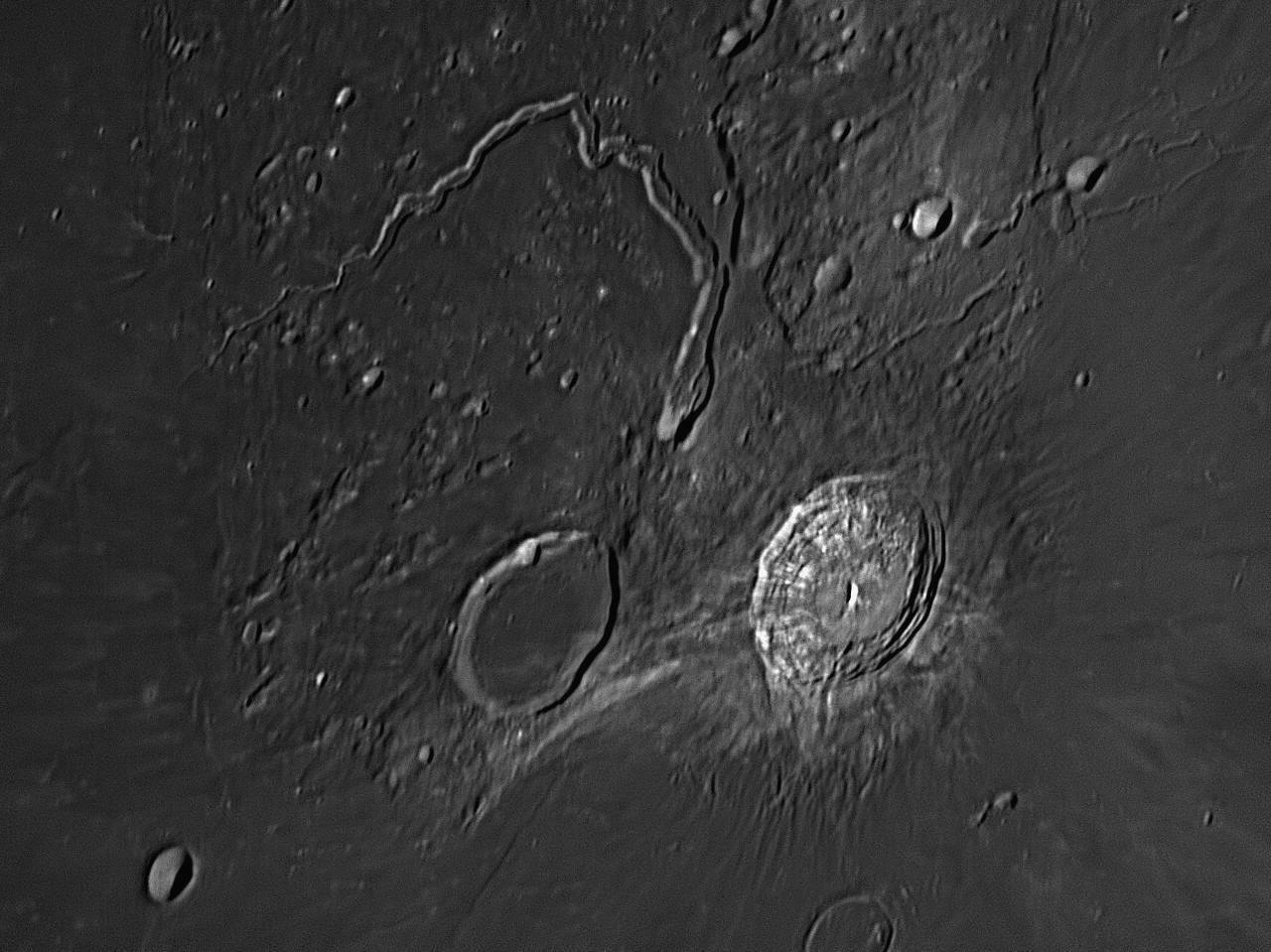
Aristarchus is the bright 41 km crater at right, Herodotus is the
flooded 36 km crater to its left.
Vallis Schöteri (Schröter's Valley) is the remarkable feature to their
north, and is 165 km long. The valley
begins at a small crater in the highlands between Aristarchus
and Herodotus, widens out and then narrows
again heading north, before zig-zagging to the north-west and then turning to the south-west, where it
narrows
further and peters out. It has been described as like a snake, in particular as a cobra, and its widest area
near its starting point has become
known as the 'Cobra Head'. A delicate rille 200 metres wide like a dry
water
course meanders along the valley, visible above for most of its length. There is
a complex of
narrow, winding rilles in the north-eastern corner of this image.
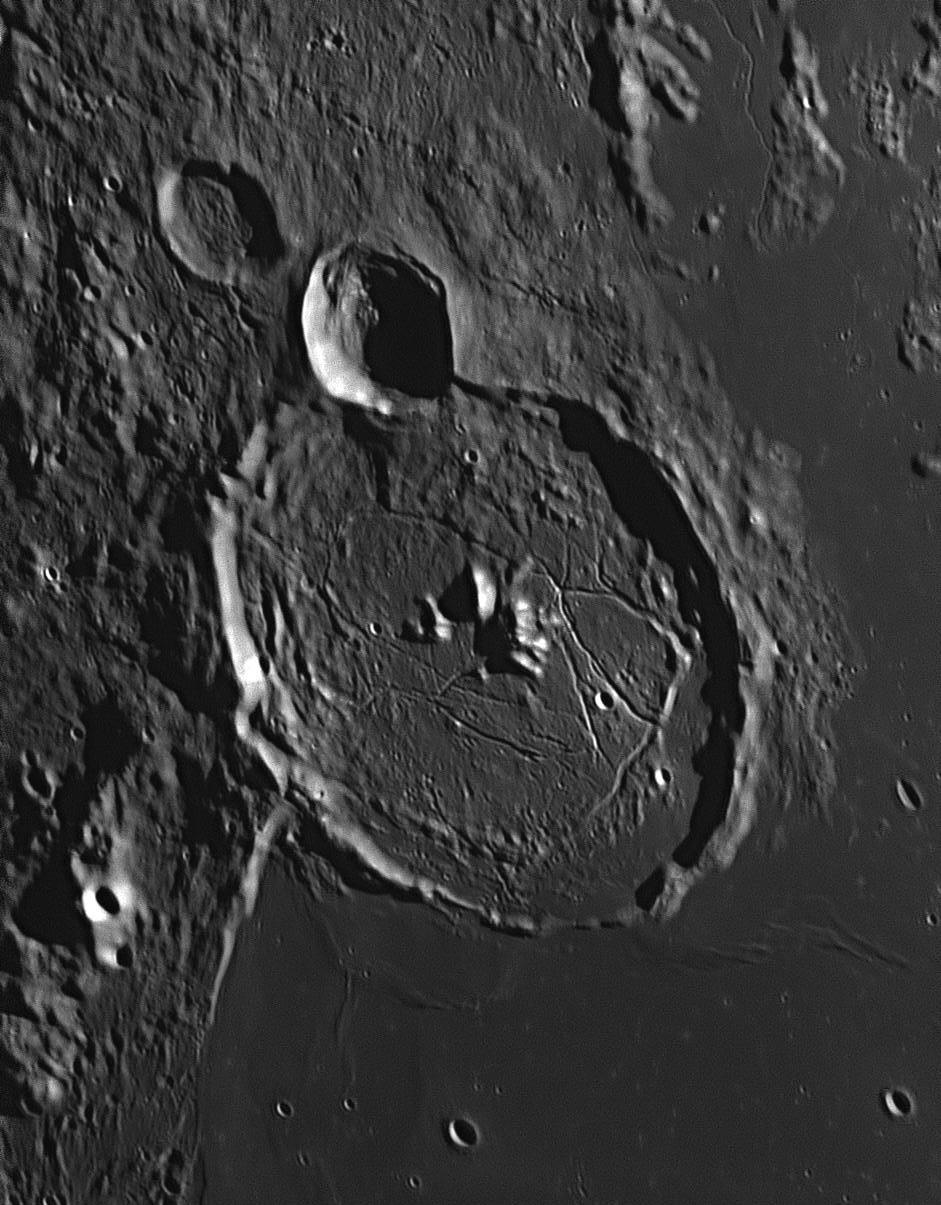
Gassendi was photographed from Starfield Observatory, Nambour on September 2, 2017.
North is to the top,
west is to the left. Gassendi is a moderately large crater, with a diameter of
114 km. It is completely
circular, but due to its position
towards the Moon's west-south-western limb, we see it considerably
foreshortened. It is quite ancient, and since it was formed by the impact of a large meteor or
small asteroid
about 3.9 billion years ago, a large more recent impact has deformed its northern wall (on the right-hand side
in the image above). This later crater is called Gassendi A, and is 33 kilometres across. Almost adjoining
it
on its north-western side is Gassendi B, which is 26 kilometres across. The floor of Gassendi is flat, with
a
group of mountains in the centre that average 1200 metres high. To the south is a large, flat lava plain called
Mare Humorum (the Sea of Humours).
The Mare Humorum was caused by an asteroid striking the Moon in
the epoch after Gassendi was formed.
This huge impact blasted out a crater 391 kilometres
across, fracturing the Moon's crust in the area. These
fractures released pressure on the hot rocky layers below, which immediately liquified, allowing
hot magma
to come to the surface as lava, which filled up the crater that had been formed, resulting in the large,
level
lava plain that was discovered and
named the "Sea" of Humours by Giovanni Riccioli in the mid-17th century.
As the lava spread out from the impact crater, much of it reached the southern wall of Gassendi, sweeping
over it and bursting
in to pool on the southern end of Gassendi's floor (to the left as seen in the image above).
We can see a gap in Gassendi's southern ramparts where the wall
has been completely demolished, and
other parts of the southern wall have been smoothed over by the lava. As the lava cooled, ripples in it became
solid, and
can be seen close to the south and south-east walls of Gassendi. The eastern, northern
and
western walls, unaffected by the lava flow, are rugged.
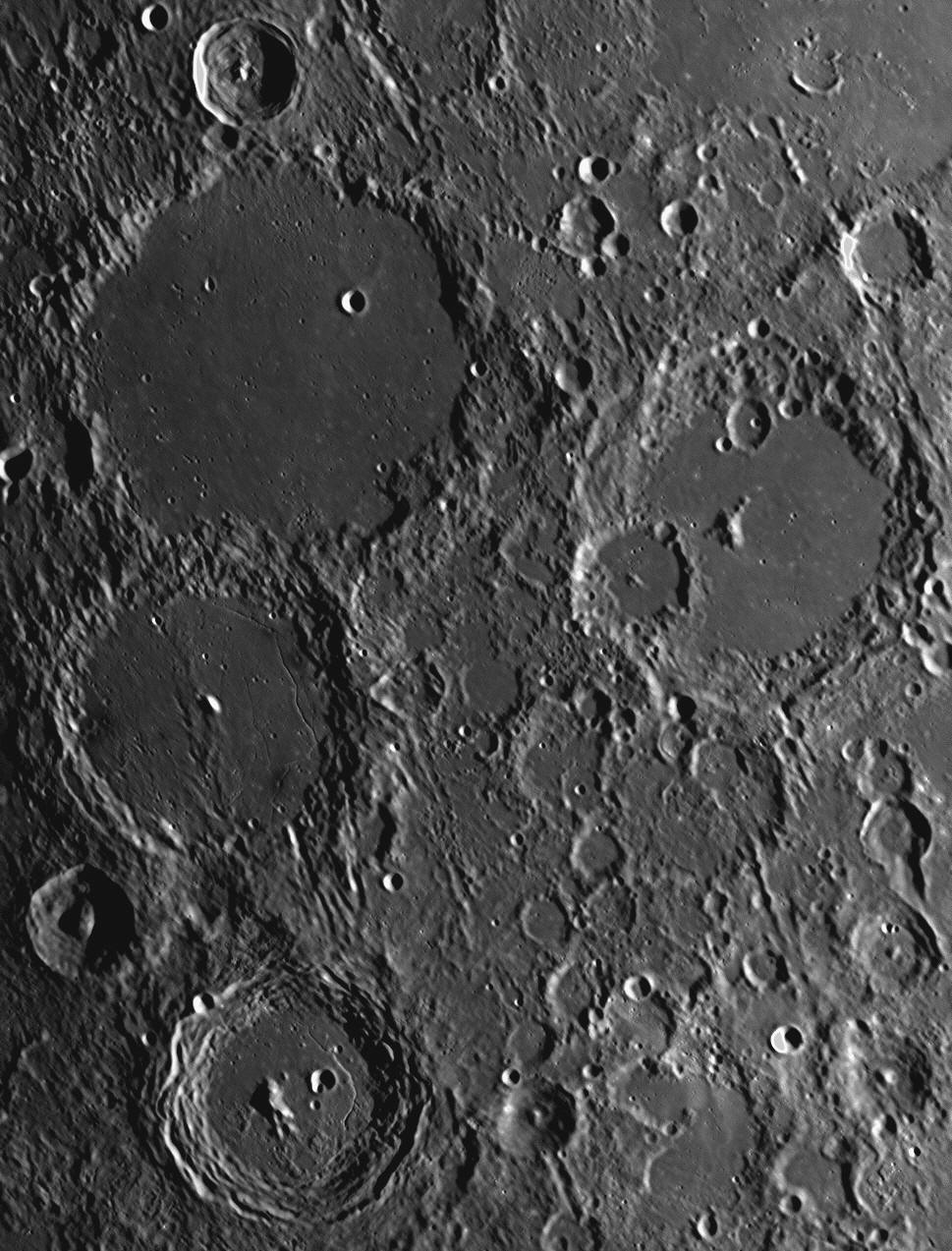
The three largest
craters above, which once were called ‘walled plains’, are near the centre of
the Moon’s
disc.
Above centre is the large walled
plain, Ptolemæus, which has a diameter of 145 km. Its flat floor
is marked
by numerous craterlets. South of Ptolemæus is another crater plain,
Alphonsus, which is
121 km in diameter and has a central peak protruding from a low 'spine'.
There are a number of ash volcanoes occurring along a cleft system around the
inside rim of Alphonsus.
Each has a dark halo of ash. To the
right of these two large craters is a third, Albategnius,
139 km in diameter.
Adjoining Alphonsus to the south-west is a 41 km crater called Alpetragius,
which has an unusually large domed
mountain at its centre.
South of Alphonsus is a smaller crater with a diameter of 100 km called
Arzachel. It has very steep slopes with
terraces where the walls have slumped. There is an off-centre mountain
mass which rises to a height of 1500 metres.
On the floor is a 10 km crater, Arzachel A. The southern slopes of this crater
are deformed by a later impact
which left a 4 km crater. Another 4 km crater, Arzachel K, is on the floor
slightly to the south of Arzachel A.
A network of rilles curves around the eastern part of Arzachel's floor.
The whole area of this image is damaged
by
material blasted across the surface
by a cataclysmic
explosion called the Imbrium Event. The damage
appears as grooves crossing
the
image
from
north-north-west to south-south-east, and is called 'Imbrium sculpture'.
The photograph was taken on August 1, 2017.
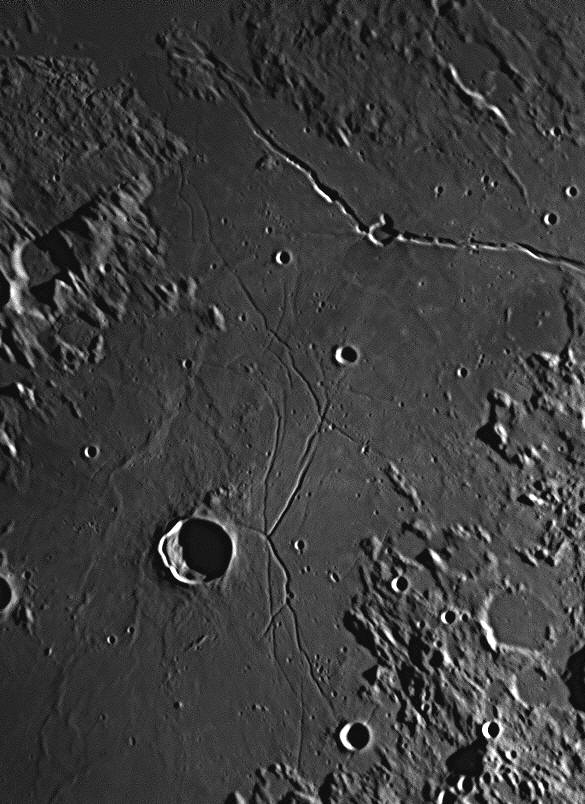
At top centre is the 6 km wide crater
Hyginus. Its northern wall is deformed by a 2 km wide smaller
crater. Passing
through Hyginus is a notable valley or rille, rather disjointed in outline,
appearing
in parts to be made up of chains of collapse craterlets. This area of
the Moon shows numerous
clefts, extending south past the crater Triesnecker at lower centre.
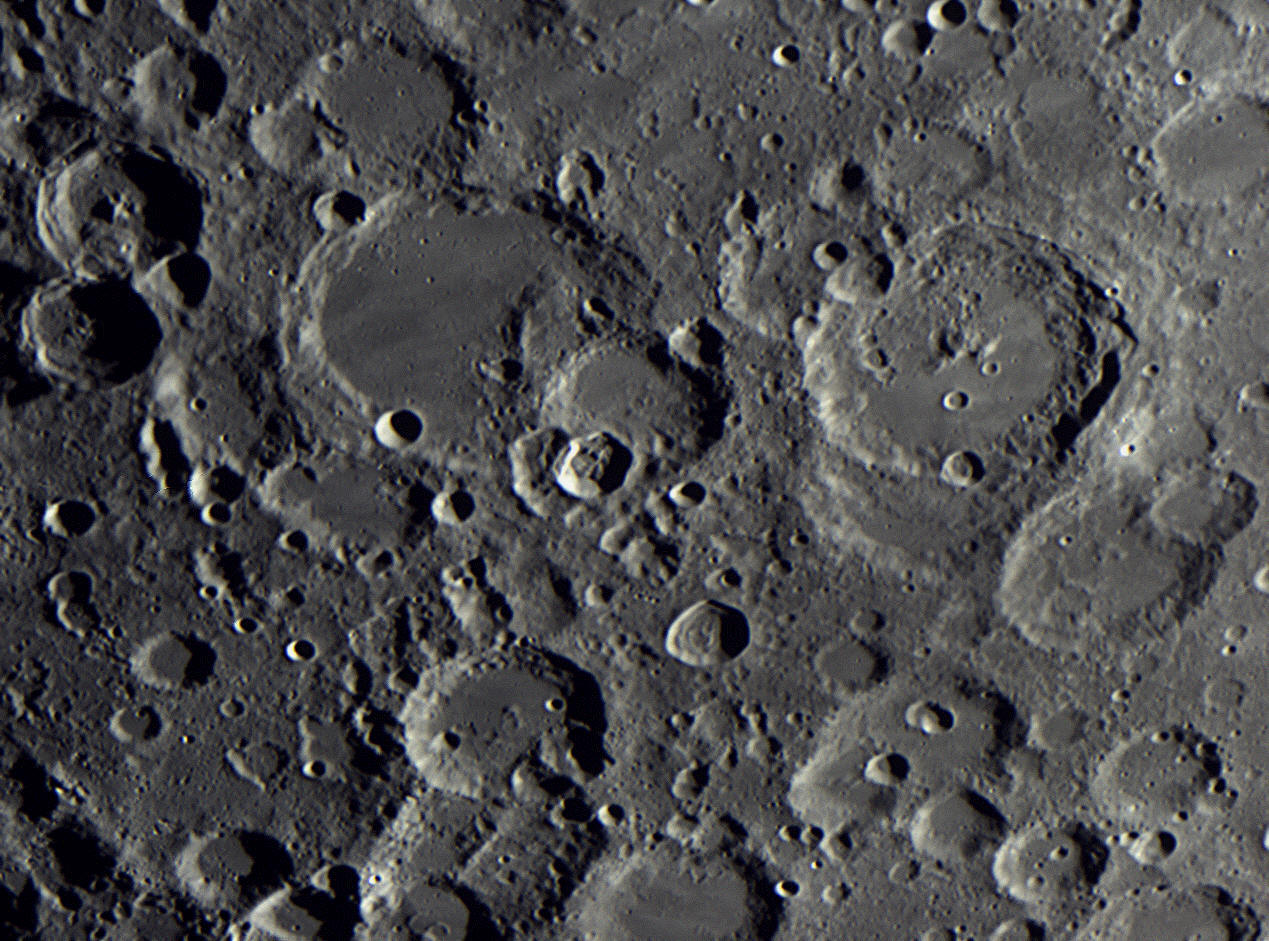
The
south-eastern quadrant of the Moon is covered with overlapping craters ranging
in size from large to
tiny. There are no lava plains (known as "Maria" or "seas" in the area. The two
largest craters in the image
above are Stöfler (left, deformed on its south-eastern rim by Faraday) and
Maurolycus.
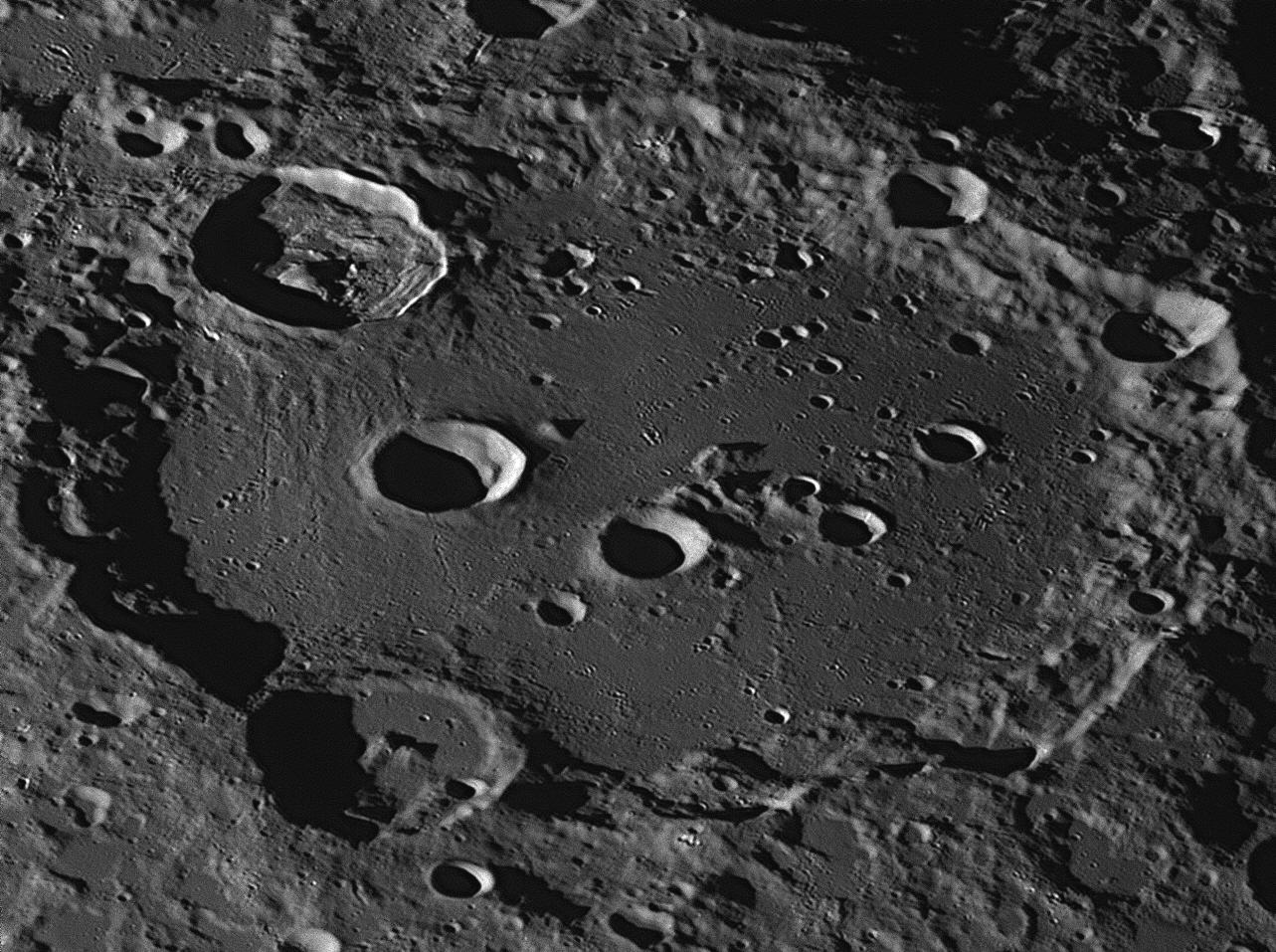
Dominating
this area is the
magnificent crater Clavius, 233 km in diameter. The walls rise in places
over
3.6 km above the floor. The slopes at lower right exhibit massive land
slips. A remarkable series
of
five craters begins on the southern wall (top) and
trends in ever-decreasing size towards the north,
then west (right).
The floor of Clavius is covered with numerous craterlets and other delicate
features.
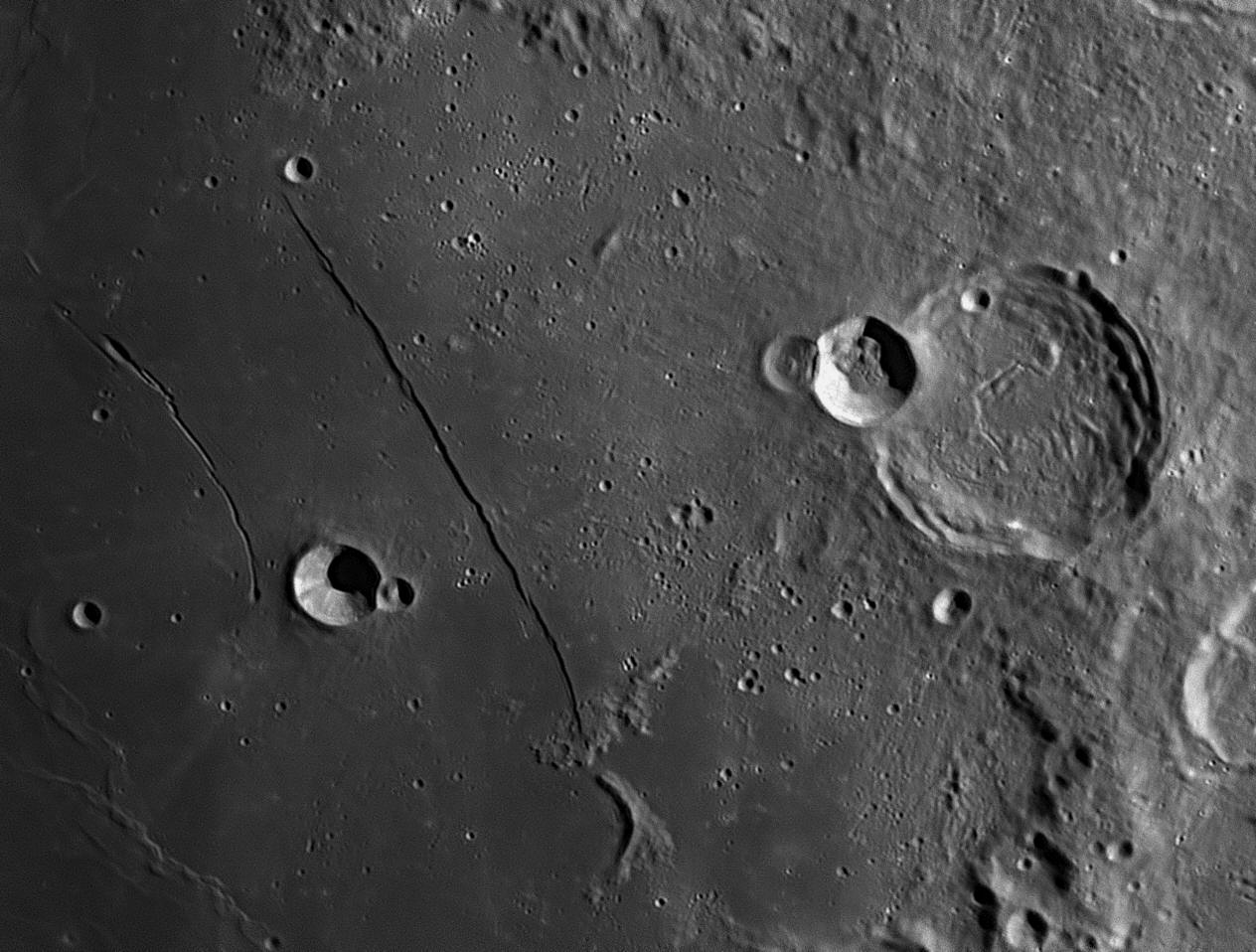
Rupes Recta, or the Straight Wall, is a long cliff in the Moon's Mare Nubium (Sea of Clouds).
100 km
long and 1 to 1.5 kilometres wide, it is a fault scarp.
Despite its appearance under a low Sun as above,
it is neither particularly high
nor steep. The eastern or right-hand side is about 250 metres higher than the
western, near the wall's mid-section. The slope is actually quite gentle,
some sources quoting as little as
seven degrees.
Also in the image are some craters. To the west (left) of the Wall, is the 17 km
crater Birt, the eastern rim
of which is deformed by the later impact that created 6.8 km Birt A. Starting in
a craterlet just to the west
of Birt is a curved rille called Rima Birt, which is 51 km long and turns to the
north-west before fading out.
It has a gap in its middle and a slight S-bend.
The large crater to the right of the image is 60 km Thebit which has a rille on
its floor which is unusual in that
it is composed of four straight sections joined at abrupt angles. Most
rilles are sinuous. Thebit A (20 km)
has deformed the western rim of the larger crater, and is itself deformed by
Thebit L (12 km).
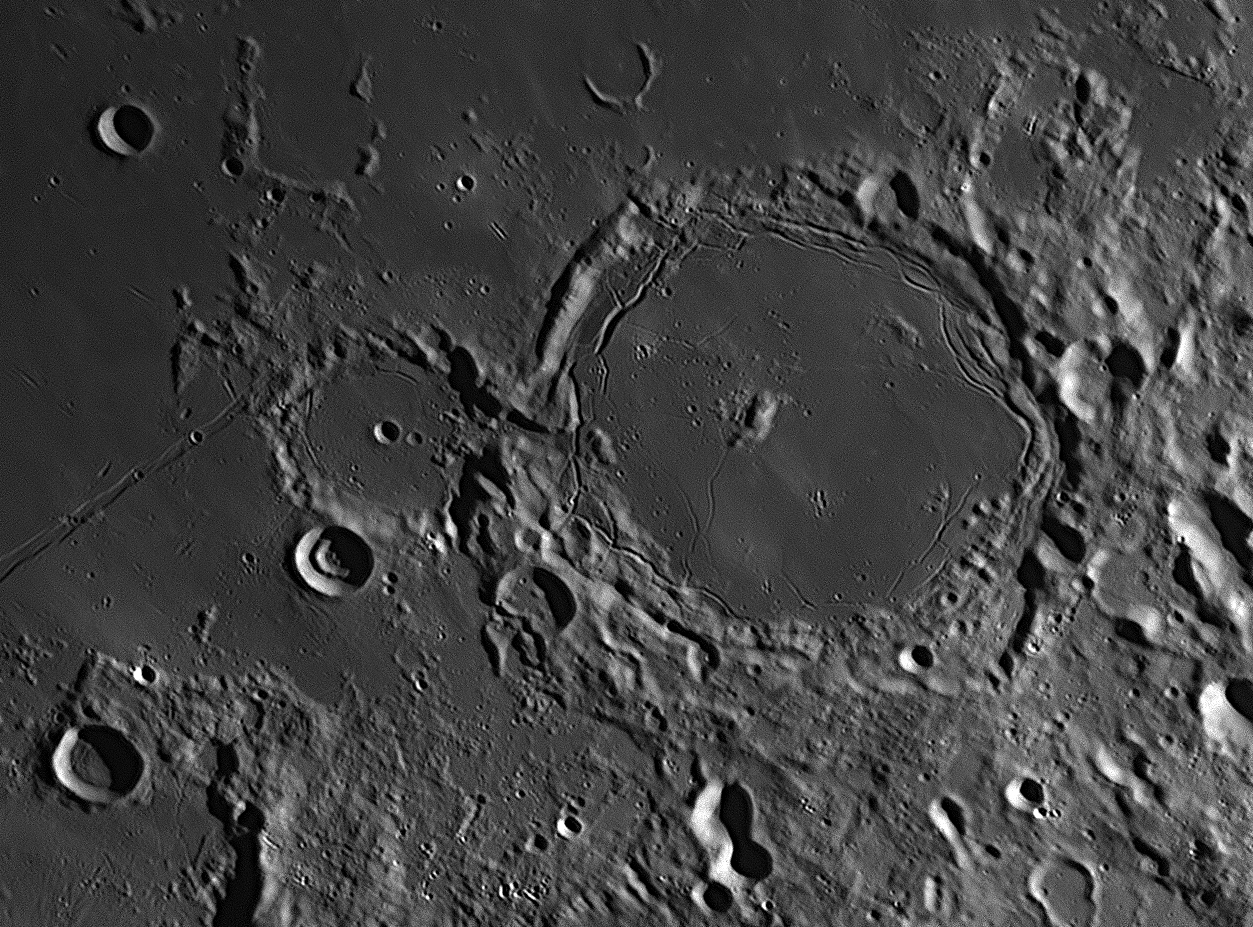
The
largest crater in this image is Pitatus which is 100 km in diameter. To its west
(left) is its 44 km
diameter neighbour Hesiodus.
Both of these craters have flat floors with multiple rilles
around their
circumferences. Pitatus has an off-centre mountain massif on its
floor, while that of Hesiodus has two
newer impact craters, both bowl-shaped.
There is an unusual valley joining the floors of Pitatus and
Hesiodus. A 12 km
'ghost crater', partially submerged by the lava flows from the north, is about
30 km
north of Pitatus, with another to the west. From the western ramparts of
Hesiodus, the 309 km long rille
called Rima Hesiodus runs to the
south-west and off the image. There are three craterlets visible on this
narrow
and shallow valley. They are so well-aligned on the rille that they are probably
volcanic vents associated
with the creation of the rille. It is unlikely that
random impacts from space could have landed together exactly
on the rille.
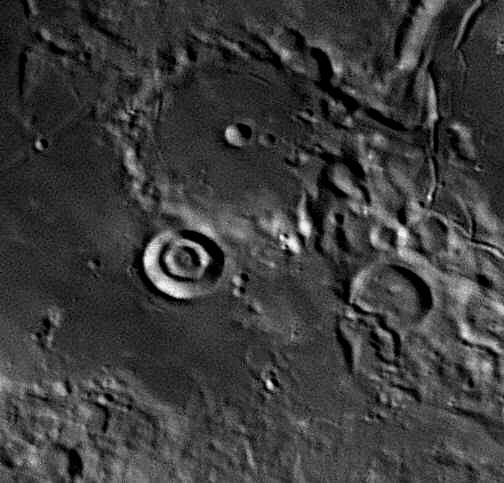
This image
shows the crater Hesiodus (above centre) when the Sun was higher, reducing the
shadows and flattening
the contrast. Adjoining Hesiodus to the south-south-west
is the 15 km bright crater Hesiodus A. This crater is
remarkable in that it
contains two concentric rings like a bulls-eye. The rings only become visible
when the Sun is
high enough
to shine over the steep walls and illuminate them.
The picture was taken on September 2, 2017.
The rings are only
partially visible
in the larger picture above, which was taken on August 2, 2017.

The crater Tycho is probably the youngest large crater on the Moon. Its diameter
is 88 km and it lies at the centre
of a spectacular system of light-coloured rays. The surroundings are covered
with areas of rock melt and
large angular blocks. The central mountain has three peaks and is 1.5 km high.
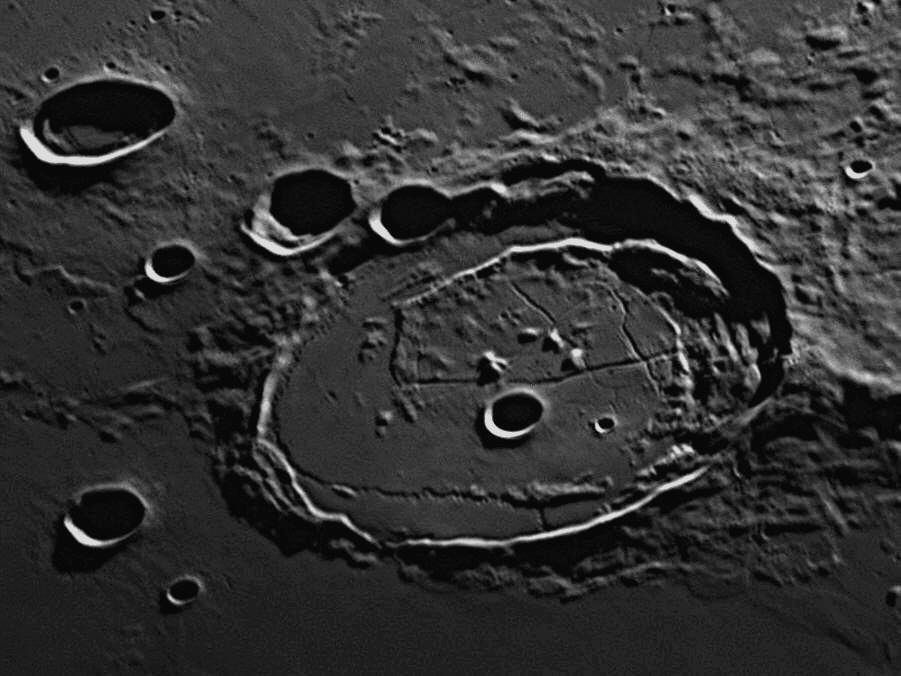
Posidonius is a large crater 99 km in diameter with a heavily fractured level
floor. This image was taken
on November 24, 2017. East is to the top, north to the left. There is a secondary rim
of mountains in the
eastern interior. The largest crater
inside Posidonius
has a diameter of 11 km and near
it is a fresh 3 km
crater and some
smaller craterlets.
There are also five
volcanic domes inside Posidonius and three more
outside. Of interest is the
very sinuous
and narrow rille
which starts just inside the northern rim and follows
the rim
to its north-western
curve, where
the rille suddenly turns towards the interior and heads south,
aiming for the
south-western wall.
A branch
turns to the right and heads directly to the western wall (lower
margin in the
image above).
Where the wall
is breached near the bottom margin, shadow reveals that
the floor of Posidonius is higher
than the level of
Mare Serenitatis outside the wall.
This area was photographed from Starfield Observatory, Nambour on May 6,
2017. East (where the Sun
More domes are found about 160 km south-east of Milichius in the area shown
here, which adjoins the one
These domes are only observable when the angle of sunlight is small, i.e.
the Sun is low to
the Moon's
This photograph of the Sinus Iridum (the Bay of Rainbows) and its environs was taken on December 29,
The Sinus Iridum is a very large feature, and is visible with the smallest telescope. It is bounded on the
There is a pair of remarkable impact craters in the south-eastern corner of the image. They are Helicon For the latest
photographs taken from Nambour, click on the
The Stars
is rising) is to the right, north is to the top. The largest crater in the image
above is Milichius, which is a
minor crater only 14 kilometres in
diameter. Milichius is surrounded by a great number of
volcanoes, in
the form of low domes. These are of a roughly circular shape, and
average only 200 to 300 metres high.
At the summit of each one is a volcanic crater, but all appear to be either
dormant or extinct.
Once it was thought that all the craters on the Moon were volcanic in origin,
for that is how craters on the
Earth are generally formed. Not until the
beginning of the 19th century did astronomers become aware
of huge rocky masses
flying through space that could impact the Moon, the Earth and other planets.
These rocks, as big as a truck or as big as Tasmania, were called 'asteroids'
(star-like) by William Herschel,
as in the telescope they are simply points of light, but they are now called
SSSBs (Small Solar System
Bodies) a name they share with comets and meteors. 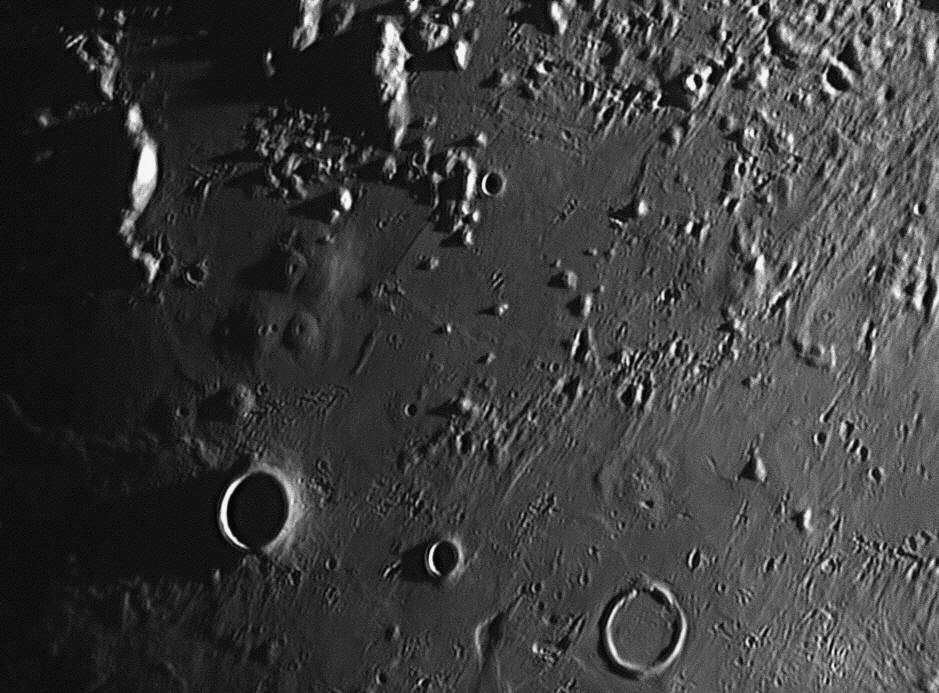
above it. The largest crater in this image is Hortensius, 15 km in diameter,
towards the lower-left corner
and filled with shadow. There is a fine cluster
of eight domes, most with volcanic vents at their summits,
just north of Hortensius.
Their heights range between 300 and 400 metres. Six of the domes are quite
prominent - the other two a
little more difficult. There are another three domes
elsewhere in the
image - can you find them?
horizon. This produces shadows which reveal the nature of the domes,
which appear as low blisters.
As the Sun rises over the Moon, the shadows
diminish and soon disappear
entirely, the only remaining
features to be observable being the tiny crater vents
at the top of most of them.
These vents rarely exceed
1000 metres in diameter.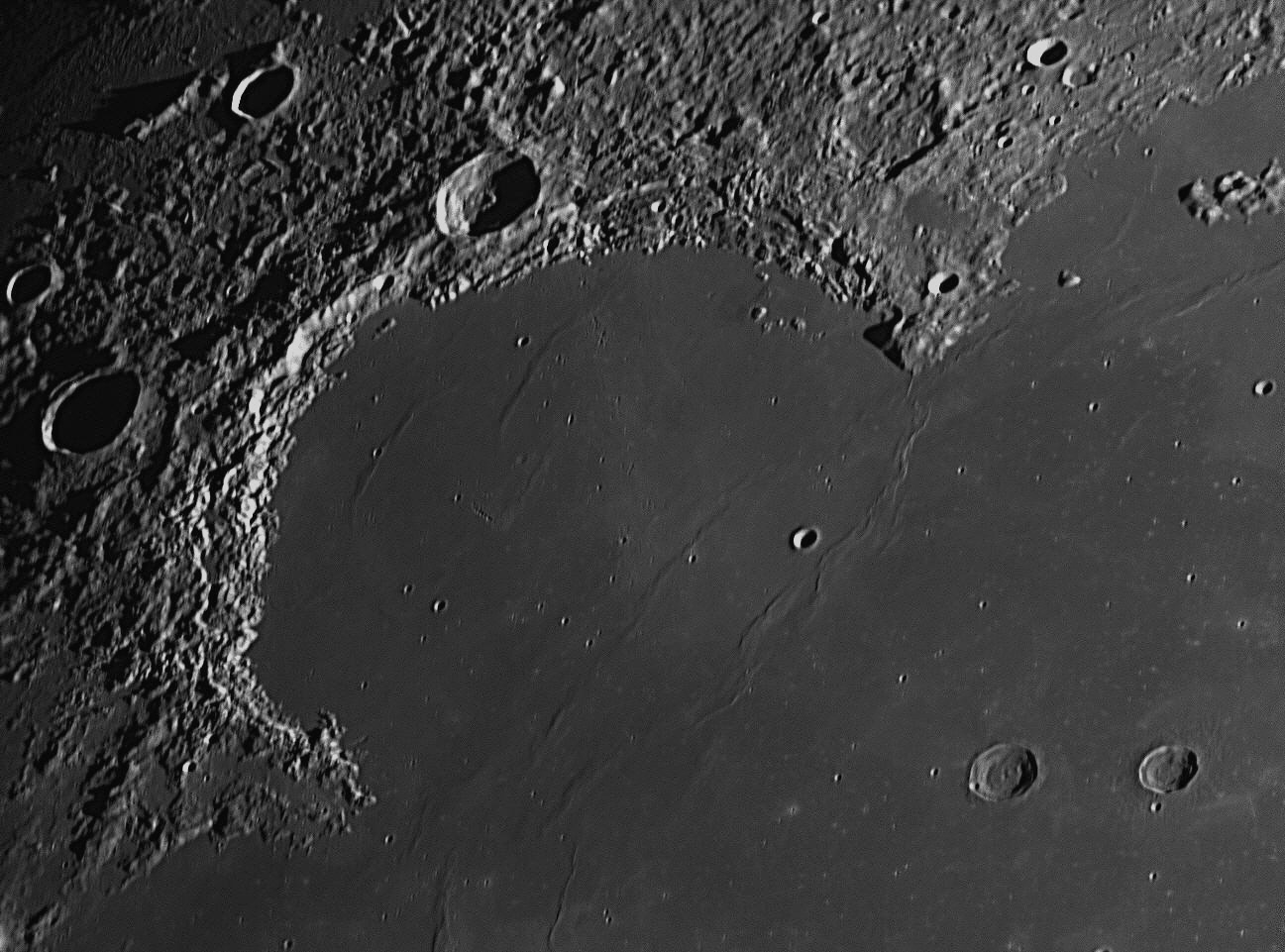
2017. North is to the top and west is to the left.
The Bay is a large semi-circular formation in the north-
western part of the Mare Imbrium, (the Sea of Rains).
north-east by the
Promontorium Laplace (Laplace Promontory) and on the south-west by the
Promontorium Heraclides (Heraclides Promontory).
The mountainous western rim of the Bay is
called the Montes Jura or Jura Mountains, named after a range near the Alps, on the border between
France and Switzerland. The Bay is 411 kilometres across. It has been filled with molten lava from the
Imbrium Event about 3.8 billion years ago,
which created the Mare Imbrium. As the lava cooled, waves in its
surface solidified and can be seen in the image above as 'wrinkle ridges', of which
there are more than ten.
The Bay was not completely filled, as its surface is about 600 metres lower than that of the adjoining Mare Imbrium.
(left, 26 km across), and Le Verrier (20 km across). Helicon was a Greek Astronomer who was active around
400 BCE.
Le Verrier was the man "who discovered Neptune by the point of his pen", i.e. by
mathematical
calculation, not by
using a telescope.

Dog Star. It is a very hot A0 type star, larger than
our Sun. It is bright because it is one of our nearest
neighbours, being only 8.6 light years away. The four spikes are caused by the secondary mirror
supports
in the telescope's top end. The faintest stars on this image are of magnitude 15.
To reveal the companion
Sirius B, which is currently 10.4 arcseconds from its
brilliant primary, the photograph below was taken
with a
magnification of 375x, although the atmospheric seeing conditions in the current
heatwave were more
turbulent. The exposure was much shorter to reduce the overpowering glare
from the primary star.
hotter and brighter, its companion Sirius B is very tiny, a white dwarf star nearing the end of its life.
Although small, Sirius B is very dense, having a mass about equal to the Sun's packed into a volume
about the size of the Earth. In other words, a cubic
centimetre of Sirius B would weigh over a tonne.
Sirius B was once as bright as Sirius A, but reached the end of its lifespan on the main sequence
much
earlier, whereupon it swelled into a red giant. Its outer layers were blown away, revealing
the
incandescent core as a white dwarf. All thermonuclear
reactions ended, and no fusion reactions
have been taking place on Sirius B for many millions of years. Over time it will radiate its heat
away
into space,
becoming a black dwarf, dead and cold. Sirius B is 63000 times fainter than
Sirius A.
Sirius B is seen at position angle 62º from Sirius A (roughly east-north-east,
north is at the top), in
the
photograph above which was taken at Nambour on January 31, 2017.
years after Alvan Graham Clark discovered Sirius B in 1862
with a brand new 18.5 inch (47 cm)
telescope made by his father, which was the
largest refractor existing at the time.
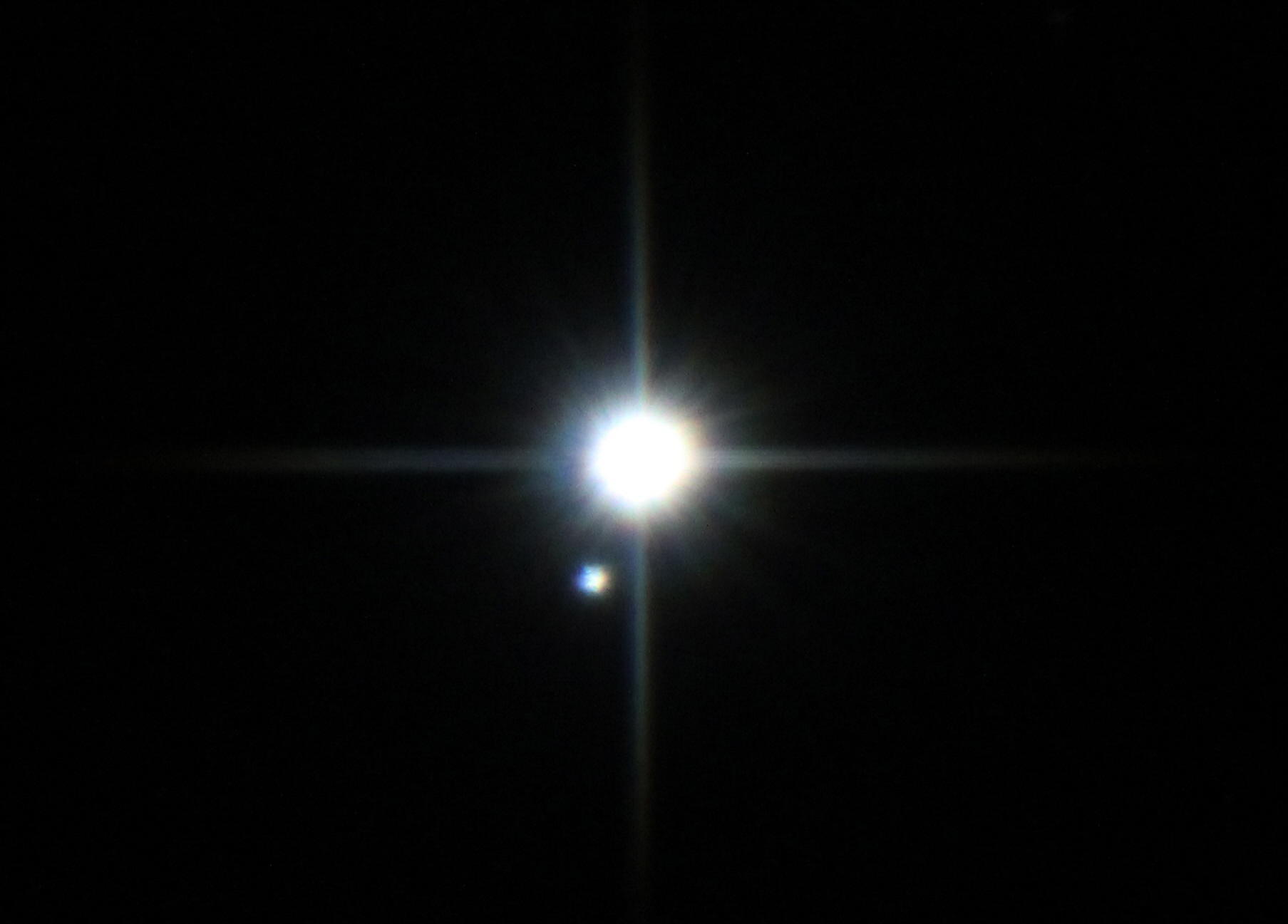
Rigel (Beta Orionis, left) is a
binary star which is the seventh brightest star in the night sky. It is huge
when compared with Sirius. Rigel A
is a large
white supergiant which is 500 times brighter than its
small companion, Rigel B.
Yet Rigel B is itself composed or a very close pair of Sun-type stars that
orbit
each other in less than 10 days. Each of the two stars comprising Rigel B is
brighter in absolute
terms than Sirius. The Rigel B pair orbit Rigel
A at the immense distance of 2200 Astronomical Units,
equal to 12 light-days.
(An Astronomical Unit or AU is the distance from the Earth to the Sun.)
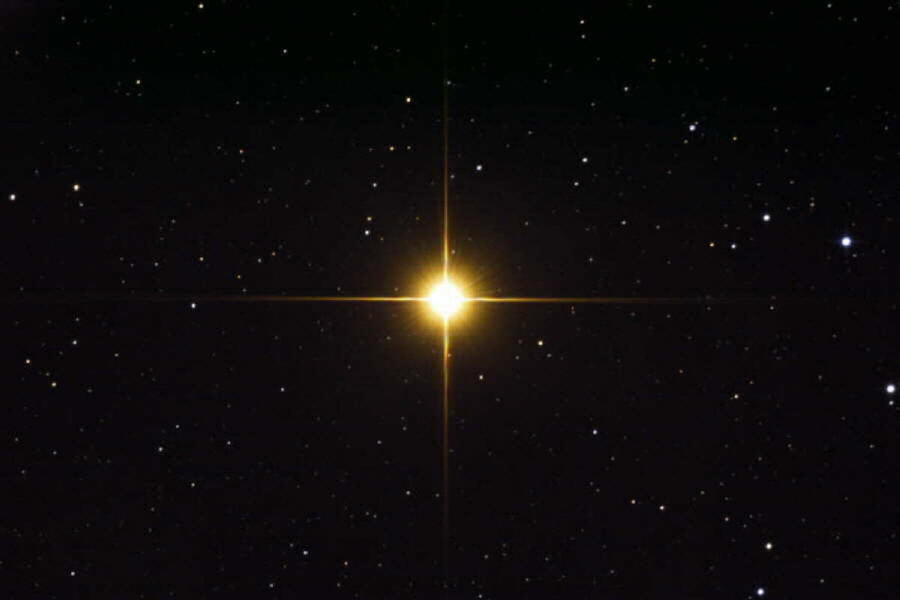
Antares, a red supergiant star
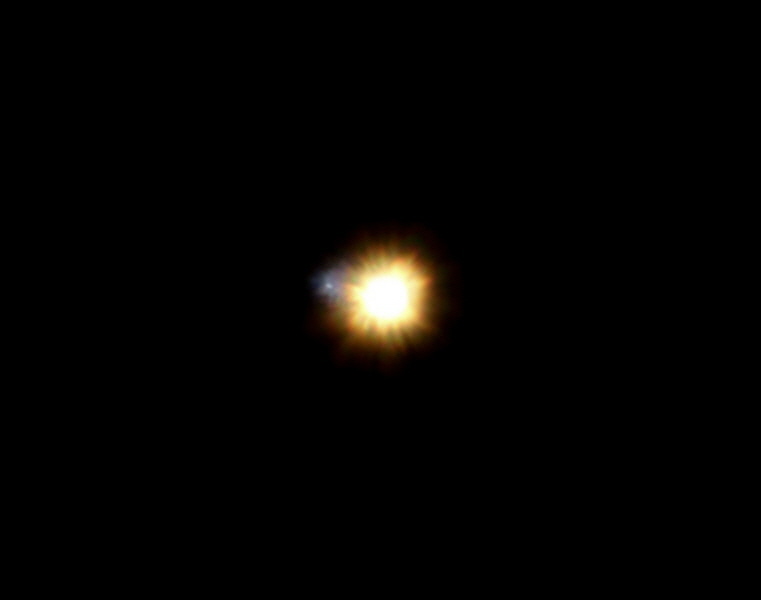
The star which we call Antares is a binary system. It is dominated by the great red supergiant
Antares A
which, if it swapped places with our Sun, would enclose all the planets out to Jupiter inside itself.
Antares A is accompanied by the much smaller
Antares B at a distance of between 224 and 529 AU -
the estimates vary. (One AU or Astronomical Unit is the distance of the Earth from the Sun, or about
150
million kilometres.) Antares B is a bluish-white companion, which, although it is dwarfed by its
huge
primary, is actually a main sequence star of type B2.5V,
itself substantially larger and hotter than our
Sun or Sirius. Antares B is difficult to observe as it is less than three arcseconds from Antares A and
is swamped in the
glare of its brilliant neighbour. It can be seen in the picture above, at position angle
277 degrees (almost due west or to the left) of Antares A. Seeing
at the time was about IV on the Antoniadi
Scale, or in other words below fair. Image acquired at Starfield Observatory in Nambour on July 1, 2017.
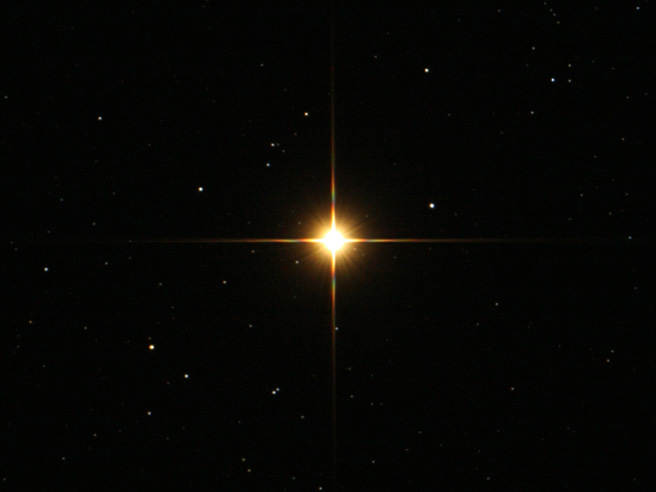
The red supergiant star Betelgeuse (Alpha Orionis) is almost a twin of Antares, but has no companion.

Achernar is the ninth brightest star in the night sky. Its visual magnitude ( mv) is 0.45, and it is a hot
blue-white star of B3 spectral type. The
width of the field is 24 arcminutes and the faintest stars are mv 15.
As it is in the extreme southern sky, it is the only first magnitude
star unknown to the ancient Greeks.
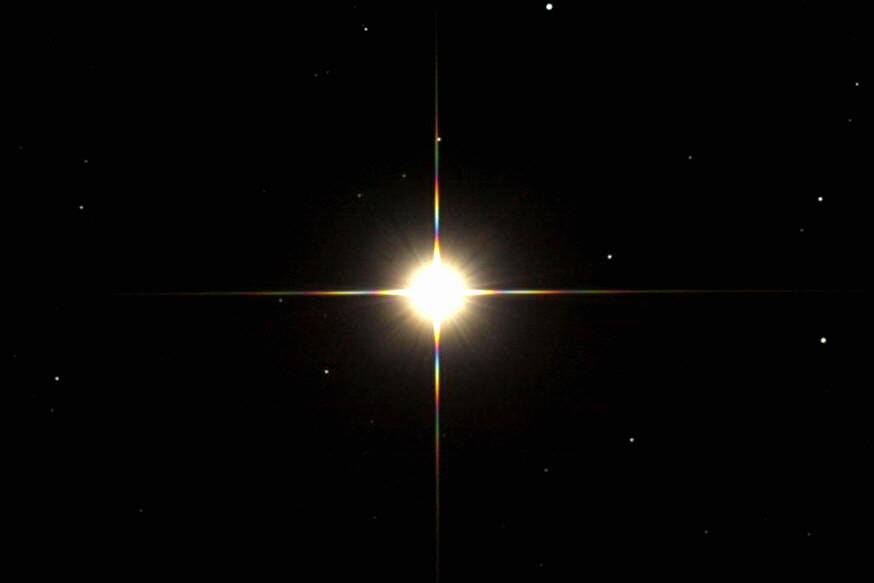
Arcturus, an orange K2 giant star, magnitude -0.05.
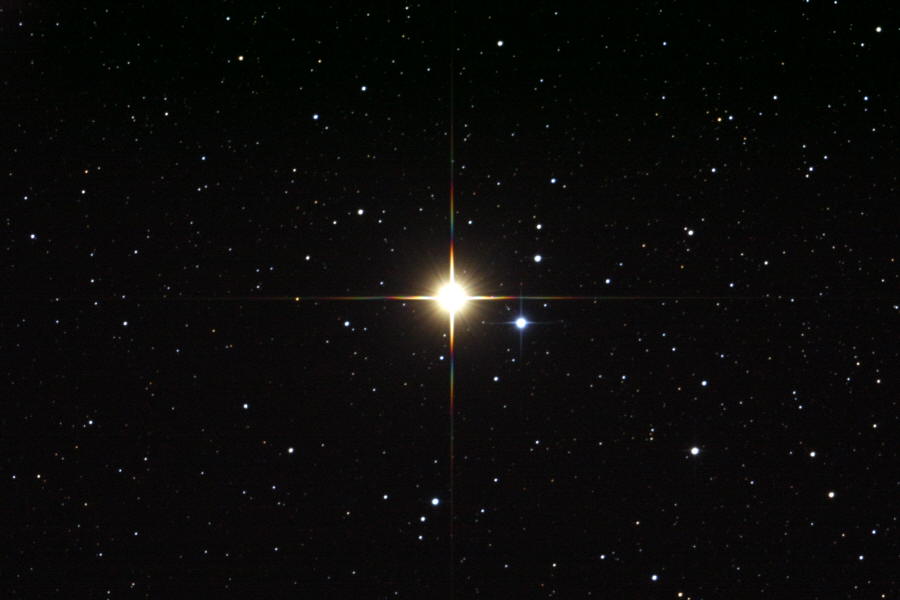
Gamma Crucis is a red star at the top of the Southern Cross. It shines at magnitude 1.59, and is a giant
star of type M4. The
white star seen just to lower right of the main star is a sixth magnitude companion,
in orbit around the system's barycentre.
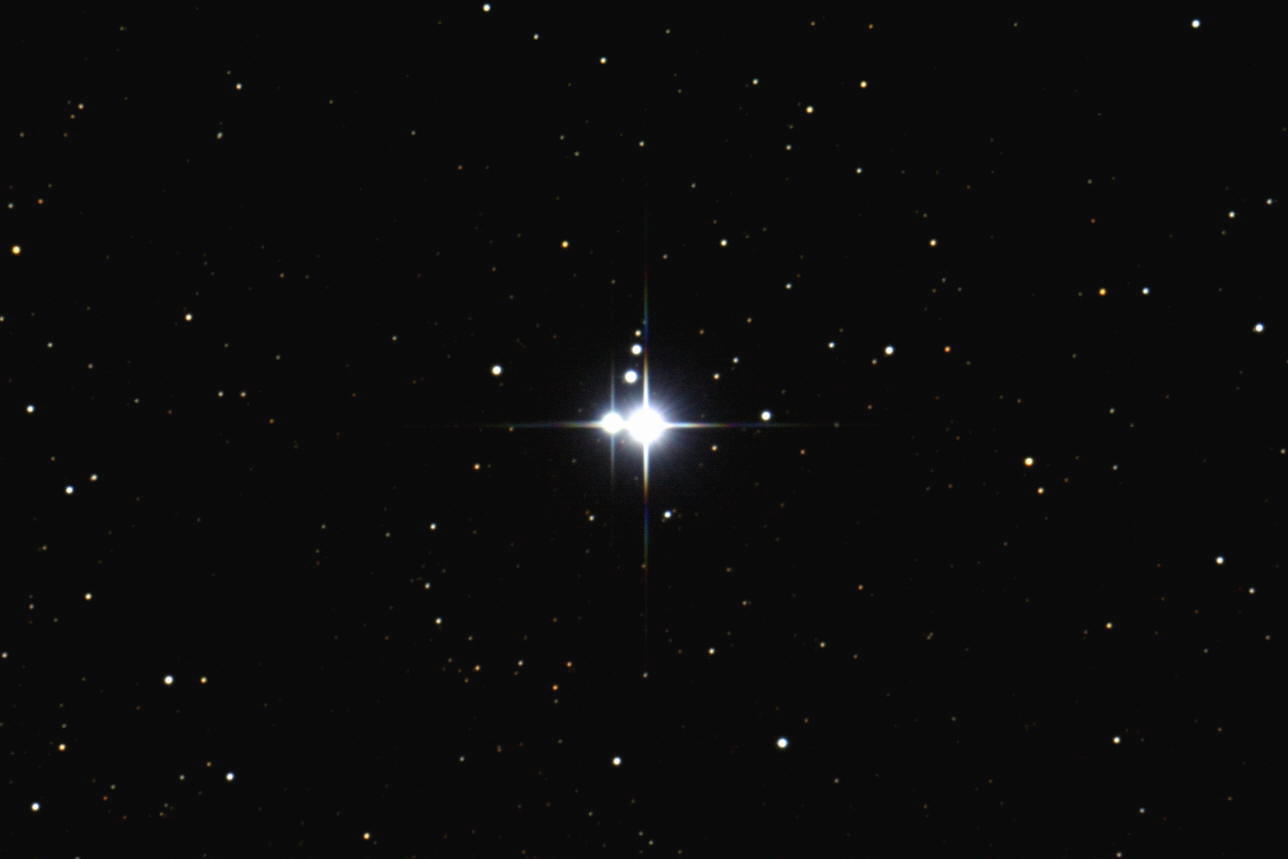
The star Regor, properly called Gamma Velorum. There are at least four stars in the
system. The brightest
star in the image above, Gamma Velorum A, is itself a binary or double star composed of a blue
supergiant
and a massive Wolf-Rayet
star. They are too close to be split optically, being closer than Mercury is to our Sun.
Their double nature is only revealed by examination of their combined
spectrum.
The second component
to its left, Gamma Velorum B, is also a spectroscopic binary, with a period of
less
than two days. The main star in this
pair is a blue-white giant, and it is so close to its companion that the
spectrum of the companion is swamped by the other. Wolf-Rayet stars have strong
emission lines in their
spectra and will end their lives with Type 1b supernova explosions. The one in Gamma Velorum A is one of
the closest supernova
candidates to the Sun. The star's name "Regor" is not ancient nor exotic,
but honours
the Apollo astronaut Roger Chaffee, and is simply 'Roger' spelt
backwards. It was devised by one of the other
astronauts, Virgil "Gus" Grissom, and is not officially approved. It is allowed to be used as both Chaffee and
Grissom, along with the third crew member Ed White, died in the Apollo 1 pre-launch fire in 1967.

The optical double star Mu Scorpii, halfway along the body of Scorpius, is a useful test of keen eyesight,
being only 6 arcminutes apart. Though the two components look similar, it is only a chance alignment,
not a true binary system. The stars are not related in any way. The
upper star of the two is an eclipsing
binary 822 light years distant, while the lower star, a blue-white subgiant, is only 517 light years away.
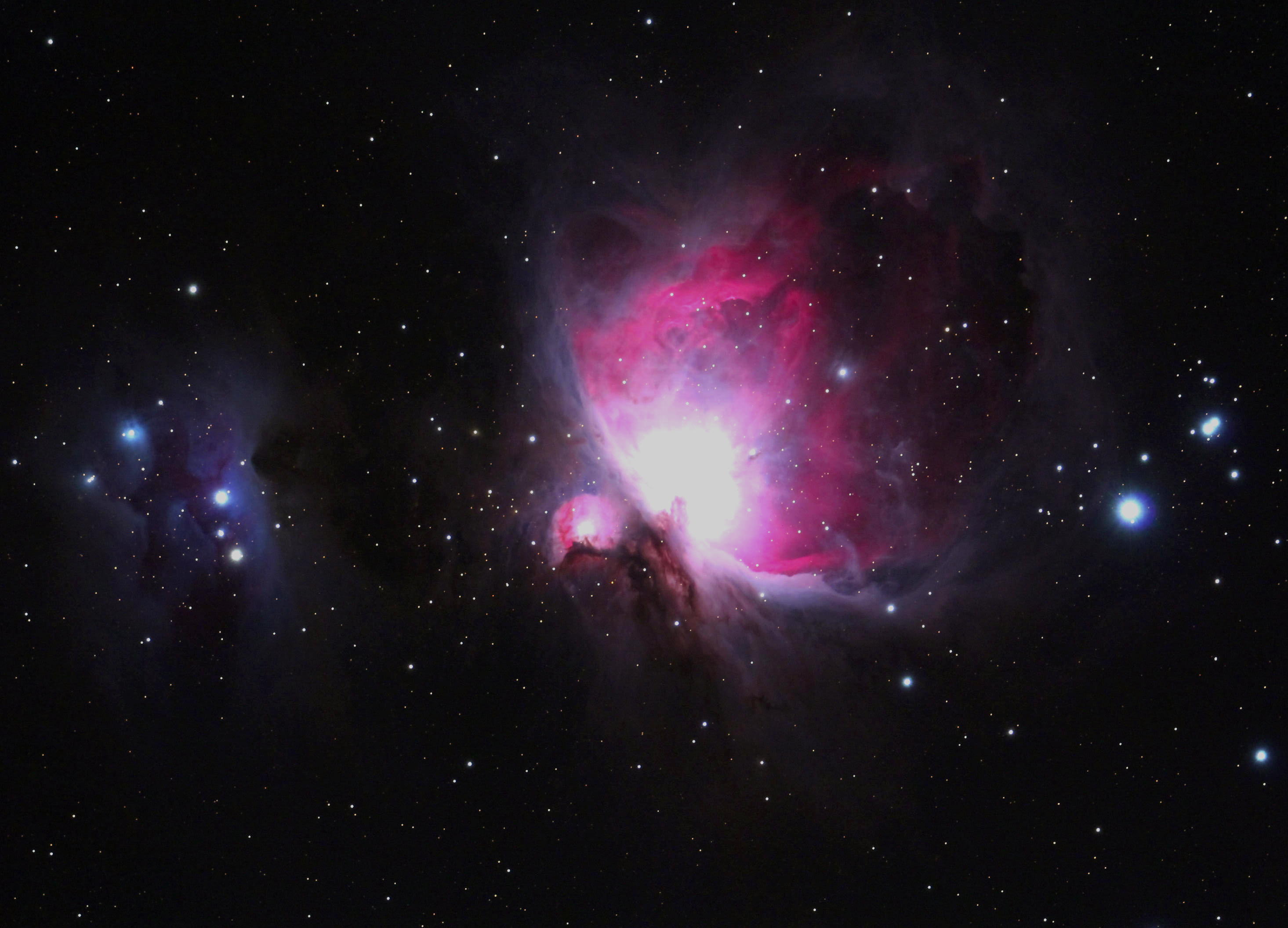
A typical nebula, where hydrogen gas is condensing into stars. The Great Nebula in Orion, M42, with its
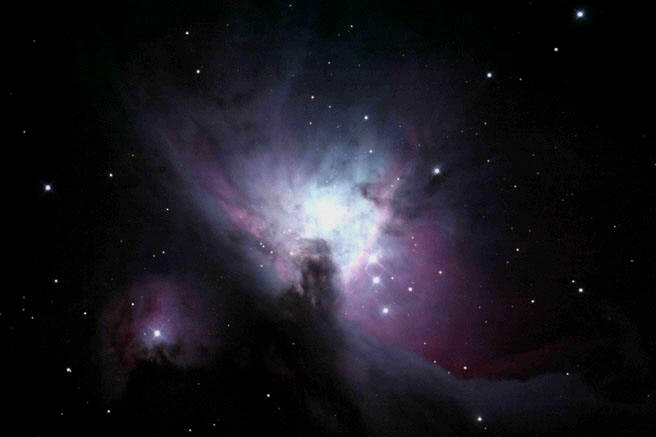
The central section of the Great Nebula in Orion.
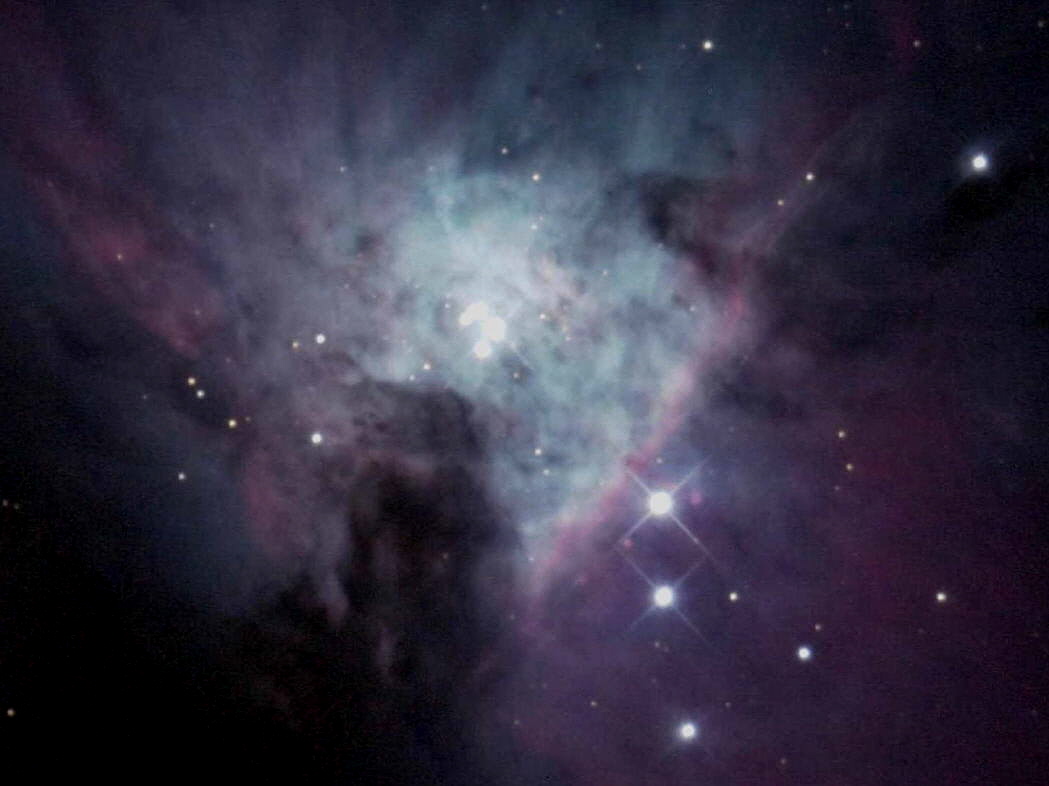
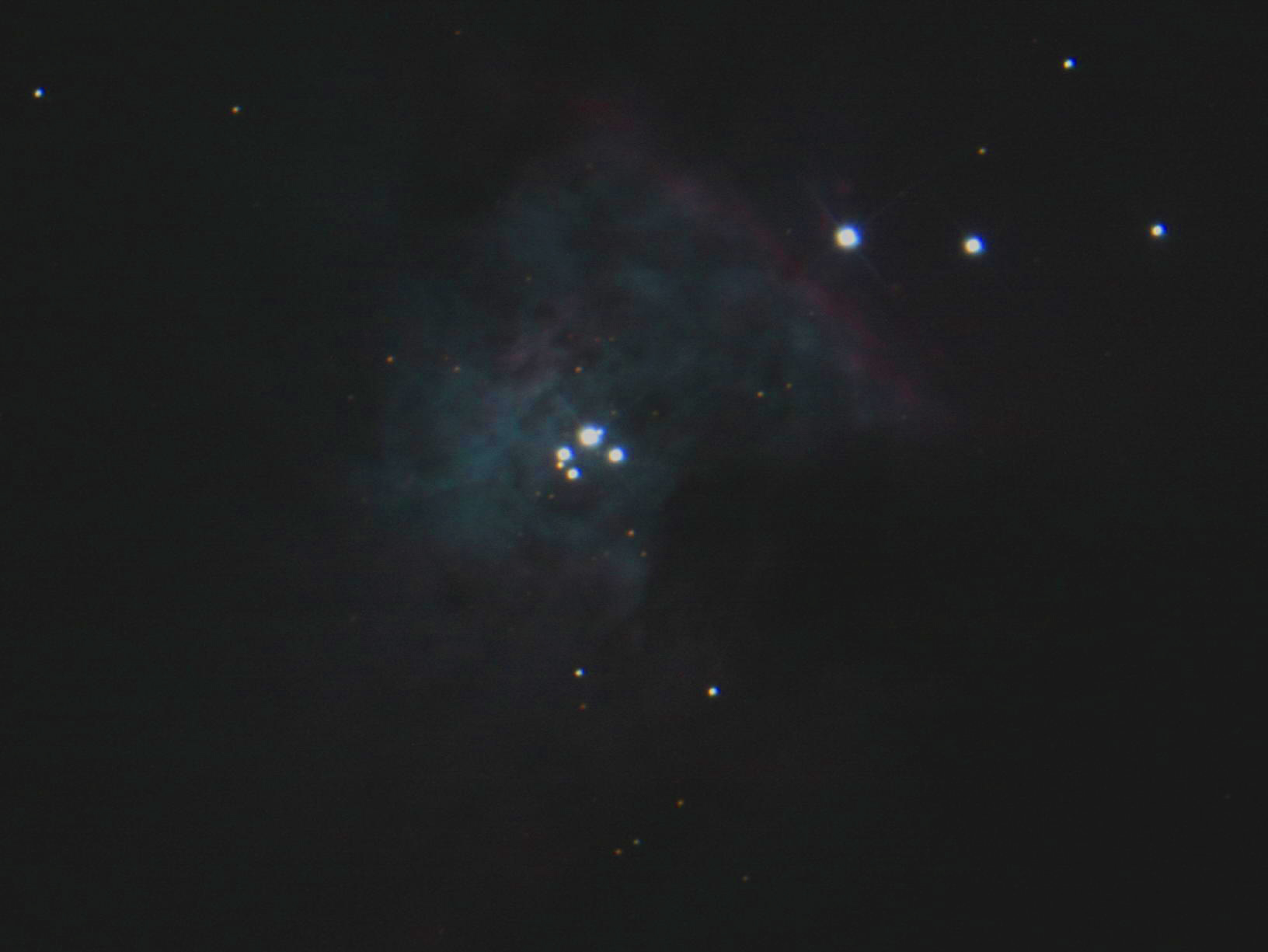
Embedded in the centre of the nebula is a multiple star known as the Trapezium.
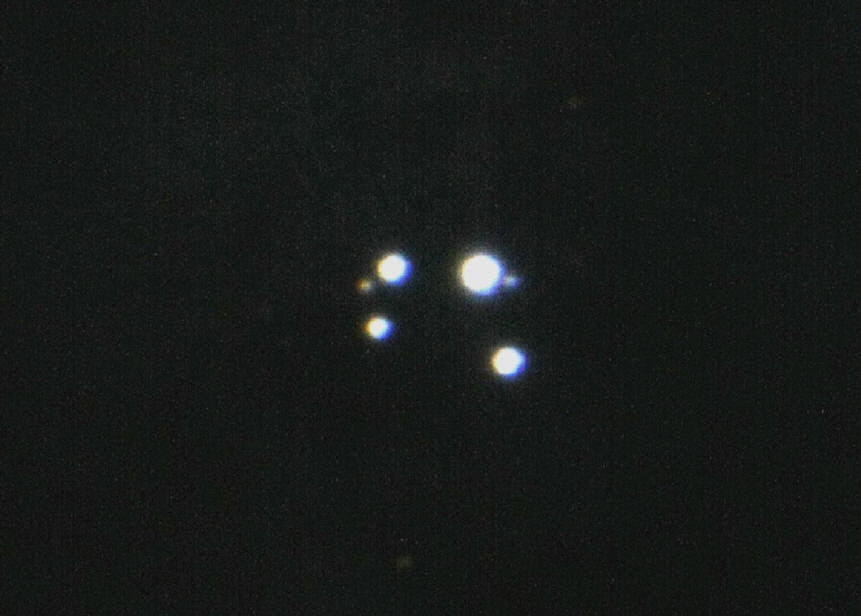
The Trapezium is composed of four bright white stars, two of which are binary stars with fainter
red
companions, giving a total of six. The hazy background is caused by the cloud of fluorescing hydrogen
comprising the nebula.

The spectrum
of Vega, an A0
out of a nebula and are of the same age and stage of evolution.
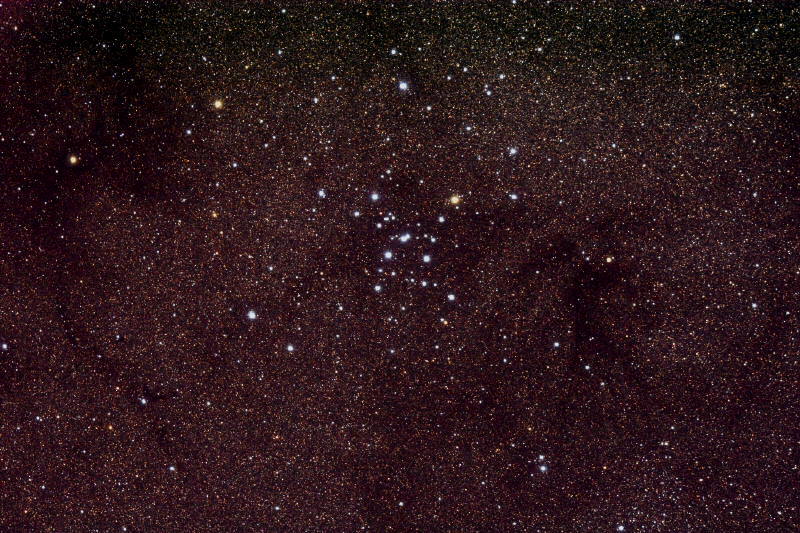
The galactic cluster in Scorpius, M7, is also known as Ptolemy's Cluster.
Ring Nebula - also seen below) are composed of gases such as oxygen and
nitrogen which are fluorescing
from intense stellar radiation from the central
white dwarf star, producing bright-line spectra.
This gives an image of the
circular nebula for each element.
magnitude of 9.7. Photographs taken over a period of 50 years
show the rate of expansion of the nrbula
to be about 1 arcsecond per century, which corresponds to a speed of 20-30 kilometres per second.
M57 is illuminated by a central white
dwarf or ‘planetary nebula nucleus’ (PNN) whose visual magnitude
is 15.75; its mass is approximately 1.2 solar masses. All the interior parts of this nebula have a
blue-
green tinge that is caused to a small extent by the
oxygen emission lines at 495.7 and 500.7 nm. These so-called
‘forbidden lines’ of doubly ionised
oxygen occur only in conditions of very low density where there are only a few atoms per cubic centimetre.
In the outer region of the ring, part of the reddish hue is caused by
the first of the Balmer Series of hydrogen lines. Forbidden lines of ionised nitrogen
( N
reddish colour at wavelengths of 654.8
and 658.3 nm. Each of these emission lines reveals itself as an image
of the
whole nebula. The three brightest ones are easily seen, but there are three more
very faint ones visible.
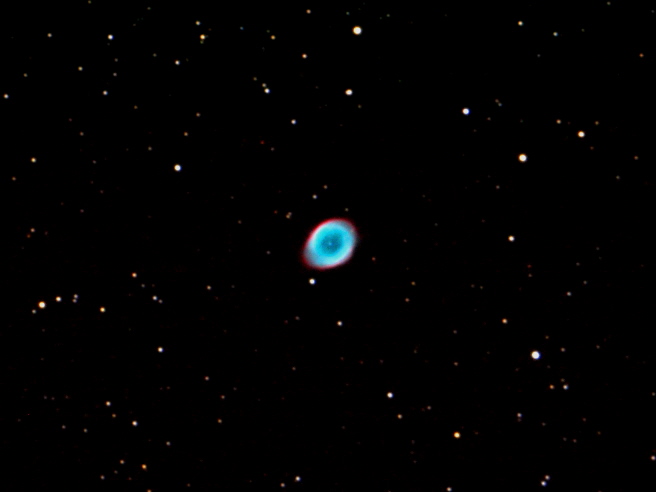
The Ring Nebula, M57, a planetary nebula.
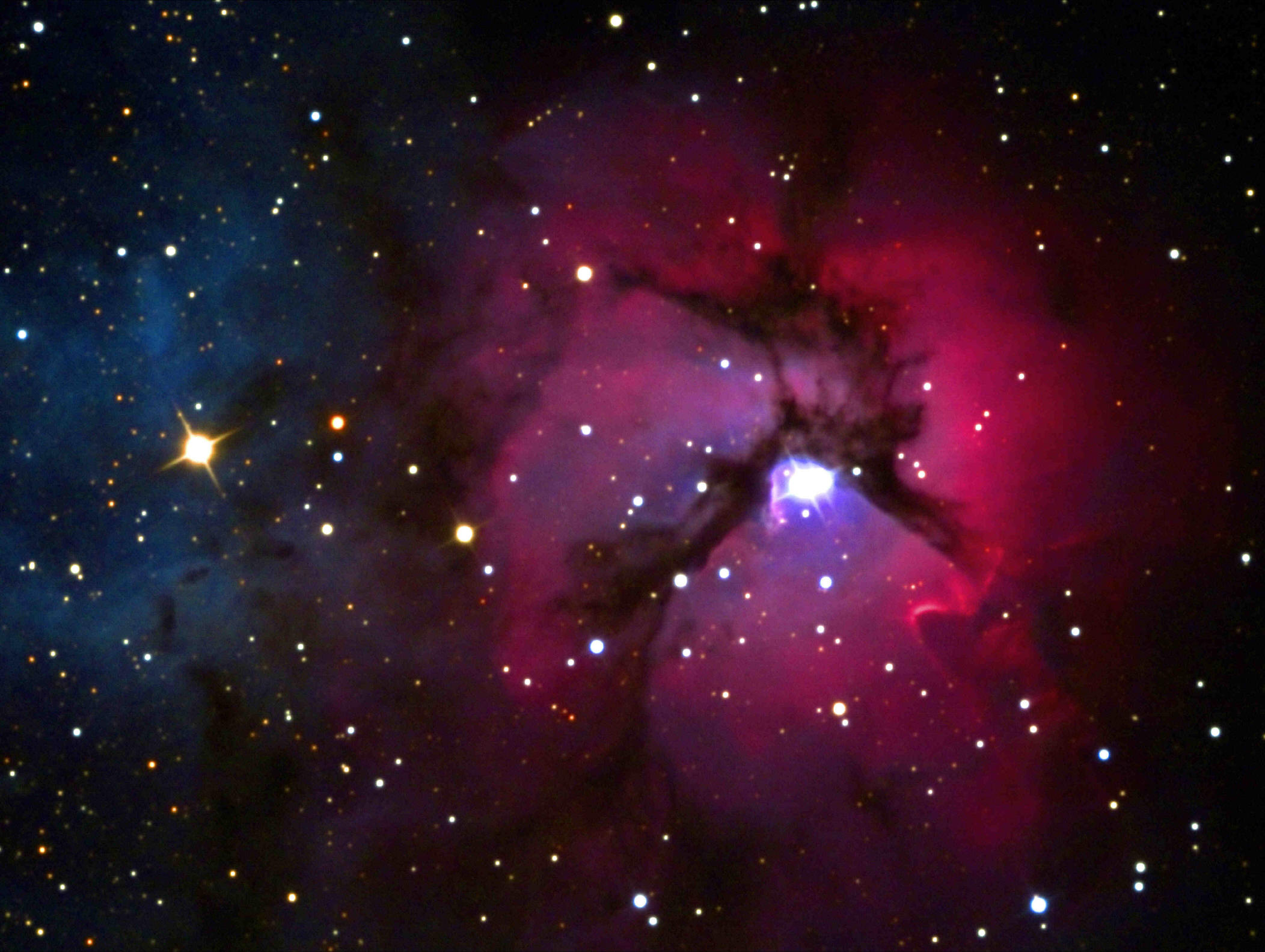
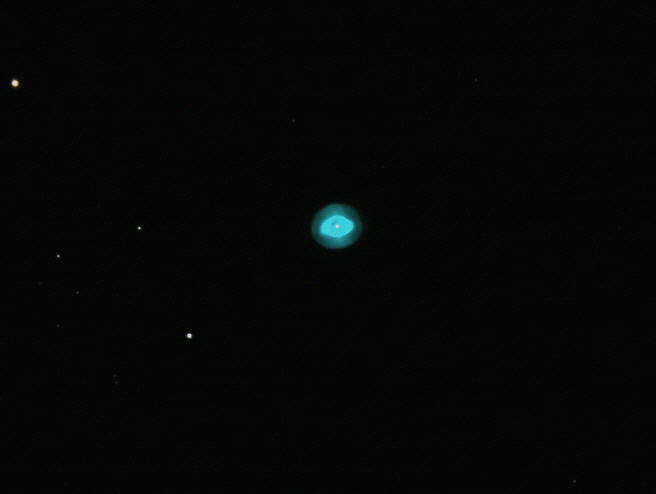
A planetary nebula, the 'Ghost of Jupiter', NGC 3242, formed when the central star exploded.

The 'Wishing Well Cluster', NGC 3532.
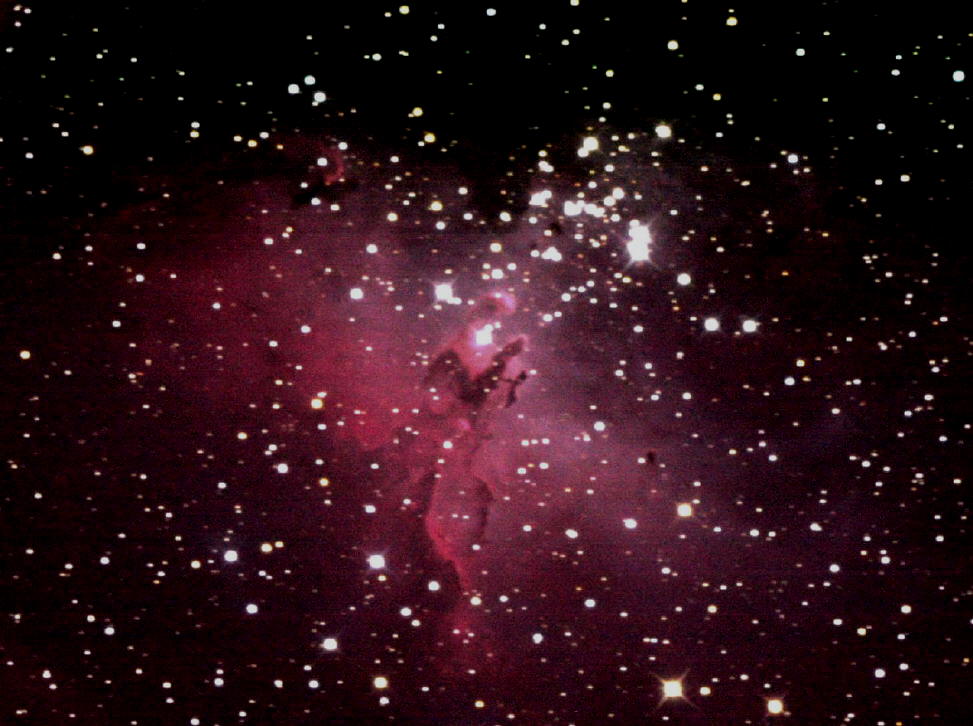
The Eagle Nebula, M16, a star-forming area.
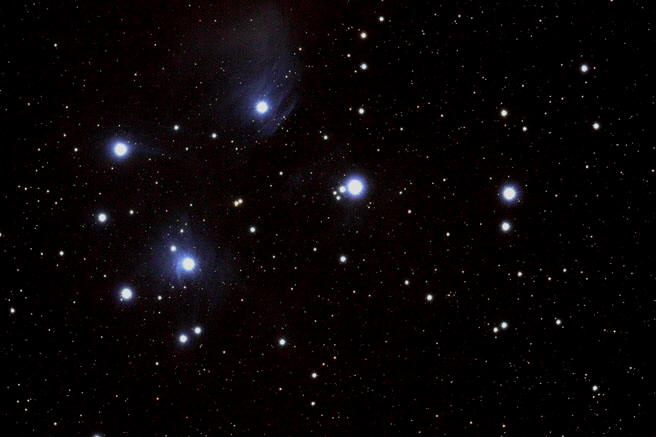
This nebula has almost entirely contracted to form a cluster of new, hot, blue stars. Small amounts of wispy
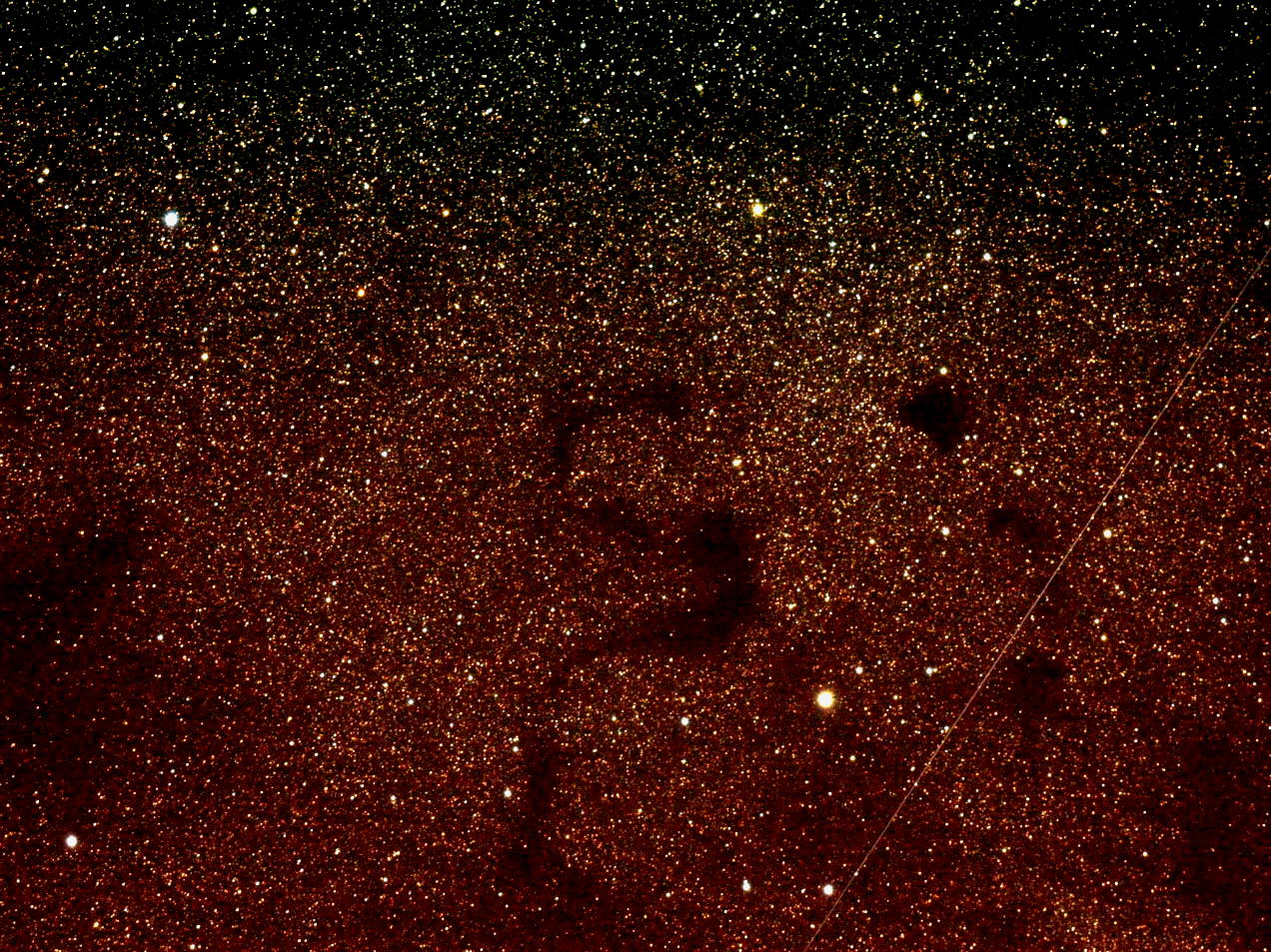
Star clouds in Sagittarius, with the dark Snake Nebula obscuring the stars behind. A satellite trail crosses the image.
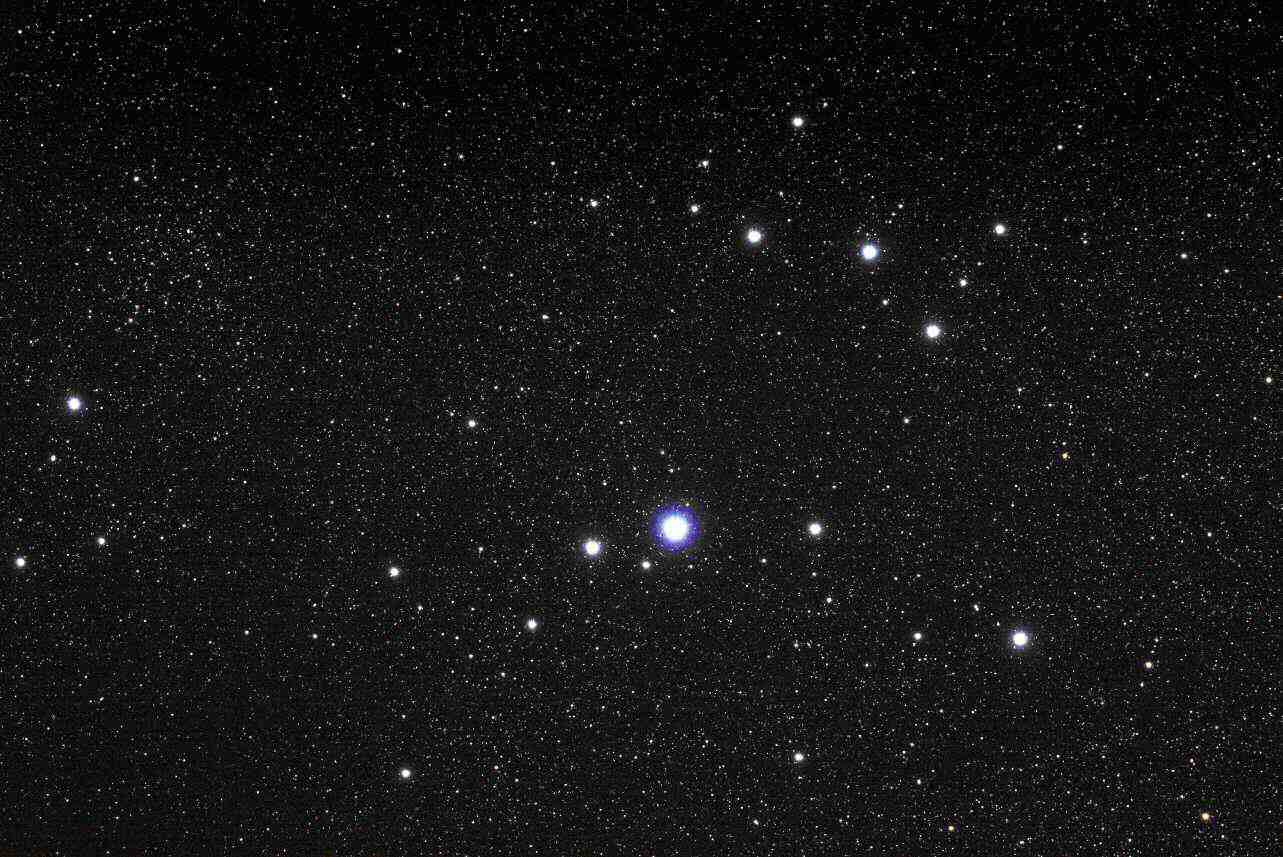
The cluster IC 2602, known as the 'Southern Pleiades'.
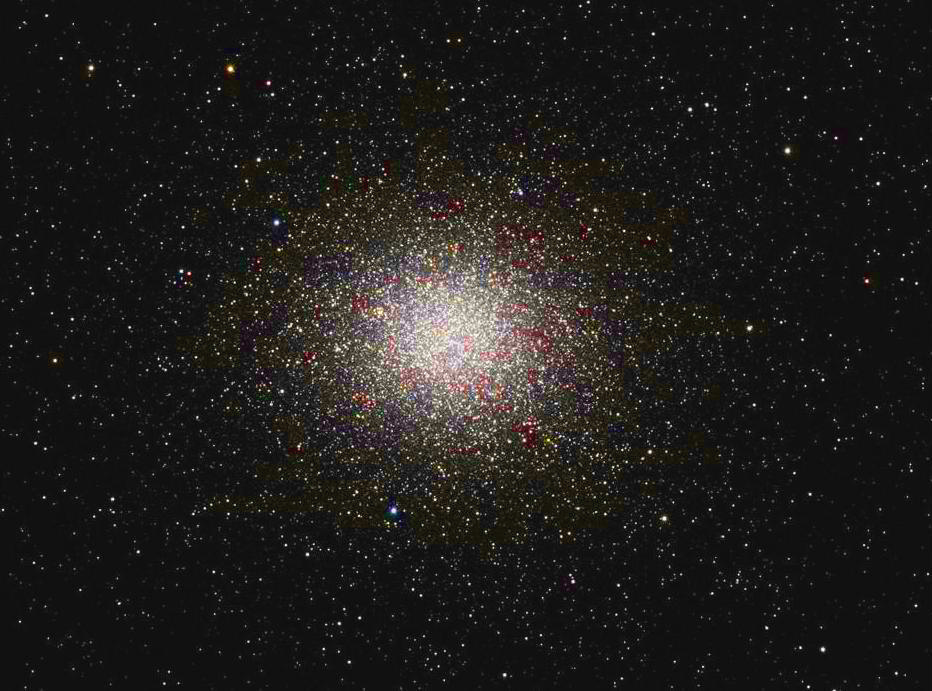

The central core of Omega Centauri
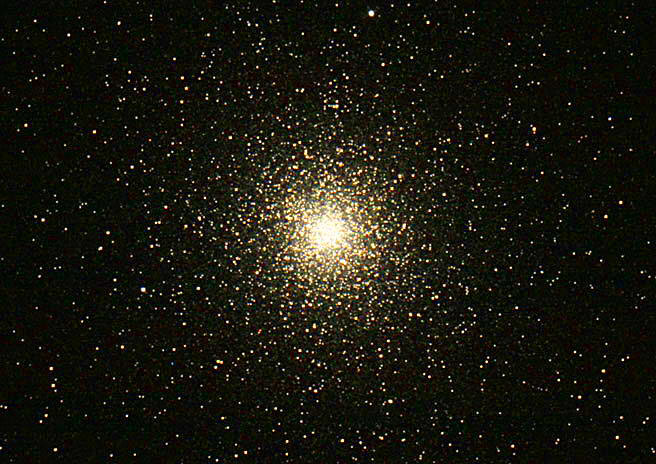
There are over 120 globular clusters like this one, on the outer fringes of our
galaxy. They contain hundreds
of thousands of old stars. This example is named NGC104, but is popularly known as 47 Tucanae.
The globular cluster NGC 6752 in the constellation Pavo.
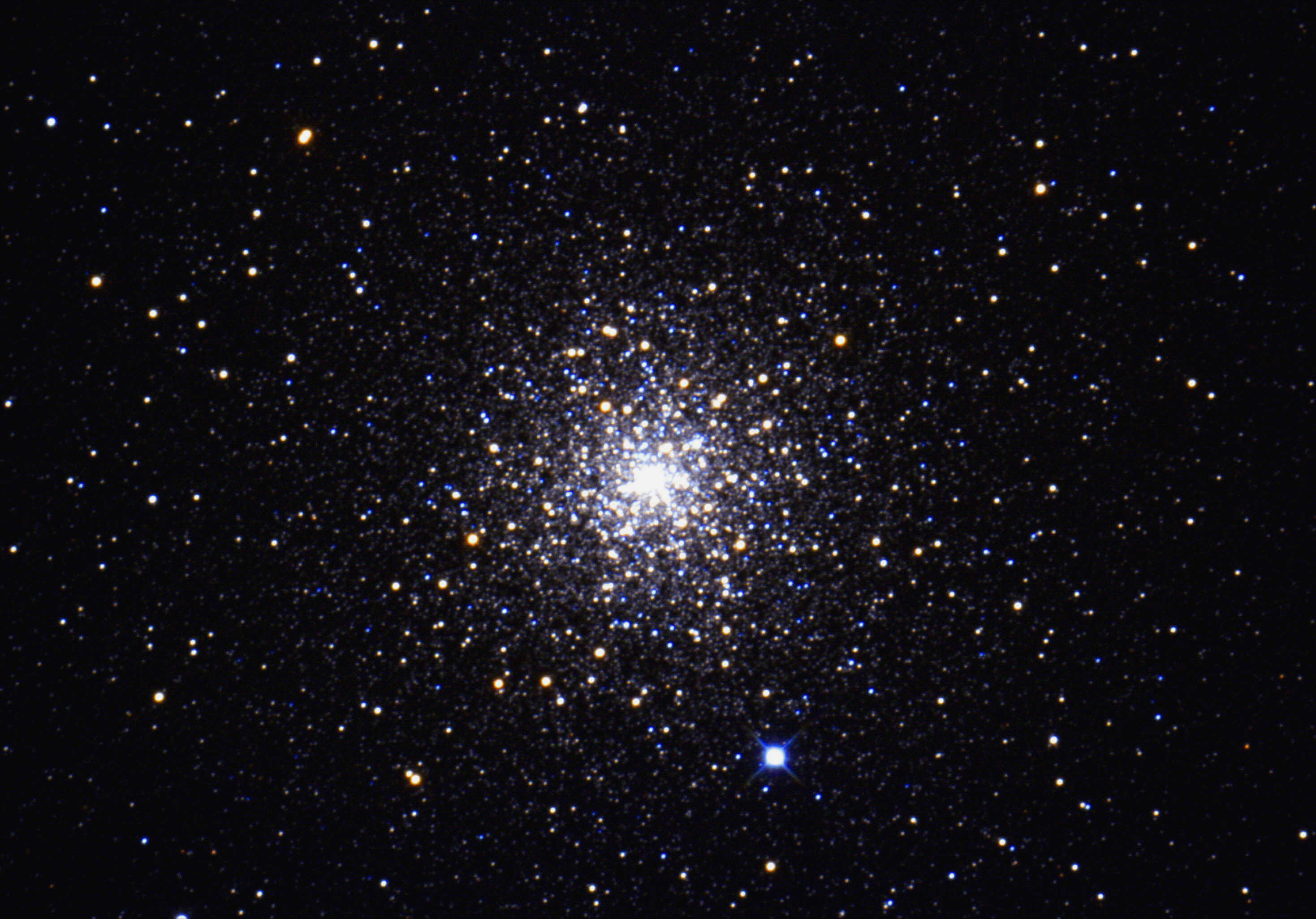
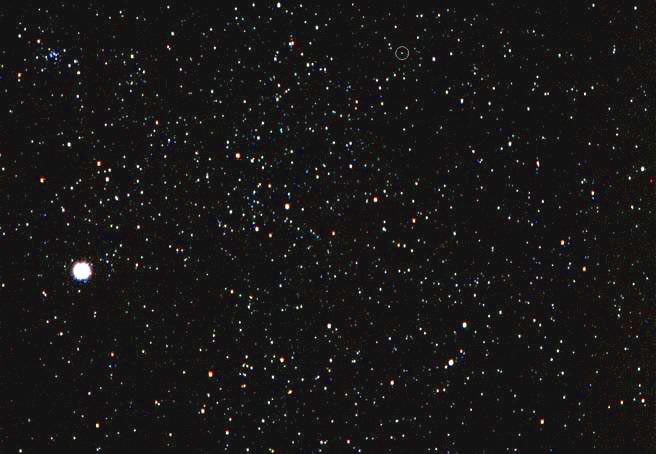
star to the Sun. It orbits the bright binary star Alpha Centauri (at left). 
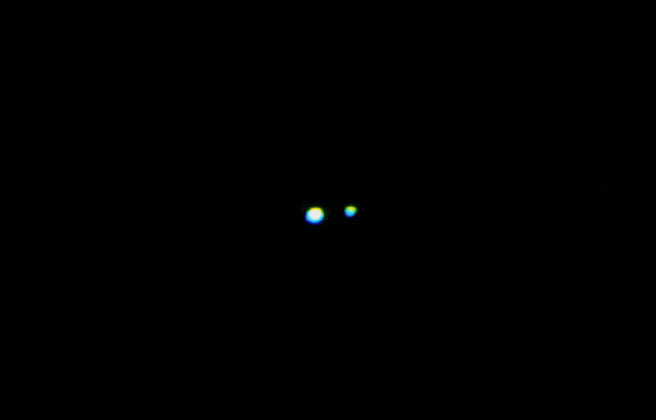
The binary star at the centre of the Alpha Centauri triple system. Both stars are solar types.
The binary star Albireo (Beta Cygni), which is well known for its colour contrast.
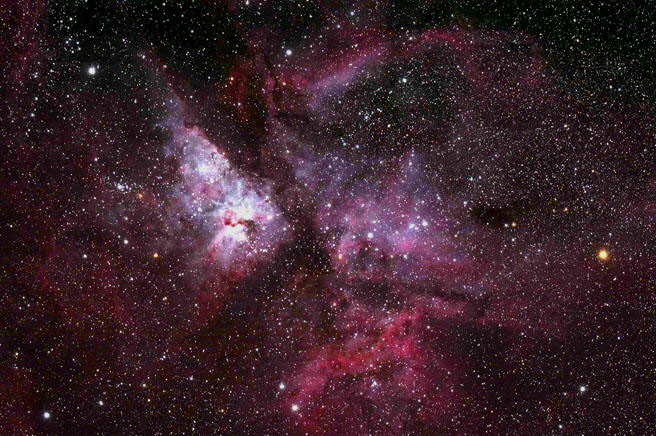
of fluorescing hydrogen 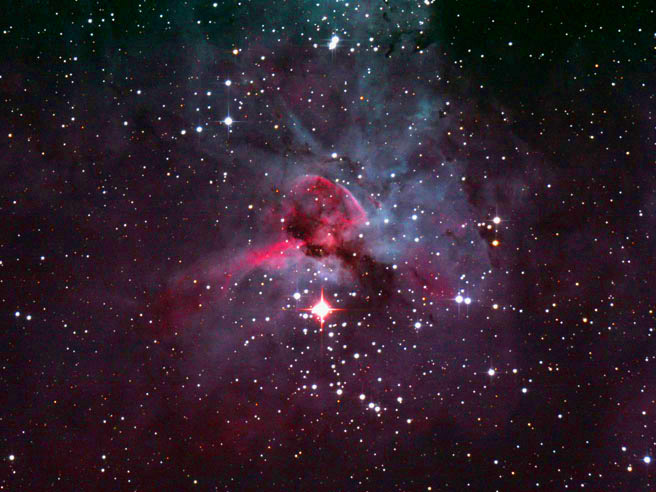
The Keyhole, a dark cloud obscuring part of the Eta Carinae Nebula
The Homunculus, a tiny planetary nebula ejected by the eruptive variable star, Eta Carinae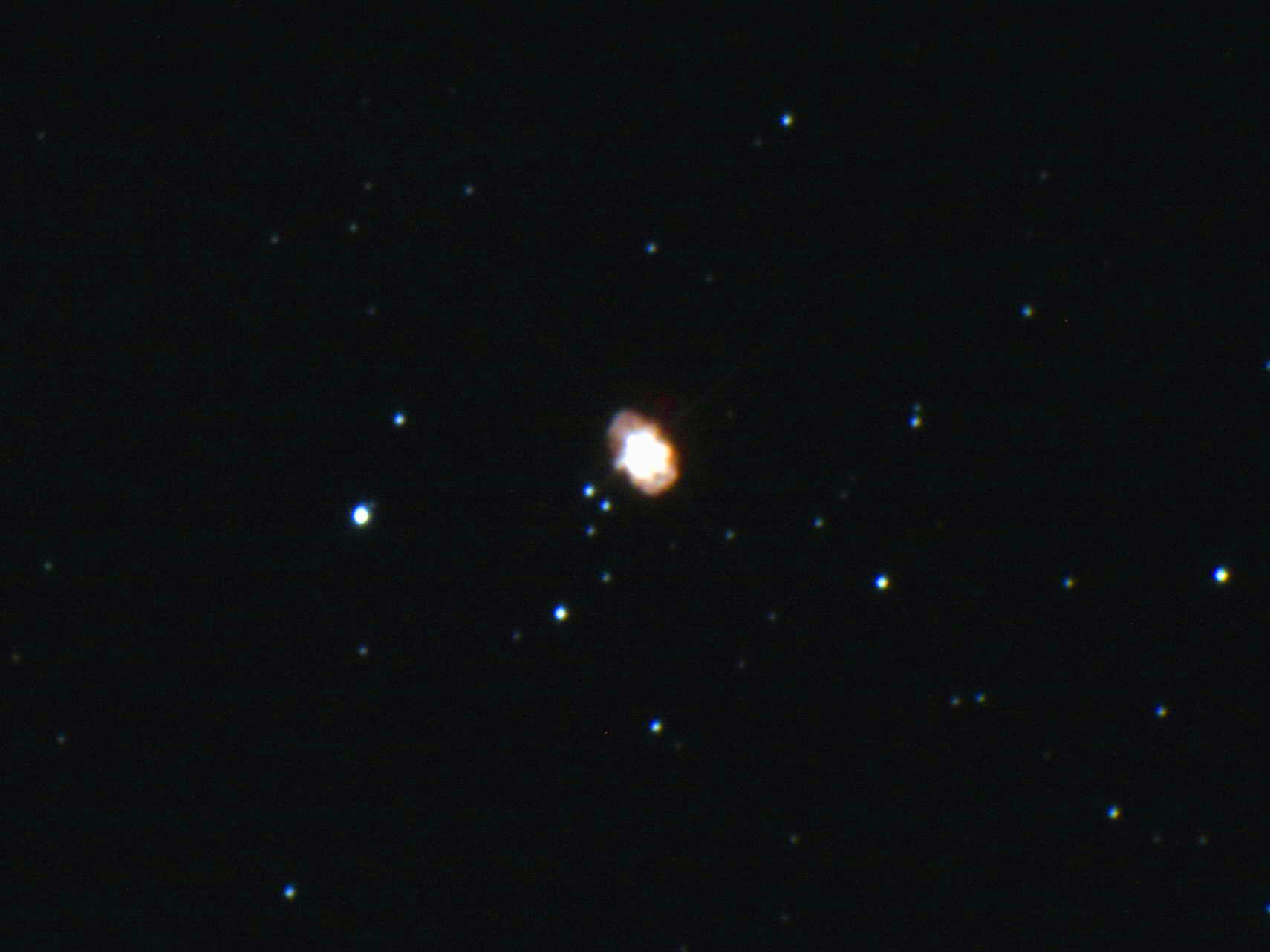
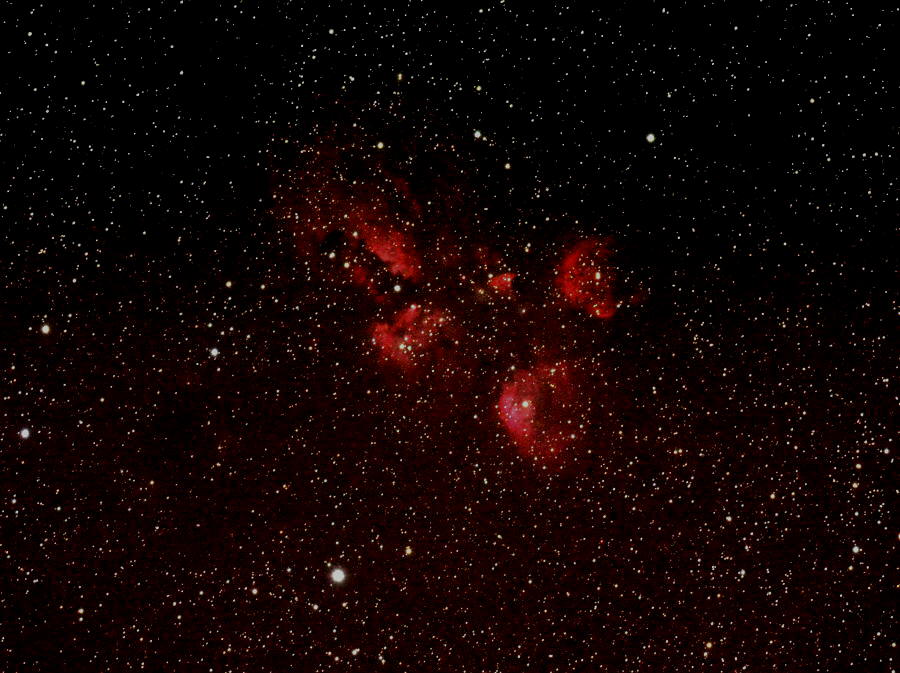
The Cat's Paw Nebula
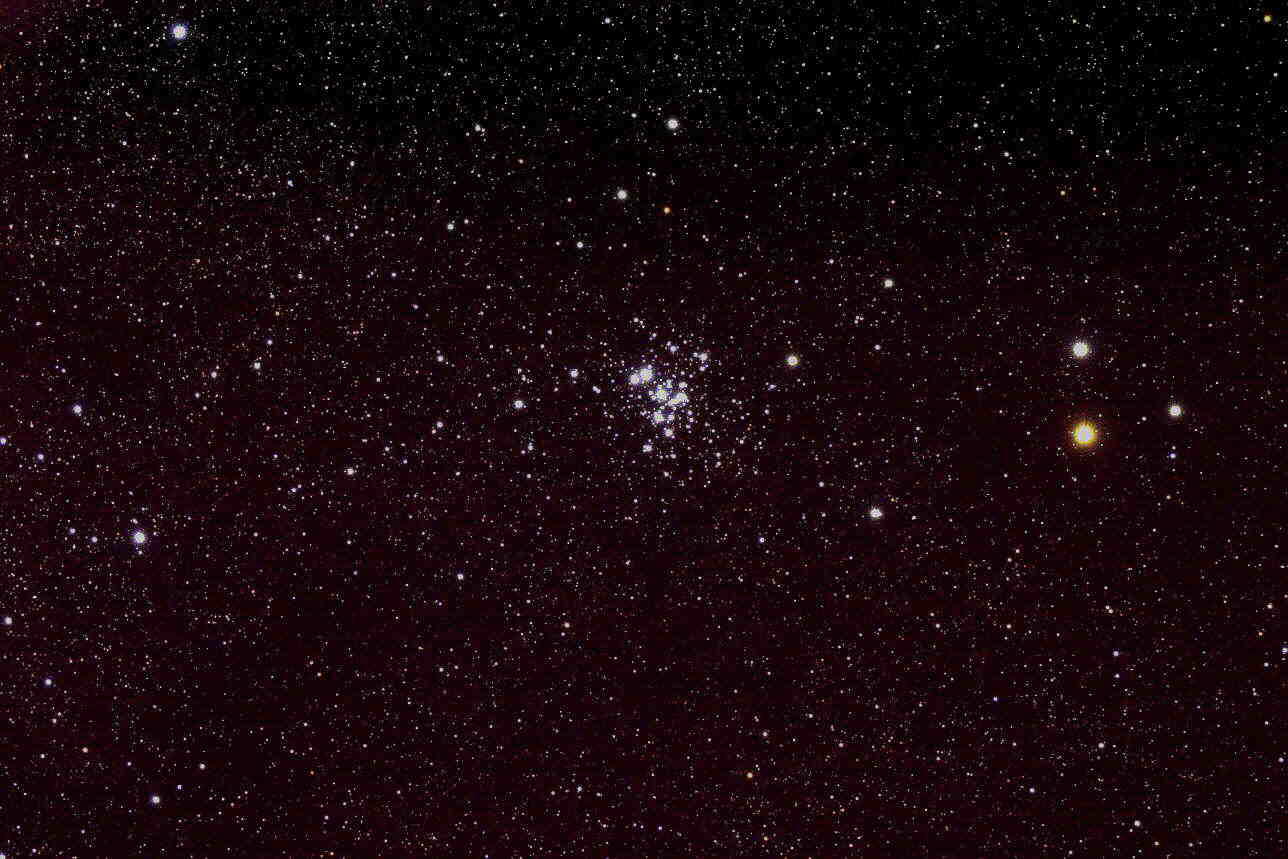
The star Zeta Scorpii and the open cluster Caldwell 76.

The Dumbbell Nebula, M27
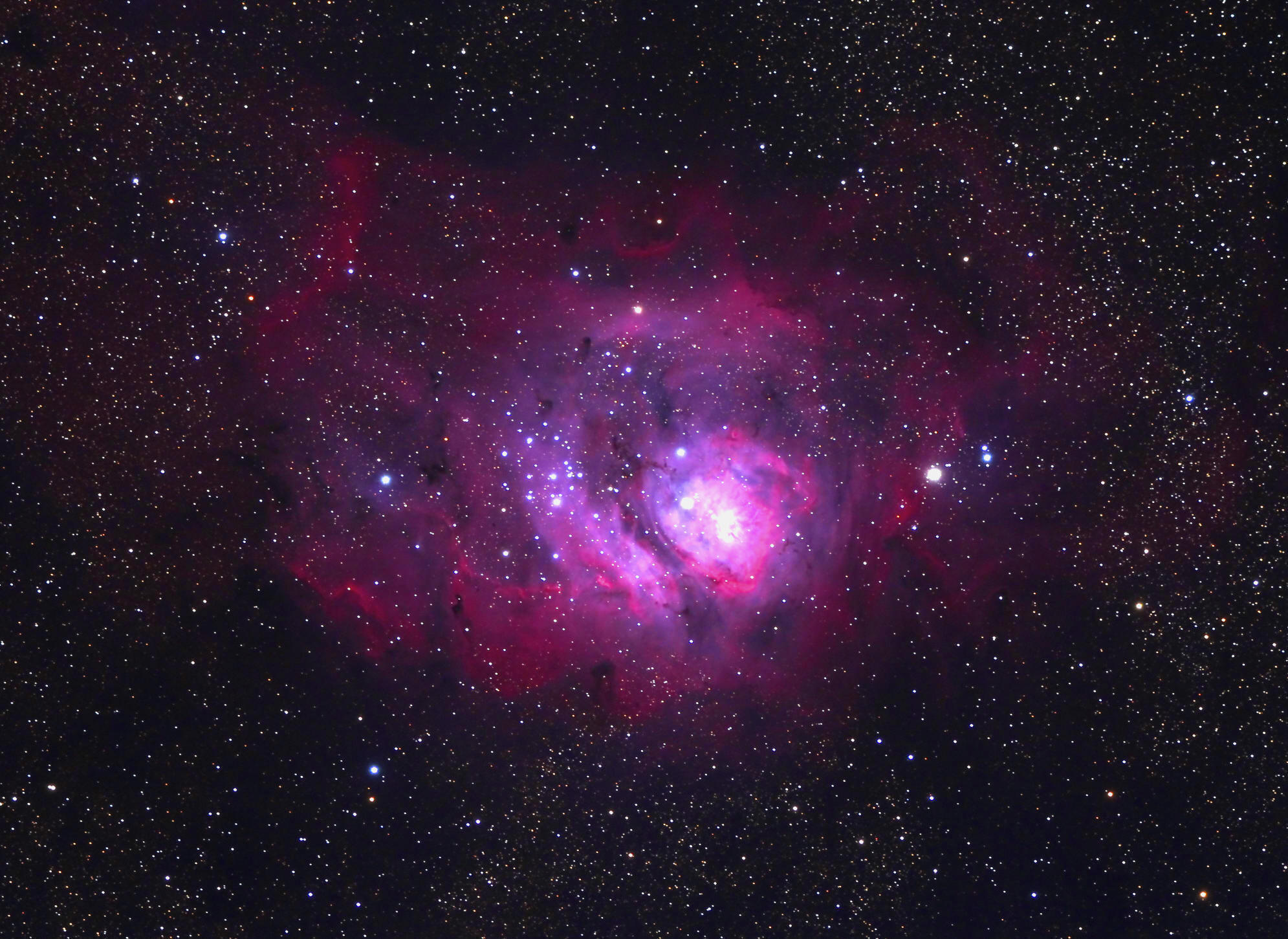
The centre of the Lagoon Nebula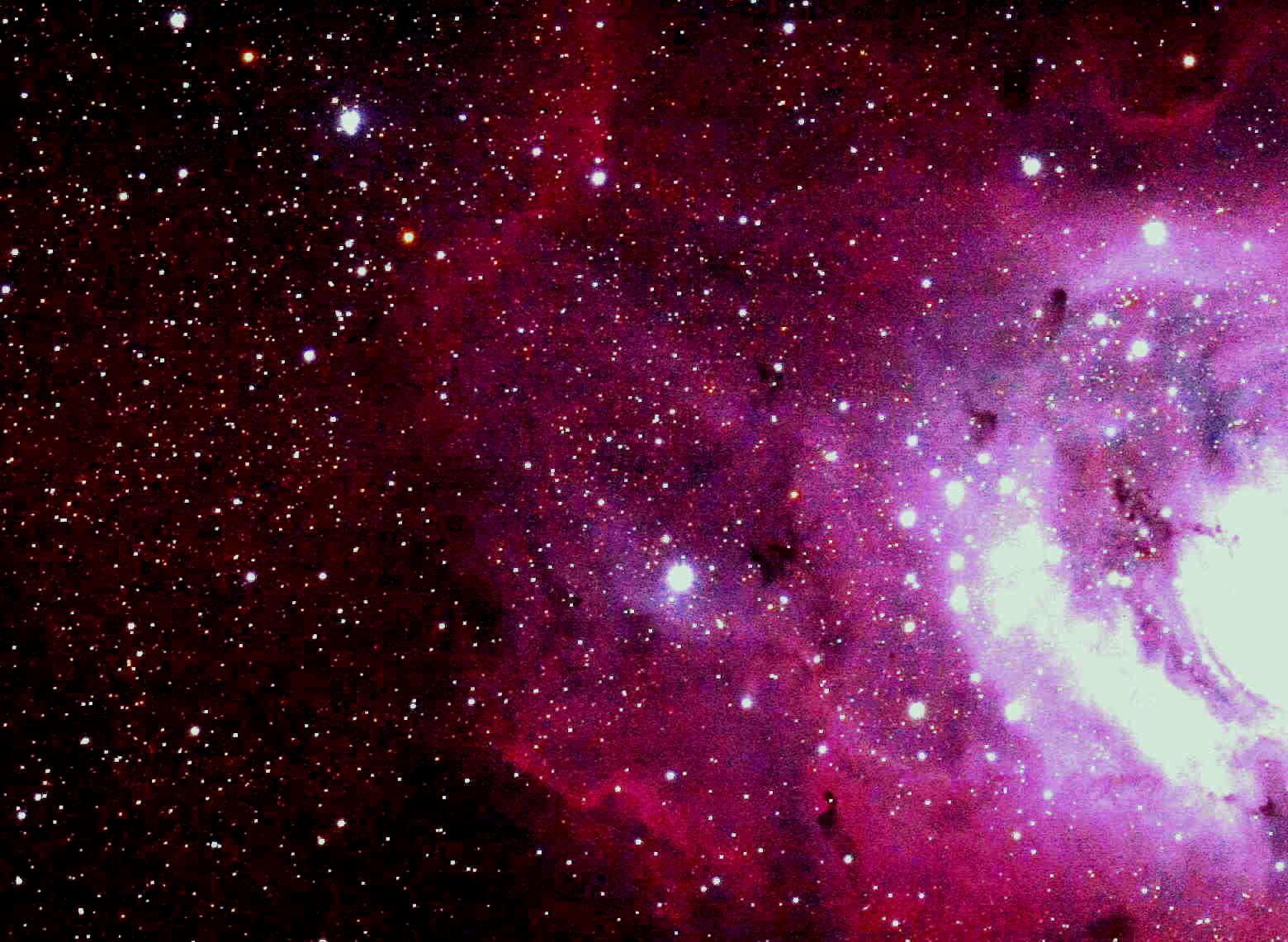

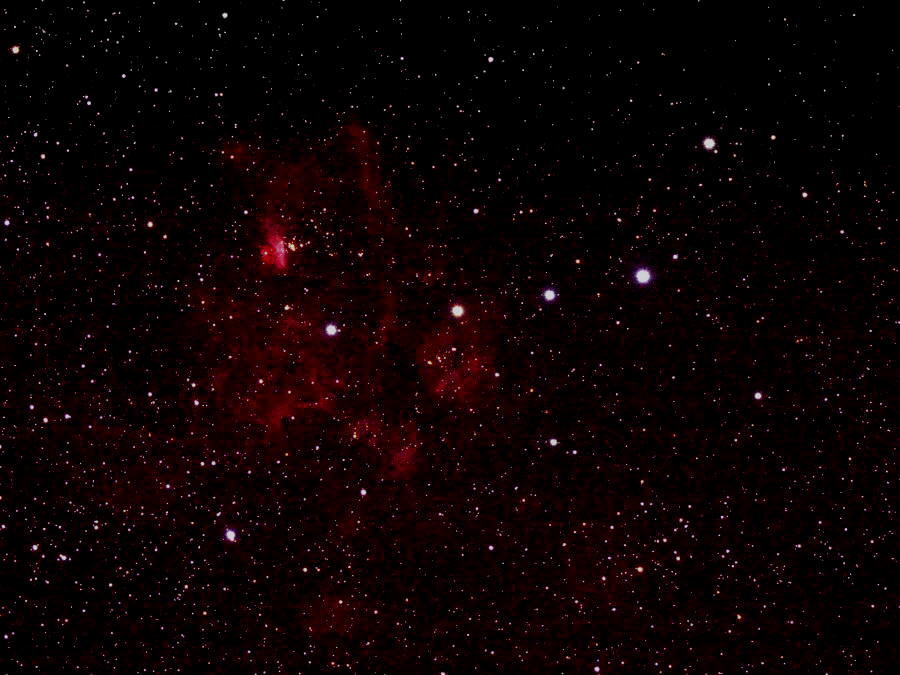
Nebulosity in Scorpius.
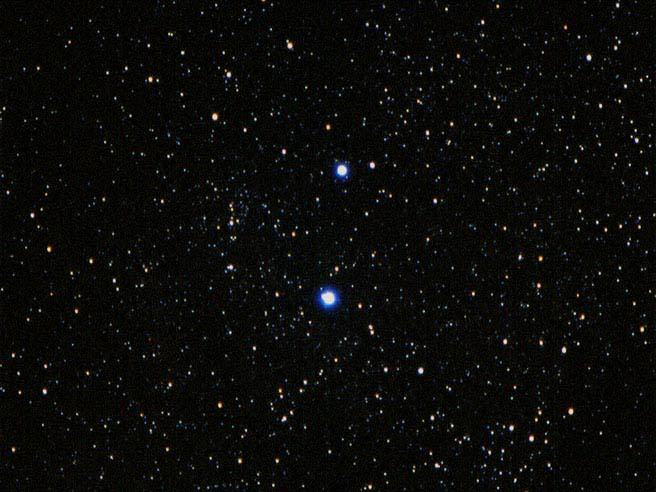
The two bright stars at centre form the sting of the Scorpion's tail. Their names are Shaula and Lesath.
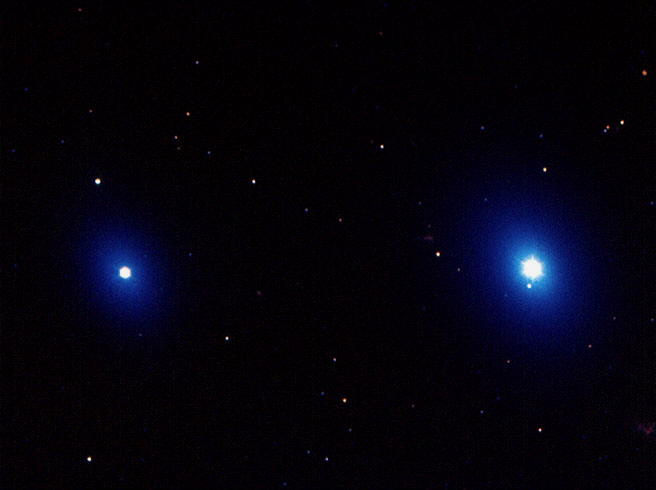
Shaula and Lesath are both hot, blue B type stars.
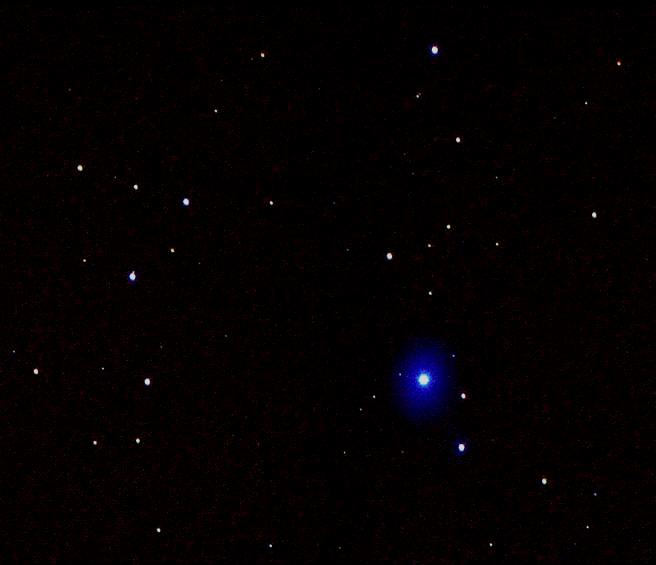
This cluster of new, hot B type stars surrounds the star Theta Carinae, and is sometimes called the
'Southern
Pleiades'.
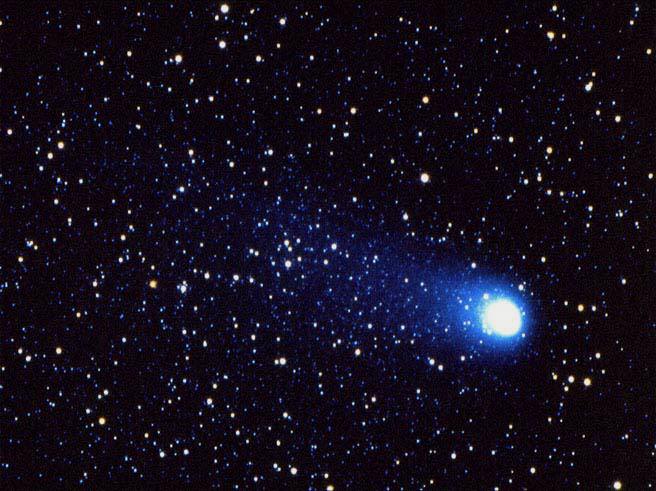
Halley's Comet, photographed as it passed in front of the stars of Scorpius in April, 1986.

The Great Spiral M33 in Triangulum.
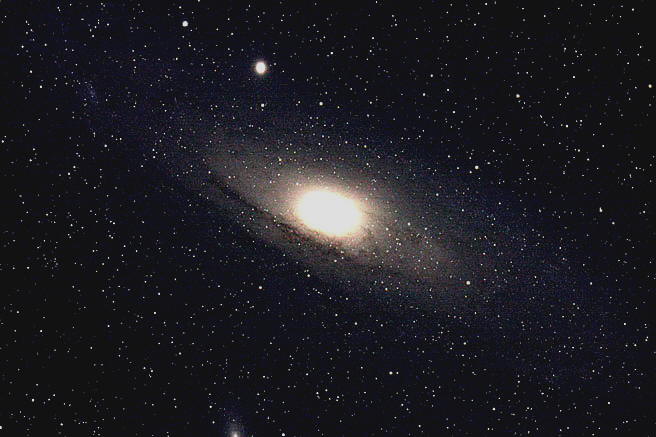
The Great Galaxy in Andromeda, M31, photographed at Starfield Observatory with an off-the-shelf digital
camera on 16 November 2007.

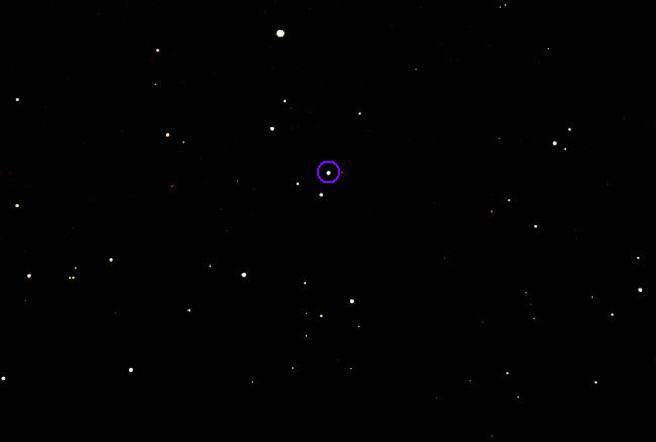
one sixth of the way to the edge of
the universe. It is 1000 times further away than the Andromeda Galaxy
shown above.